
FEATURING: TYLER GORDON
T.W.FIVE
VALLEY
KITAMURA DISCOVER
|
|
WOLF | TAKI
Silicon Valley’s Innovative and Creative Culture ISSUE 13.1 Winter 2020 C
HUMAN SHAPED ANIMAL Artist Rachel Barnes
C
CONTENT MAGAZINE, SAN JOSE $14.95

ISSUE 13.1
“Discover”
Winter 2020
Cultivator
Daniel Garcia
Editors
Elizabeth Sullivan, Linnea Fleming
Grace Olivieri, Samantha Tack
Design
Dana Seeger
Interns
Jesse Garcia
Community Partnerships & Producer
Kristen Pfund
Photographers
John Agcaoili, Peter Salcido
Sannie Celeridad, Milan Loiacono
Writers
Nathan Zanon, Esther Young
Johanna Hickle, Grace Talice Lee
David Ma, Brandon Roos, Yori Seeger
Diane Solomon, Albert Jenkins
Demone Carter, Taran Escobar-Ausman
Albert Jenkins, Michelle Runde
Publisher
SVCREATES
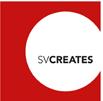
Discovery is the seeker’s path, the adventurer’s trail, rarely satisfied by those driven by an appetite for the new or novel. A real discovery finds contentment when seasoned with contemplation. Our culture’s obsession with the latest trend, gadget, or experience so often merely feeds restlessness rather than discovery. In this issue, we have compiled creatives who have been on a journey to find their voices. As you read these stories, we hope you will find the themes in their discovery process that will refine your life journey as you marry contemplation with curiosity. We do desire to expose you to new artists, new works, and new experiences, not merely for entrainment but also for your enrichment. We want you to discover a way to connect, engage, and to support your journey and the journey of those presented. Here’s to the curious, to the adventurous, to the seeker—may you discover.
Thank you, Daniel Garcia THE
CULTIVATOR
To participate in CONTENT MAGAZINE: daniel@content-magazine.com Membership & sponsorship information available by contacting editor@content-magazine.com
501(c)(3)
CONTENT
THIS ISSUE
| Janice Lobo Sapigao | Recovery Cafe | Taki Kitamura CONTENT MAGAZINE is a quarterly publication about the innovative and creative culture of Silicon Valley, published by .
IN
t.w.five
C
CREATE : CONNECT : SAN JOSE

Labor of Our Fruit, 2020
Artist: Patrick Hofmeister
The Honeybee parallels the story of the immigrant. Not native to California, the Honeybee was introduced to San José, and thereby California, by Christopher A. Shelton in March 1853. The Honeybee catalyzed California agriculture, and proved how invaluable immigrants, no matter their size, stature, or from where they come, can revolutionize the world for the better. The sixstory, 4000-square-foot mural Labor of Our Fruit by artist Patrick Hofmeister at the 3rd Street Parking Garage in Downtown San José (25 S. 3rd Street) magnifies one of our smallest immigrants to the grand status it deserves and honors this key contributor to the food web and our survival.

www.sanjoseculture.org
This mural was commissioned by the City of San José Office of Cultural Affairs and the City’s Department of Transportation’s Parking & Downtown Operations Division in partnership with the San José Downtown Association, Local Color and Harvest Properties.
CONTENT
DISCOVER 13.1
Winter 2020 San Jose, California
CULTURE
8 Art Business and COVID-19, Yori Seeger

12 Recovery Cafe, Lisa Willmes, Diana Carreras & Tadashi Oguchi
ART & DESIGN
18 Designer, Artist, & Art Director, Anne To
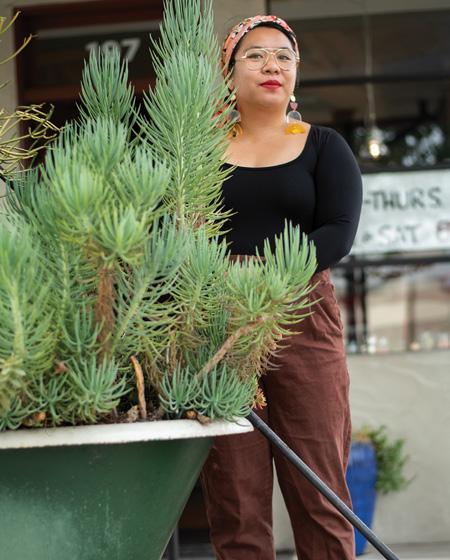
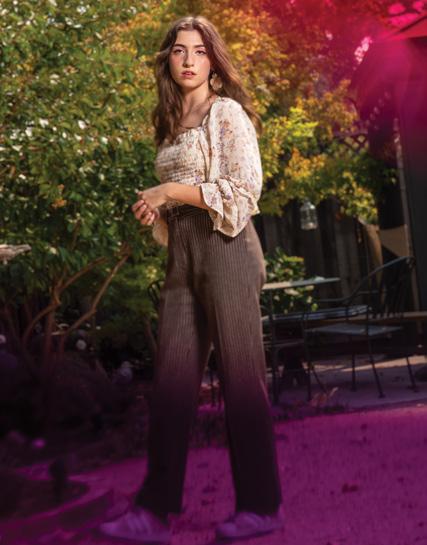
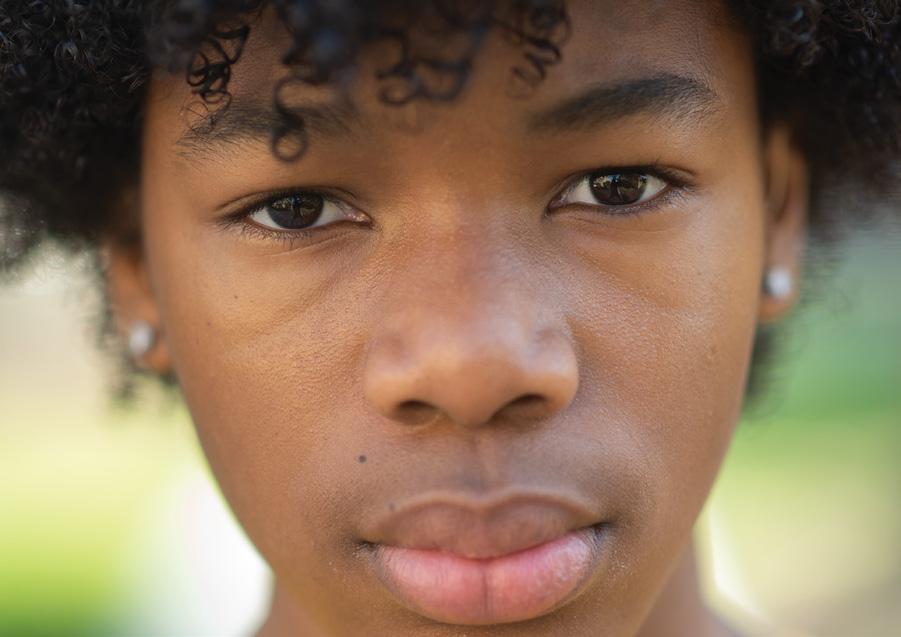
22 Interdisciplinary Artists, Isaac S. Lewin
26 Teen Painter, Tyler Gordon
32 Human Shaped Animal, Rachel Barnes
36 Tattoo Artist, Taki Kitamura
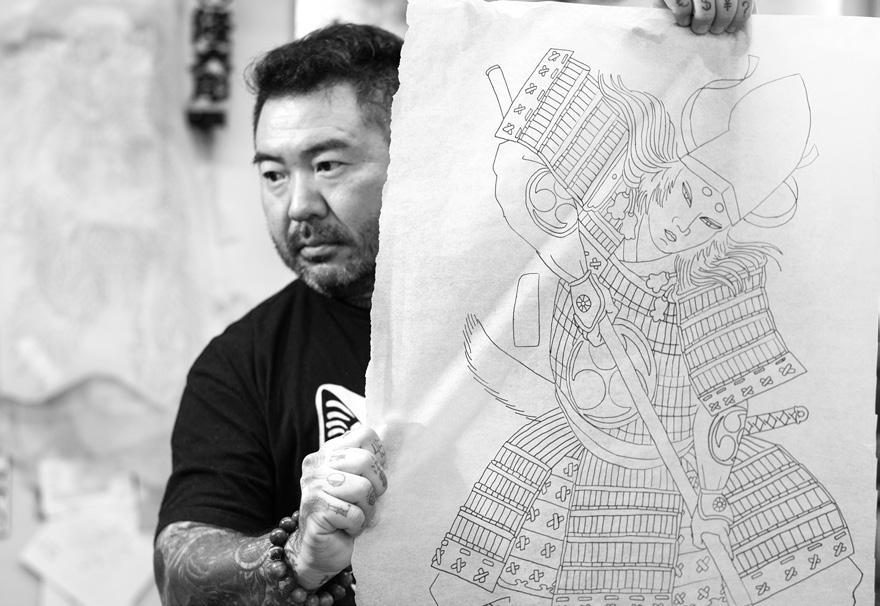
42 Collaborative Artist Duo, t.w.five
STYLE
50 Designer, Ivan Torres
WORDS & MUSIC
56 Poet, Janice Lobo Sapigao
62 Planttvibes, Julia Bozzo
66 Valley Wolf, Victor Alvarado, Fernando Barocio, Andrew Mendoza & Jairo Lomeli
70 Album Pick, Needle to the Groove
72 Contributors
All materials in CONTENT MAGAZINE are protected by United States copyright law and may not be reproduced, distributed, transmitted, displayed, published, broadcast, or modified in any way without the prior written consent of Silicon Valley Creates, or in the case of third party materials, the owner of that content. You may not alter or remove any trademark, copyright or other notice from copies of this content. For further information, or to participate in the production or distribution, please contact us at editor@content-magazine.com
CONTENT magazine’s production is powered by
Taki Kitamura, pg. 36
Julia Bozzo , pg. 62
Tyler Gordon, pg. 26
Janice Lobo Sapigao, pg. 56
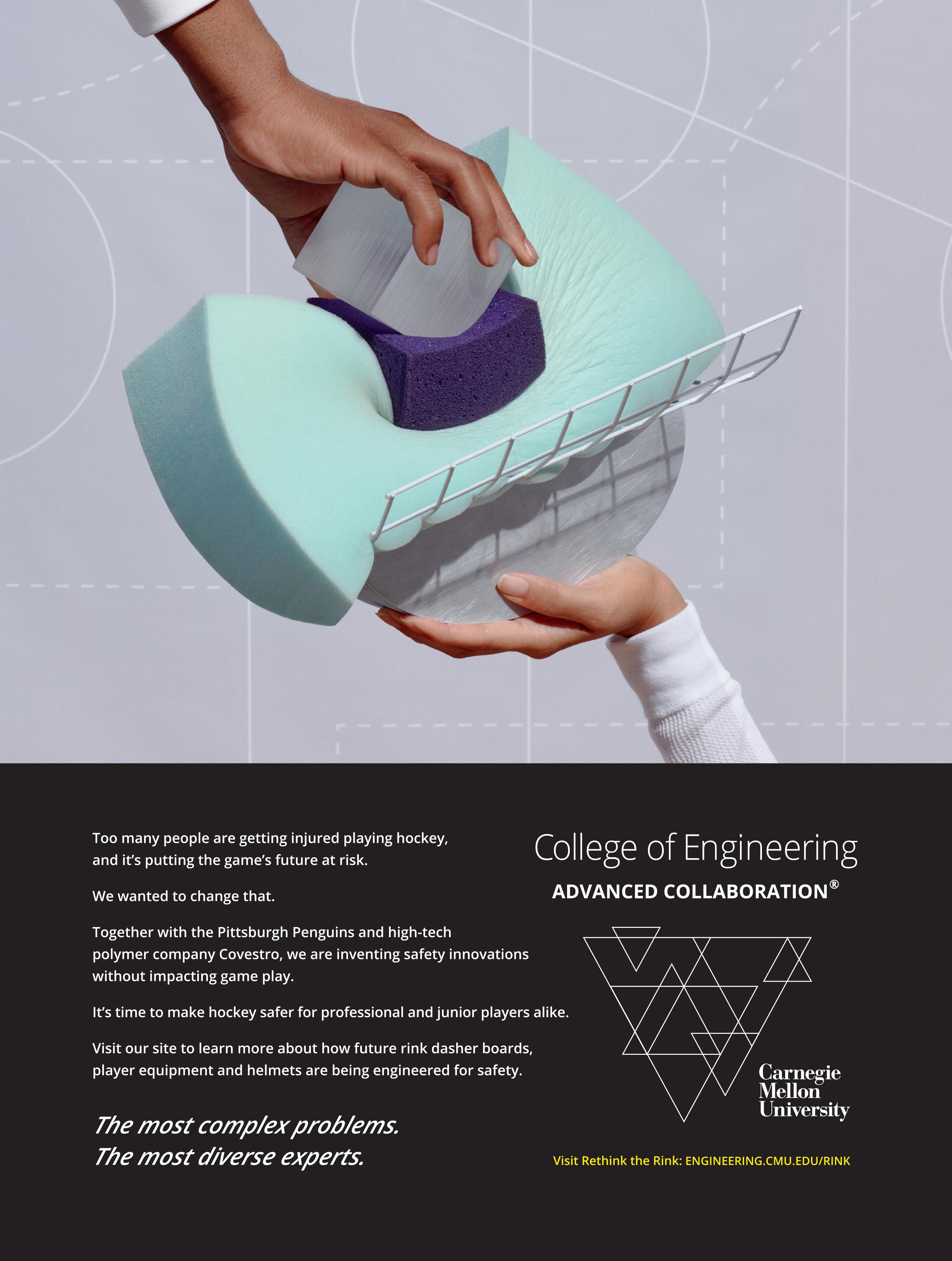
Art.Business
and COVID
DESIGN A BUSINESS PLAN for a mom and pop shop. Throw in all the extras, goodies, and toppings, like locally sourced content, community building, local economy boosting, and anything else that sounds good. Do not be shy, put it all in there. In fact, build your dream business. Have you got it in your head? OK, now take this business plan and put it in a blender. Throw in some COVID-19, a dash of uncertainty, maybe a teaspoon of stress. While you’re at it, add some lightning, unprecedented wildfires, smoke-filled air, evacuations, and record-breaking heat waves. If I really have you in a mood, throw in a pinch of political tension with AB 5 and upcoming elections. For good measure, add a few cups of economic stress.
Yeah…so, this has been a crazy year, and it is hardly halfway through. I am just glad the Mayan calendar ended in 2012 instead of 2020. I am not sure if I could deal with Armageddon right now. My wife, Dana, and I are the cofounders of a

local business. It is a mom-andpop-shop adventure, an art hub in San Jose called Visual Philosophy. Our business, which we started in 2013, is a school and an artist incubator on The Alameda. This is the third San Jose business—spanning four generations—in my family. My great grandfather had a car dealership on San Carlos Avenue, and my grandfather sold motorcycles in the ’60s, a few blocks from our current location. Like so many businesses, we have been drastically impacted by COVID. In effect, our business as we knew it ceased. I sometimes feel like I need Captain Jack Sparrow’s magic compass to help navigate the ever-changing tides, as our authorities implement and recant rules and guidelines for doing business within the fog of COVID. That is not meant to pass judgment. I recognize the challenges our city faces while they juggle the safety of our communities and the ever-slowing trickle of our economic stream. For most businesses, including ours, the shelter-in-place order
was like a shot from a starter pis tol, and we scrambled into a new world of Zoom, online fatigue, and social anxiety.
Tragedies and stressful envi ronments bring out the best and the worst in us. Amidst the chaos and anxiety, I have been lucky to witness the good in people. You should know about the efforts that might otherwise go unseen, even if their campaigns are suc cessful. They work behind the curtains and do not ask for the spotlight. Which, honestly, is why they deserve it.
Dana and I were asked to join a task force called the Greater Downtown San Jose Economic Recovery Task Force. The group was put together by District 3 Councilmember Raul Peralez and his office. The goal of the task force was to brainstorm ideas on how to keep the econ omy running in the downtown and adjacent area of San Jose, and our contribution was to focus on arts and entertainment groups—the lifeblood of our city. Arts and entertainment support cultural identity and commu
8 Discover 13.1
Written by Yori Seeger
Illustration by Dana Seeger

media
9
schoolofvisualphilosophy.com Social media schoolofvp sjartsadvocates.org Social
sanjosearts
10 Discover 13.1
- Yori Seeger
“Artists and arts organization have a larger impact on social behavior and well-being than most citizens realize.”
nity involvement. Art-related businesses contributed over 800 billion dollars to the economy in 2019. It is the unseen current that directs economic flow in every major metropolis. The unsung heroes working behind the scenes have more effect on your life than you may realize. We have fostered the term “second responders” for the arts, because I believe art has the potential to educate and stimulate, both of which are greatly needed right now. If our task force can figure out how to run arts and entertainment businesses in the city, everything else will follow. And so we developed a campaign called Safely Social San Jose. Through local artists, art groups, and creative leaders, the campaign will aim to help our businesses develop new and appropriate methods of operating within the pandemic. Essentially, we need to recognize our social habits and strategically learn a new social dance, with the final outcome being to establish the confidence that businesses with the Safely Social logo are indeed safe places to visit. This will stimulate the economy while providing you, our citizens, a step towards sustainable recovery. Look for the Safely Social San Jose campaign
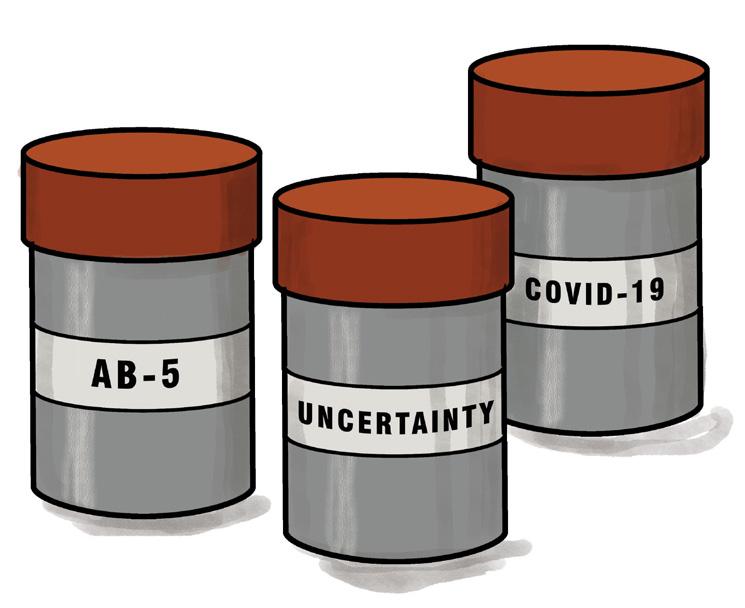
as you begin to venture back out into a nonvirtual world.
The task force has provided an opportunity for Dana and me to use our business and help our city. We have connected with some amazing community arts groups and leaders. The amount of work that has been done behind the scenes to benefit our city is immense. I would like to publicly give a heartfelt thank you to Susan Sayre Batton of San Jose Museum of Art, Daniel Garcia of Content Magazine, Dana Seeger of Visual Philosophy, Brendan Rawson of San Jose Jazz, Amanda Tello Rawson of Art Builds Community, Wisa Uemura of San Jose Taiko, Nick Nichols of Symphony Silicon Valley, Trami Cron of Chopsticks Alley, Chris Esparza of Giant Creative, and Fil Maresca of Filco Events. These groups are banding together on your behalf. If you are unfamiliar with any of these names or organizations, I suggest you look them up. I am proud of the community and business that Dana and I have created. Our network of studio artists, students, teachers, and art lovers have banded together and are weathering this COVID storm as a community. A friend of ours once likened the business to a child, and she commented that it had now become an adolescent. It is time to let it go out in the world, even if it makes a few mistakes along the way. I am a proud father of my little business. I am hopeful that these turbulent times will bring us closer together and make us stronger.
The second group that needs a shout out at this time is a new nonprofit called San Jose Arts Advocates. Are you concerned about AB 5 or the upcoming elections? What about the Transit Occupancy Tax and how it will be affected by the city deficit in this time of pandemic? How are we moving forward with art in schools and on Zoom? The San Jose Arts Advocates are a bridge connecting the arts, our citizens, and local politics. They are a project-driven group with the vision to build public will for the arts by amplifying the creative voice that is the lifeblood of San Jose culture. I encourage you to get involved with this group; their goal is advocacy and education for our creative community.
Artists and arts organization have a larger impact on social behavior and well-being than most citizens realize. These organizations are the infrastructure that helps our artists tell their stories. Art remains a vehicle of communication, binding our diverse city together. Art is the best method for evaluating and re-establishing cultural behavior and awareness so we can deal with these new and epic times. Bluntly speaking, we need to question our learned behaviors and the way we interact with one another socially. I don’t know about you, but I long for the day when my main mode of communication strays from the world of Zoom and doom. Look to our artist organizations for help in learning a new social dance that will bring us all together and make us stronger. C
11
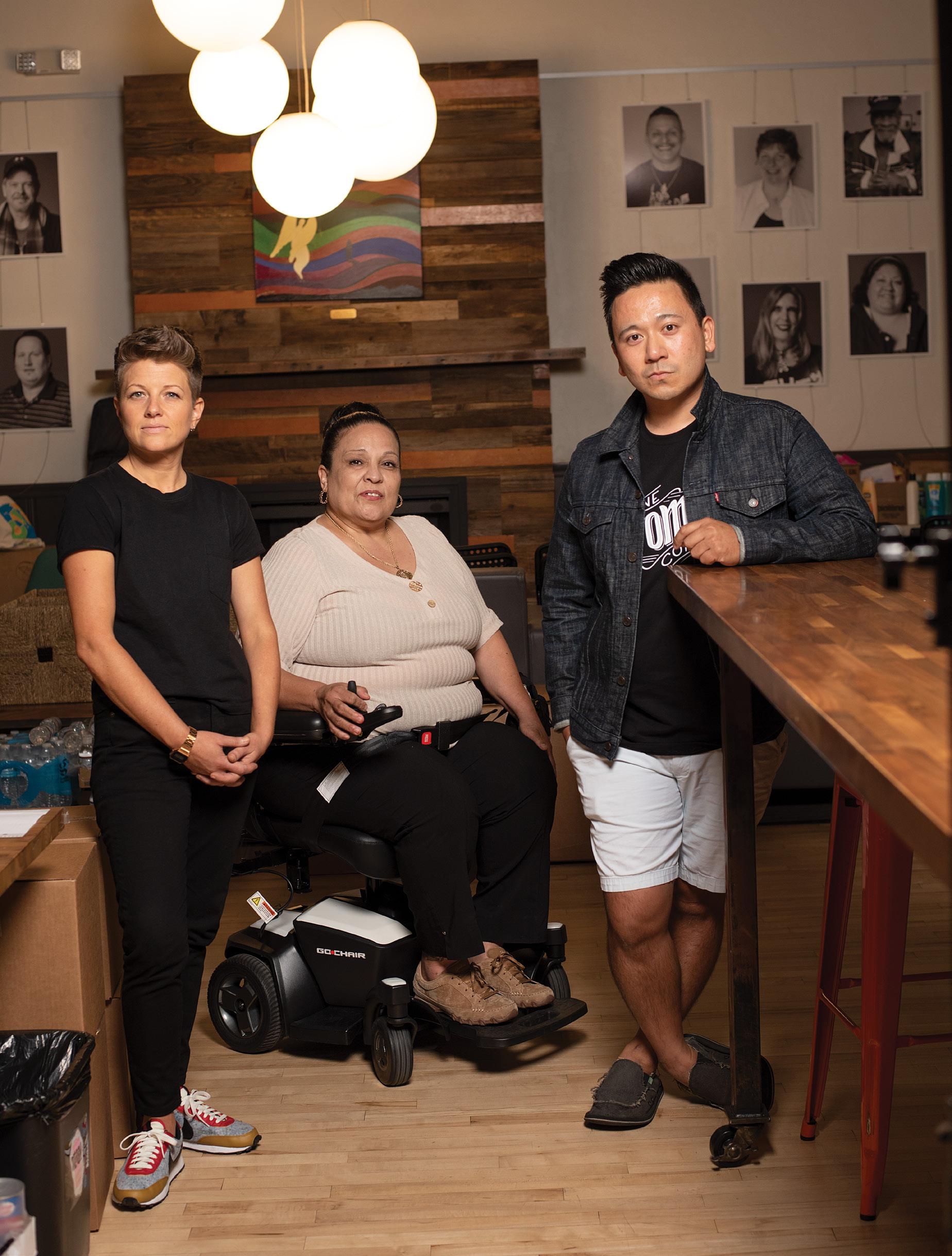
12 Discover 13.1
Diana Carreras
Lisa Willmes
Tadashi Oguchi
Recovery Cafe
A Healing Community
Diana Carreras never expected her life to change the morning a friend knocked on her door and asked for a ride. Carreras suffered from post-traumatic stress disorder, depression, and the drugs and alcohol that she used to cope. Carreras rarely left her bedroom because she was afraid to. That morning she decided to help her friend, because she knew what it was like to need help and not get it.
When they arrived at their destination, Carreras was surprised— it was a boxy 1930s-era church building next to San Jose City Hall’s South Plaza. Carreras couldn’t believe that her friend wanted to go to church. But the destination wasn’t a church—it was Recovery Cafe San Jose (RCSJ).
Written by Diane Solomon Photography by Daniel Garcia recoverycafesj.org Instagram recoverycafesj
RCSJ is located in the building of the Urban Sanctuary church. The entrance opens to what looks like a large, upscale coffee house—a well-lit space with new floors that look like birch planks and round tables that are perfect for conversing and friend-making. There are tall rectangular tables for computer work and chess games. There’s a coffee bar and a nearby kitchen where meals are prepared for members. Upstairs are meeting rooms. Behind the building is a spacious outdoor patio.
When Carreras walked in four years ago, she found it filled with people who seemed really happy; that puzzled her. “I knew these people were a lot like me, but something made them smile,” says Carreras. “Something made them talk and trust each other.” She wondered how they could be so happy when she was so miserable. She soon learned why.
13
Lisa Willmes is RCSJ’s program director. She has a sincere smile, a calm demeanor, steady eye contact, and she listens deeply. She exemplifies the respect and attention that RCSJ’s staff and volunteers pay to everyone there. Willmes describes RCSJ as a healing community for people who have been traumatized by addiction, homelessness, violence, sexual abuse, and mental health challenges. “Our motto is that we’re all in recovery from something,” says Willmes. She says that RCSJ’s vision and mission is to offer resources and relationships that provide the stability and healing that enables its members to recover.
The resources and relationships spring from programs that were developed in-house by Willmes and First Christian Church members. For many years this church provided meals and sleeping space to people who lived nearby on downtown San Jose’s streets. The church’s desire to help the homeless navigate their way out of substance abuse and mental illness led it to Seattle’s Recovery Cafe for guidance. In 2014, Recovery Cafe San Jose was founded as a 501(c)(3) nonprofit organization. In 2015, it launched its School for Recovery. Meanwhile, the church changed its name to Urban Sanctuary, and to accommodate RCSJ’s programming, it built a commercial kitchen, a coffee bar with cafe space, and improved its classrooms.
Even before COVID-19, RCSJ’s programming wasn’t limited to classrooms or traditional 12-step addiction recovery programs.
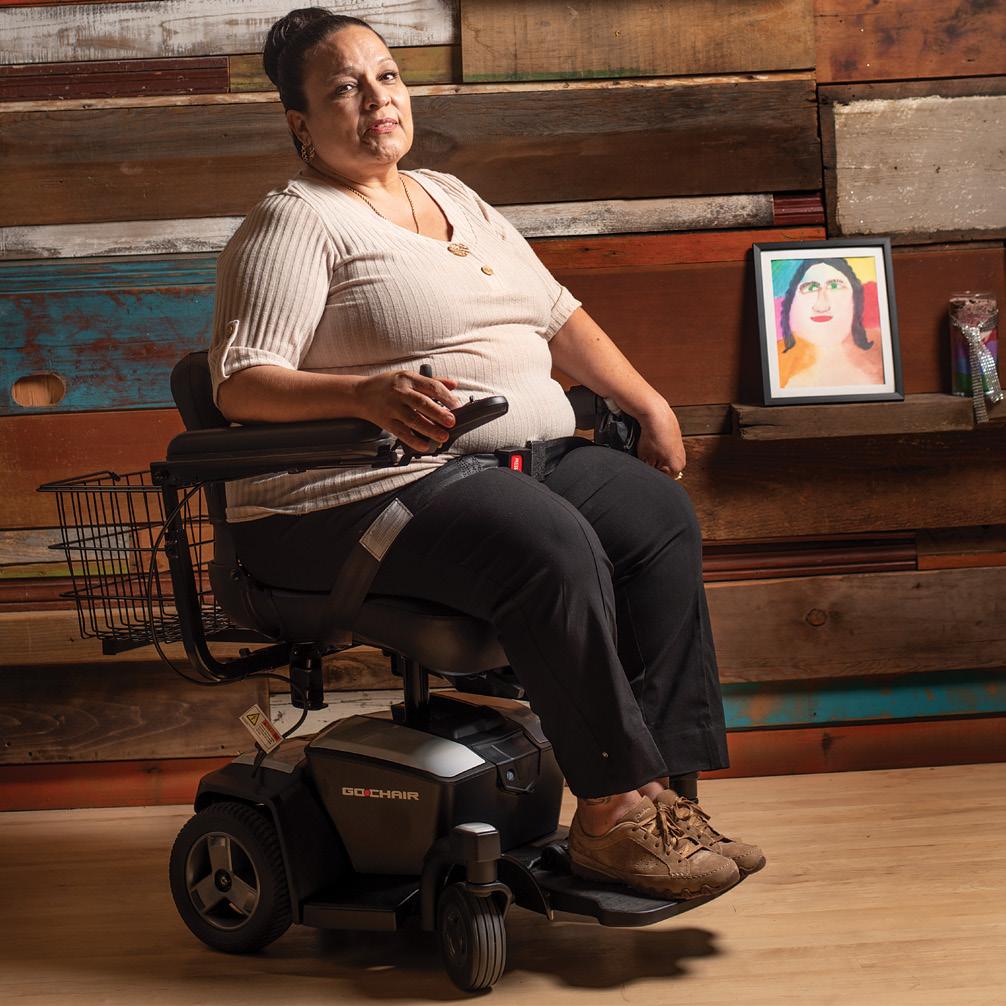
14 Perform 12.3
Diana Carreras, Member/Volunteer
“Recovery comes from deep relationships and from feeling connected to other human beings,” says Willmes.
Carreras’ recovery began with a meal, not a meeting. Her friend invited her to come inside and join her for lunch which was cooked fresh daily for everyone there. Tadashi Oguchi, RCSJ’s culinary and nutrition coordinator, says that home-cooked meals help members bond with the RCSJ community. “A home-cooked meal really opens them up,” says Oguchi. “They perceive acceptance, feel listened to, and sense that they can be loved by us.”
Oguchi’s full-time job is mentoring, counseling, and feeding RCSJ’s members. Before COVID-19, he planned and prepared five lunches, one dinner, and one brunch. These were served each week to over 100 members, plus volunteers and staffers. This was only one of the many services provided—on weekdays, from 10am to 6:30pm, RCSJ offered back-to-back classes, peer-led Recovery Circle support groups, creative activities, and visiting speakers.
When COVID-19 abruptly closed their doors, staffers made a tough pivot to keep their healing community afloat. “We had to come back to our vision-mission,” says Willmes. “It’s creating opportunities for members to connect with one another—to learn, to heal, and to grow.”
Staffers and volunteers began daily support calls to members. Inner healing, relationship building, trauma recovery, and mindfulness classes, a creative writing group, and the recovery circles went live
Lisa Willmes, Program Director
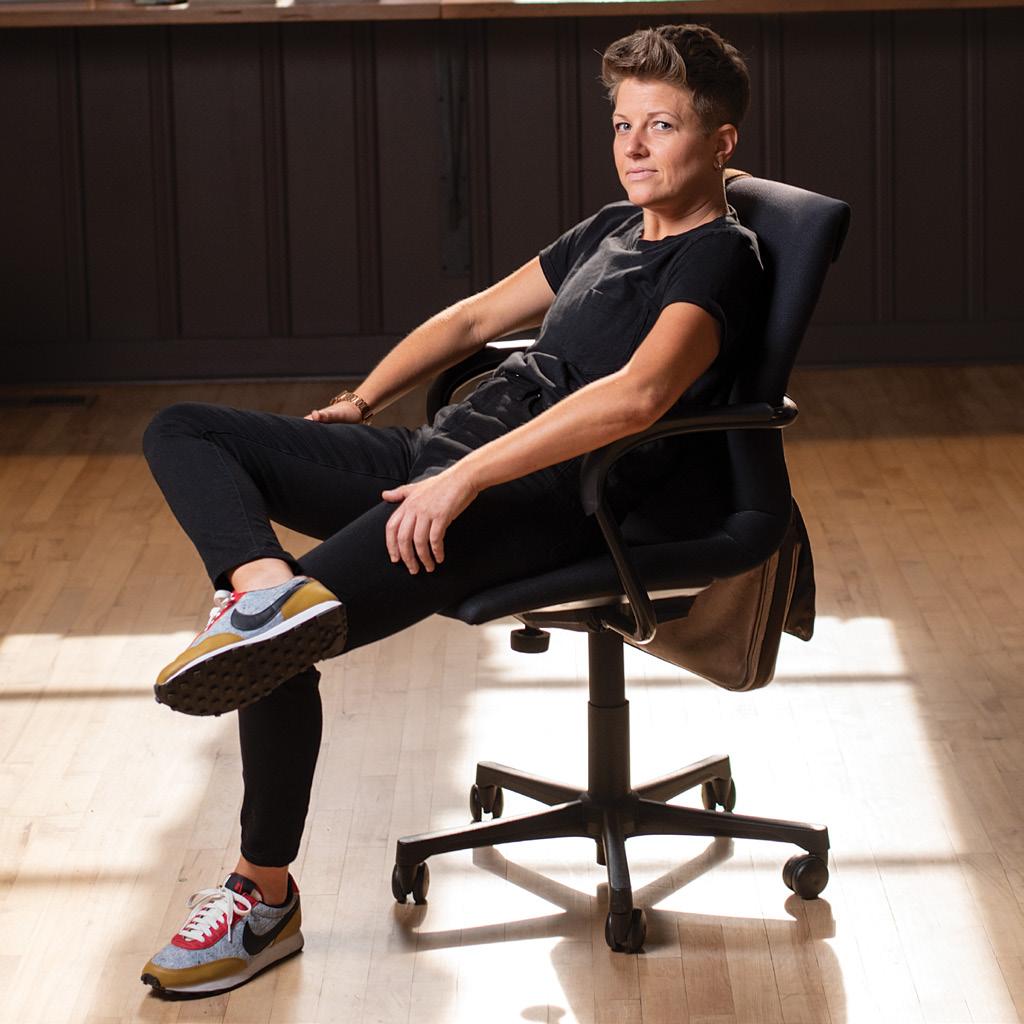
15
online. Volunteer Frances Paragon-Arias video records simple art projects for members that are posted on YouTube. As soon as Santa Clara County eased its COVID-19 restrictions, small socially-distanced recovery circles began meeting outdoors on RCSJ’s back patio.
Members learn about these offerings via a weekly email that includes access links to everything. Staffers and volunteers also deliver food, hygiene kits, art supplies, and writing materials to members who need them.
Oguchi is responsible for the groceries, produce, and meal kits that are delivered. The produce boxes contain a variety of fruits and vegetables. Most of this food comes from the Second Harvest Food Bank. The rest comes from San Jose’s Veggielution, Taylor Street Farm, or from San Martin’s Spade & Plow Organics farm. Meal kits include about six servings of prepared meals, which can be eaten directly or microwaved.
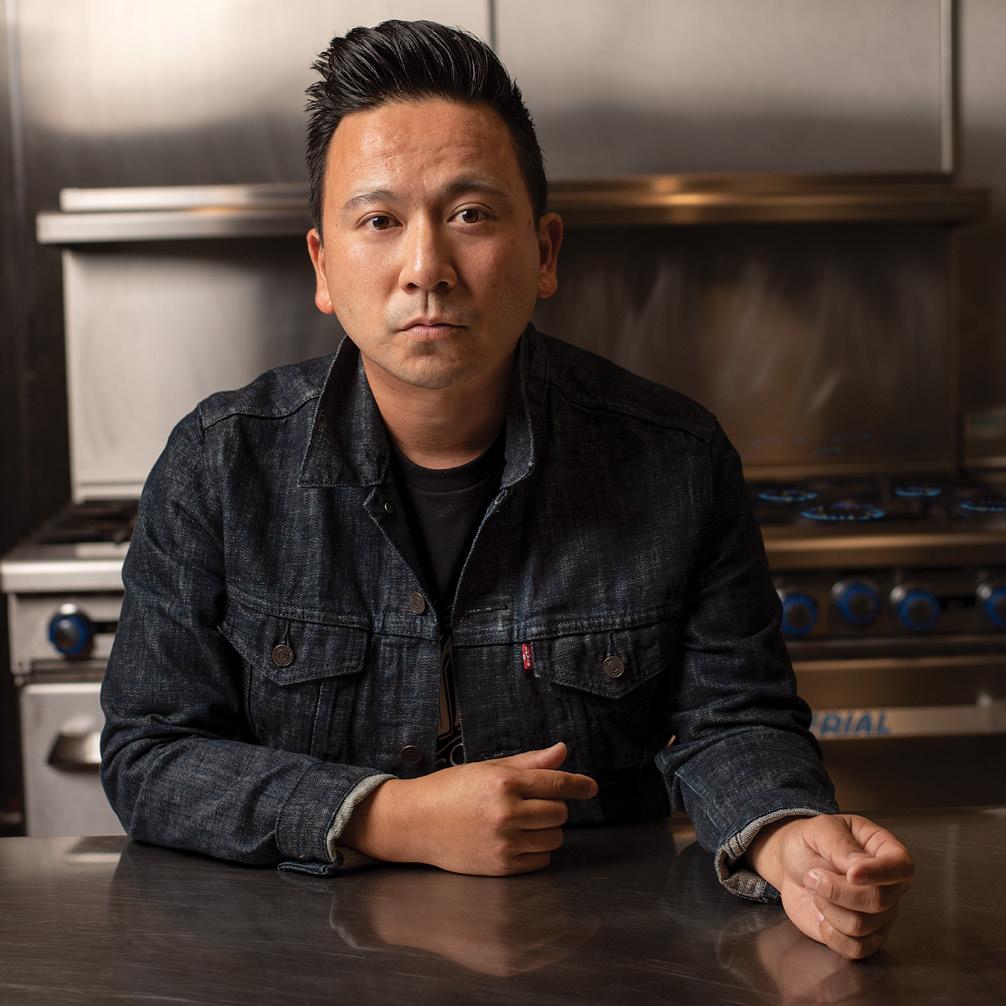
Oguchi’s super power is creating meals that utilize what’s available. Two years ago, when he was hired and served his first meals, members told him that they didn’t like vegetables. “Now they want salads and foods like homemade hummus,” says Oguchi. “I’ve been putting recipes into the produce boxes and the meal kits,” says Oguchi, “so they know what to do with them in a very simple, healthy way.”
RCSJ adapted itself to COVID-19’s restrictions with its programs, staff members, and volunteers intact. But members without digital
Tadashi Oguchi, Culinary & Nutrition Coordinator
devices, Wi-Fi, or secure housing environments are at a disadvantage. New membership now begins with phone calls, not walk-ins, like Carreras’.
“It all started that day I walked into the Cafe,” says Carreras. “That feeling has never left me.” Feeling loved is what propelled Carreras into a Recovery Circle and RCSJ’s classes. They recovered her from a horrid past—her grandfather began sexually assaulting her when she was a toddler. As a teen and young adult, she was trafficked and beaten. Carreras was able to marry a good man and help raise their children, but she only felt safe in her bedroom. Before RCSJ, she thought she was a lost cause.
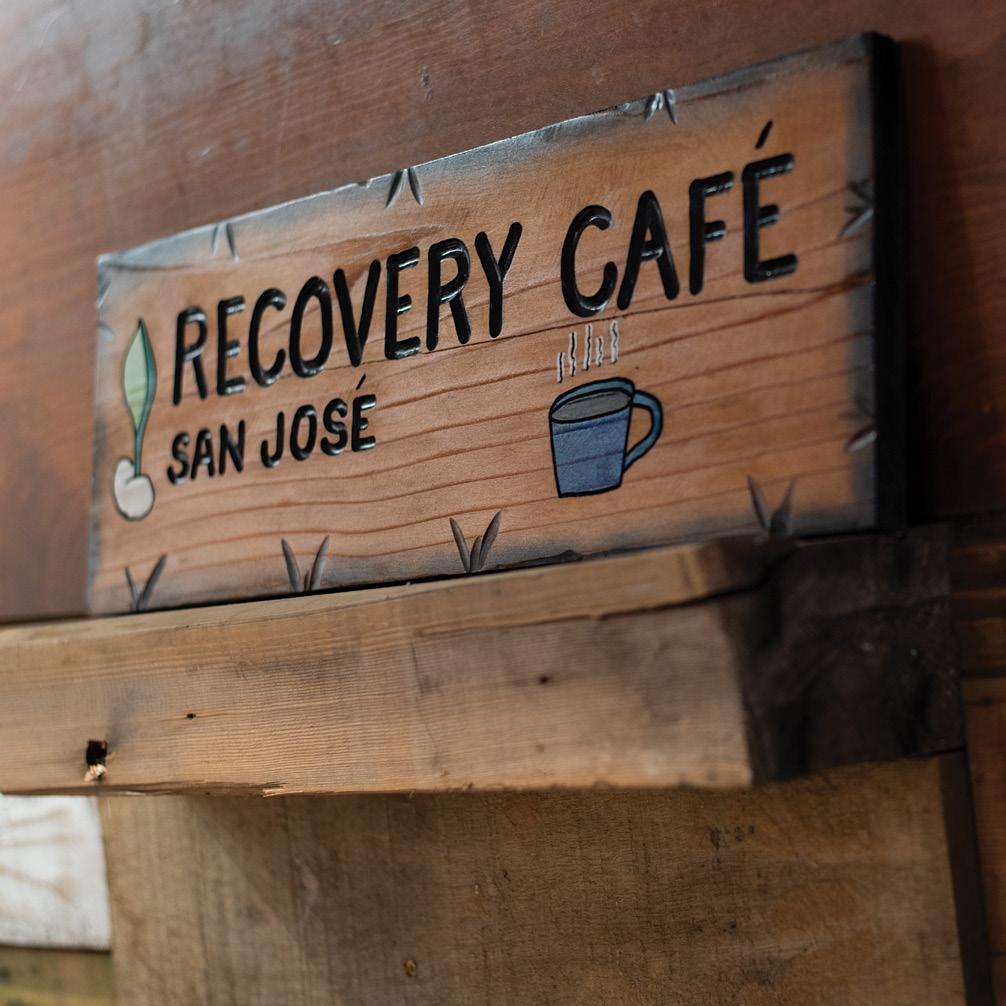
Today Carreras enjoys life and spoils her 15 grandchildren. As a RCSJ member-volunteer she now facilitates RCSJ’s Recovery Circles and classes. She’s also employed by San Jose State University. When the University’s Path to Expungement Mentoring Program spoke at RCSJ, Carreras joined it for the opportunity to clear her criminal record of drug convictions. Her presentation to a Santa Clara County judge not only convinced him to erase her criminal record, it moved the director of this program to hire Carreras as a mentor.
Carreras plans to keep giving back the recovery that she was given. “I’m over the hurt and I want people to have the same opportunity to change that I was given,” says Carreras. “And as long as I keep doing what I’m doing, helping people, that keeps me in recovery.” C
17
“Recovery comes from deep relationships and from feeling connected to other human beings.”
–Lisa Willmes

18 Discover 13.1
Anne To
A Communally Driven Life
Written by Johanna Hickle
Photography by Daniel Garcia thuyanne.com Instagram thuyanne
Anne To’s vocational trajectory has been a little like those chain reaction videos you see on YouTube—the ones that start with one tipped domino which triggers the collapse of an entire string of dominoes, which prods a ball down a slope, which jars a pair of open scissors and severs a string, which frees a balloon, which floats up to pop on an overhead tack to a showering of confetti. Except in To’s case, the dominoes are a series of events triggered by San Jose’s many artistic and cultural spheres.
“It was San Jose nurturing this process for me,” the South Bay native affirms, “where I didn’t really know where to start, but at the same time, San Jose didn’t really give me a chance to worry about that, because it was all these people who wanted to introduce everybody to everyone. They wanted to create this family.”
To’s eclectic journey was set in motion during her projectionist job at Pruneyard’s Camera 7 Cinemas. During high school and on into college, she soaked up the regional pride and the infectious energy of the staff. “Everyone working there was very passionate about the local community,” To reminisces. Through work, To encountered a few local musicians who steered her right into San Jose’s music community, a scene of scrappy young people and affordable, charmingly odd venues. She attended shows in homes and warehouses, at Nickel City and San Jose Skate.
She launched into designing flyers and album art for a few of the bands as she started attending De Anza College—and by the time she transferred to San Jose State, she determined to major in design studies.
When To rose to the rank of upperclassman, she landed a graphic design and marketing internship at Cinequest, where she worked with a dedicated team to create festival guides, bus tails, and postcards. “They incorporate a lot of the local scene into that film festival,” To states. The experience introduced her to the city’s dedicated following of cinephiles, while also allowing her to see a fair share of her musical friends at the festival’s roundup of live performances.
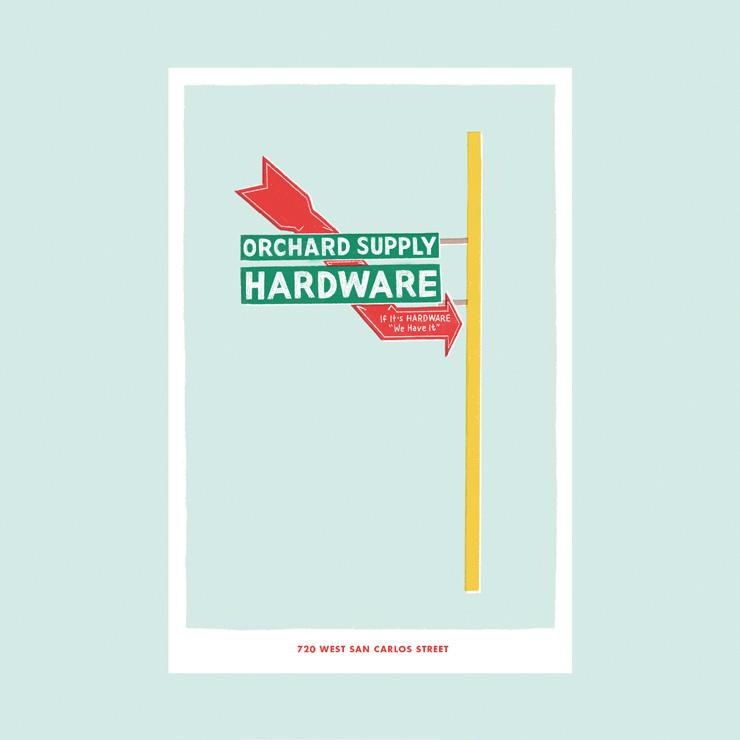
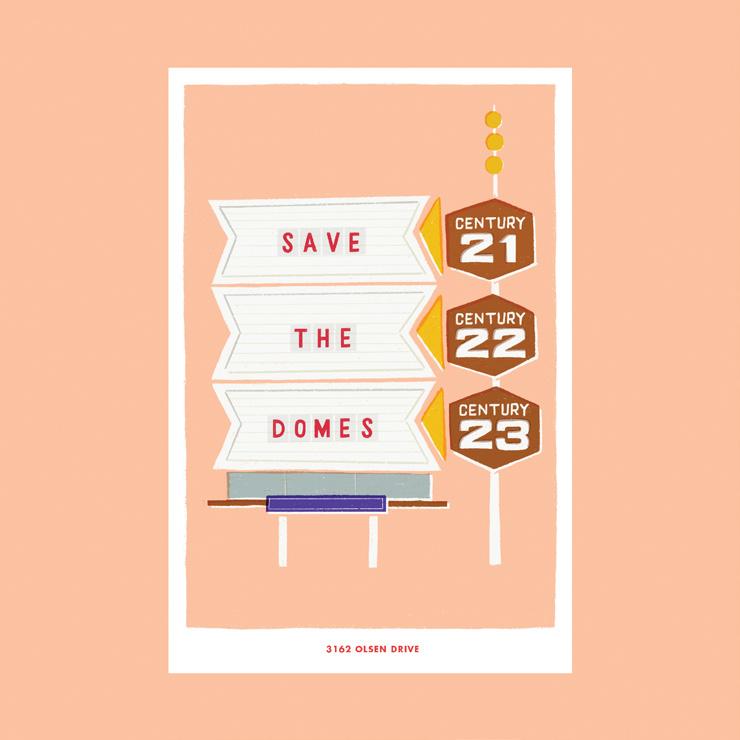

20 Discover 13.1
–Anne To
By
Cinequest’s
end, To had established one of her vocational values. “I wanted to keep that common theme. Where I work, I wanted it to come back to San Jose and my community, because that’s what I know best.”
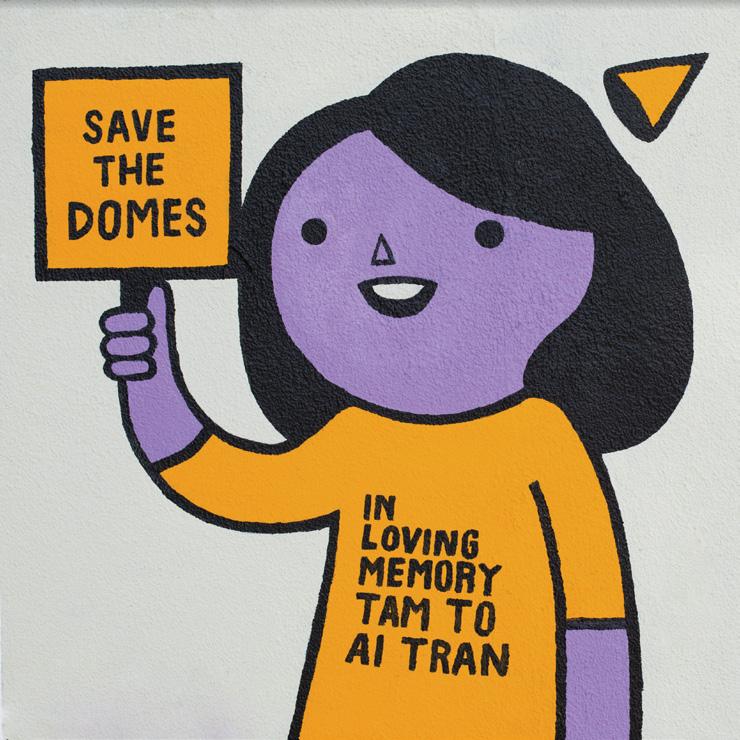
That mindset dominoed right into a position at Orchard Supply Hardware, a store founded locally by 30 farmers during the Great Depression (back when the Silicon Valley flourished with fruit orchards, not tech giants).
At the company, To worked first as a graphic designer, then as creative and content director. “Regardless of the title I had, I had the same job,” she asserts. “My job was storytelling.” That meant preserving all the reasons customers kept returning to the store as well as celebrating Orchard’s San Jose origins. “I really loved that I could make that transition from the local film festival to this local chain,” she says.
After taking a year off from work to care for her dad, To wondered, “What next?” San Jose answered by recruiting her to a small army of artists joining forces for a world-record-holding collaboration. The project? Local Color’s patchwork of mini murals, 100 creators strong.
While bringing this painted behemoth to life, To spoke with other artists about their own journeys. One of her new connections mentioned his job at an advertising and digital content agency called Baker Street—which led To to her current position as the company’s art director.
For once, To’s job isn’t San Jose-based. Though she initially had some reservations about working in the East Bay, she soon fell in love with their own creative scene and decided to act as an arts and cultural ambassador of sorts between regions. Besides, she still gets to live in her beloved San Jose. “I get the best of both worlds, [and I’m] taking another community to bring back to this community,” she shares.
Like a collagist, To prefers to celebrate her overarching story rather than any one snapshot. “It’s not just any one big thing I did, but it’s how I got to be so lucky to be this product of San Jose.” After all, what is urban life without the hearts and minds that power the city? C
“Regardless of the title I had, I had the same job. My job was storytelling.”
21
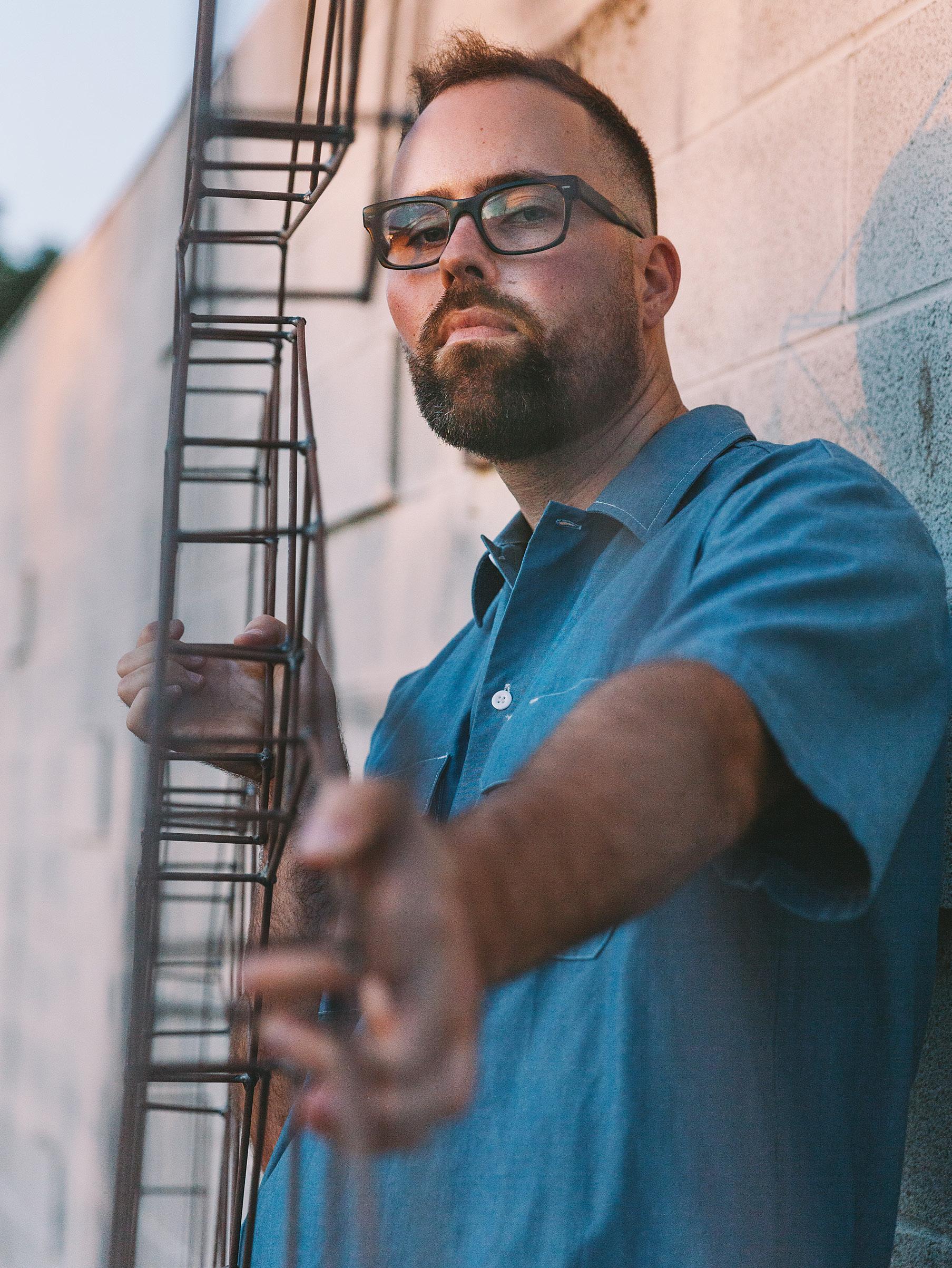 Written by Nathan Zanon
Photography by Sannie Caleridad isaacslewin.com Instagram isaacslewin
Written by Nathan Zanon
Photography by Sannie Caleridad isaacslewin.com Instagram isaacslewin
ISAAC LEWIN
Sculpting the Beauty of Letters
Artist Isaac S. Lewin is a multidisciplinary artist with a studio at the School of Visual Philosophy in San Jose. He creates unique sculptural pieces in two different styles: signs that contain text-like forms with no concrete meaning and large, three-dimensional, welded-metal wireframe structures.
Lewin is talkative and thoughtful, with a unique charm that makes you feel like you’ve known him for years, even upon first meeting. Despite being a transplant to San Jose, he has a passion for the community and the artists he’s found in the South Bay. But his artistic roots are grounded in the graffiti and street art he saw in his hometown of San Luis Obispo.
“I lived on a dead end, and we had train tracks at the end of the street, and I also lived on San Luis Obispo Creek,” he says. “I saw a lot of graffiti growing up, even though I’d grown up in a fairly small, agricultural town. All the creeks from my backyard go through downtown, and then
also there’s tons of bridges and the train, so these are all like central places where graffiti is committed, so to speak. Walking through the tunnel, you’re seeing all this graffiti. I’d ride my bike by the train tracks all the time and see graffiti coming by on the Amtrak line and the freight cars. So over time, around the age of 15 to 16, I started painting graffiti.”
At age 18, he moved to Osorno, Chile, as an exchange student and discovered a whole new world of graffiti culture that dwarfed his own small-town experience. “It was like showing up to New York in 1984; there’s kids in the plaza writing in blackbooks, freestyle rapping. The community was as authentic as it could get. All it did was bolster my commitment to graffiti and hip-hop culture.”
This passion for the letterforms of graffiti has stuck with him through his studies and career. After attending college at the University of Puget Sound in Tacoma, Washington, he re-
turned to California to work on an MFA at San Jose State, where he refined his concepts and began exhibiting his works.
His signage pieces examine the beauty of text by emulating the forms of letters, but creating “words” with no meaning.
“The whole idea is to take a communicative format, which is signage, and then put something that can’t be communicated,” he explains. “I’m just trying to create beautiful text; I don’t want you to be distracted by the word ‘war’ or the word ‘peace’ because those things have so many meanings for people, based on their own histories and identity. But text is inherently human. It’s our basis for communication, and I’m creating a property where everyone can read it at the same literacy level. It doesn’t even have a sound, because we can’t speak it—but we know it’s communicative.”
The metal wireframes, meanwhile, have a different visual impact but draw from a similar concept. While these

23
site-specific works appear deliberate in their form, Lewin’s approach in creating them is much more freestyle. He takes sections of steel and welds them together at joints, constructing the figure as he goes. Somehow, the result still tends to resemble graffiti, with shapes that imply letterforms and give an impression of the outline of a tag you might see under a bridge or on a train

car in San Luis Obispo or on the streets of Chile.
“The style that they come out is just that way almost subconsciously,” he admits. “It’s kind of like a doodle, but instead of making a mark on the plane of paper, the space is just the paper, and the rod is the line. I don’t actually measure any of the things beforehand. I take the length of steel…cut it…weld it… and then I just build and build, and I listen to headphones and so it’s just music. I need to know the parameters of the area, but otherwise, I’m just building—just drawing in space.”
Lewin encourages people to see these pieces in person, with good reason. Their wireframe nature means photographs flat-
ten the works, but in person, the three-dimensionality is striking, with the structures popping out of the walls on which they hang, filling the space and creating a form that changes its appearance depending on the viewing angle. While many of these works are in private collections, two can be found in the lounge of the Foundry Commons building near downtown San Jose.
Ultimately, Lewin’s goal with his art is a simple one. “I can give you all these conceptual ideas and break it down really philosophically,” he says, “but at the end of the day, I’m just trying to make cool-looking shit. Most people only spend a matter of seconds with any piece of art in a museum. I think artists need to be really conscious of that first initial grab of visuals; once you’re drawn in, then you can meditate on it and think about it on a higher level. That’s important, but I think first it should just be…cool.” C
“Text is inherently human. It’s our basis for communication, and I’m creating a property where everyone can read it at the same literacy level.”
– Isaac S. Lewin
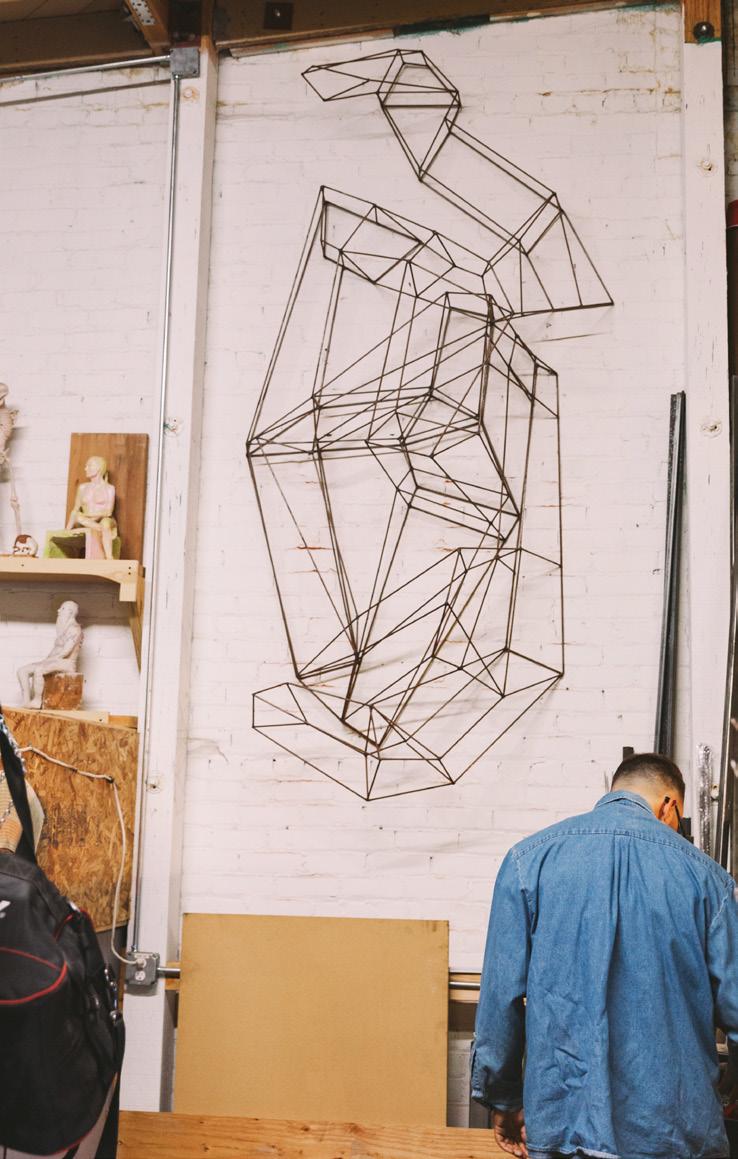
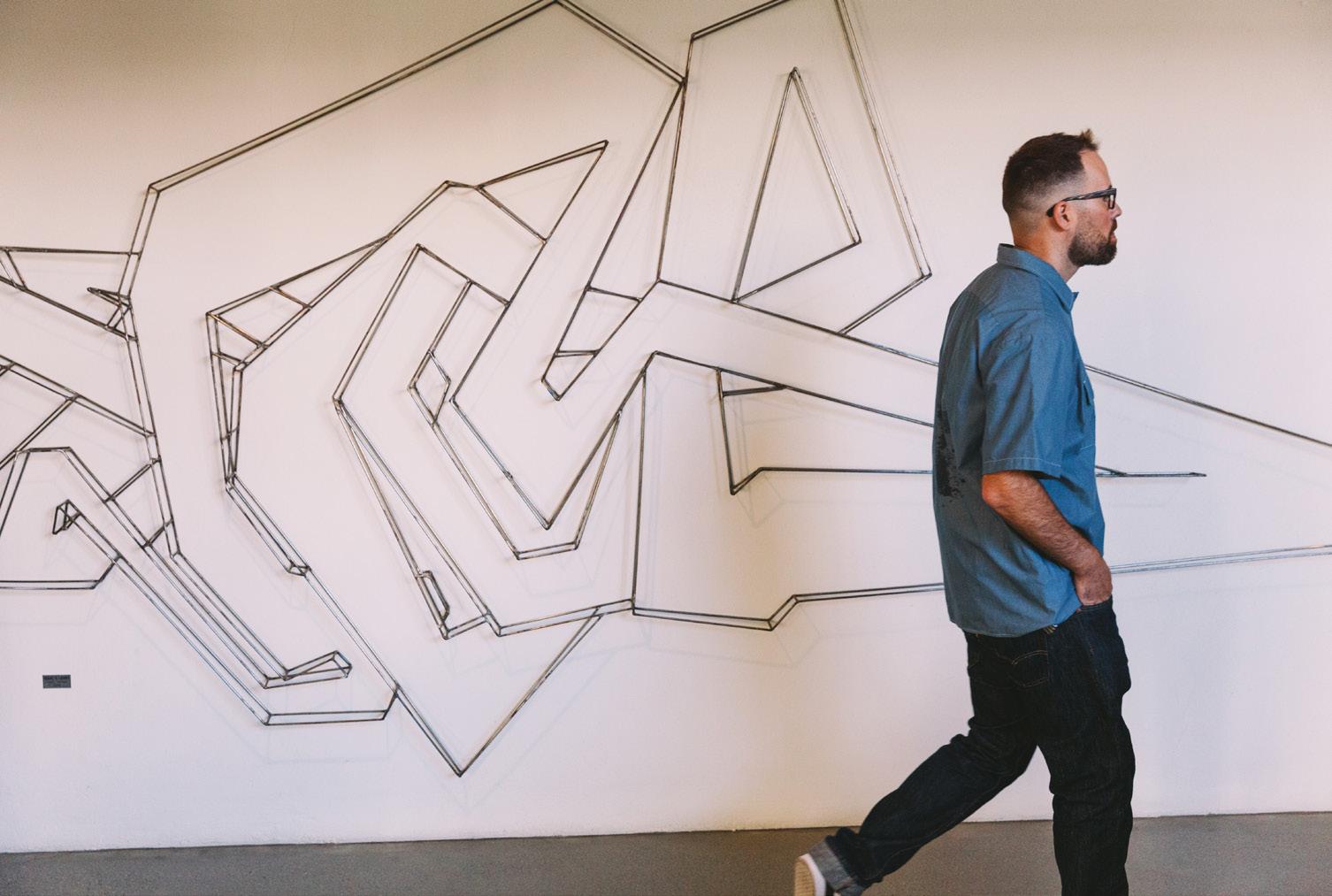
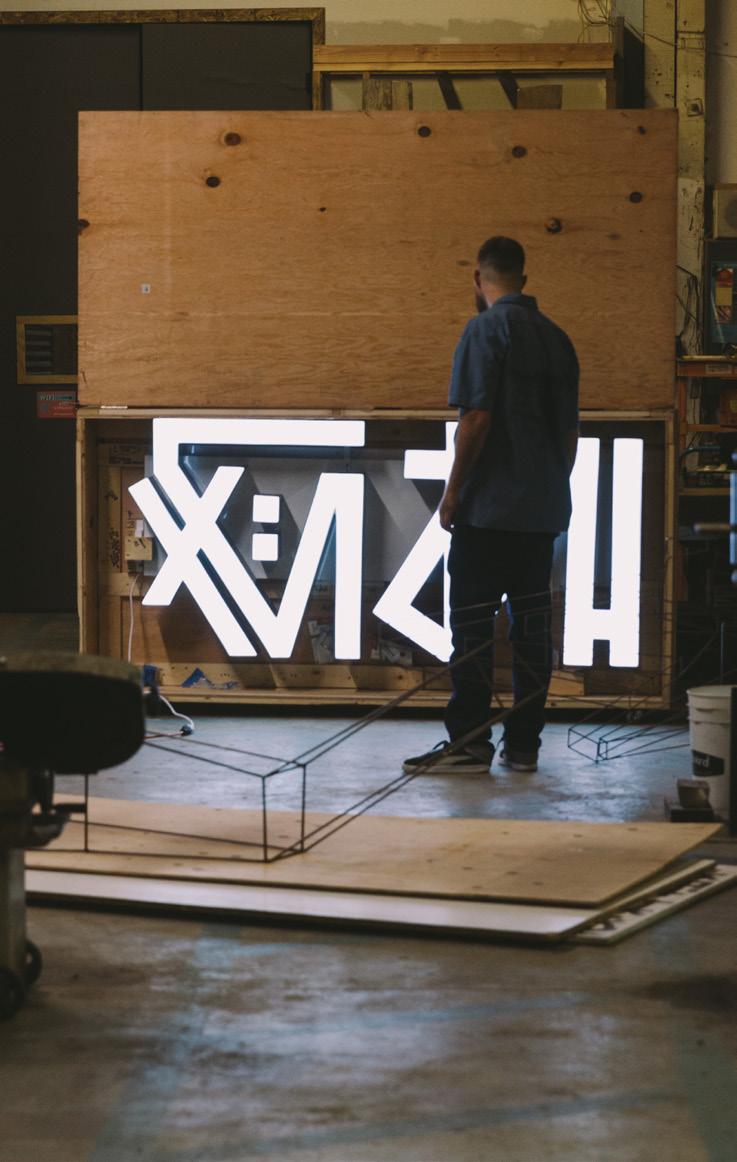
25
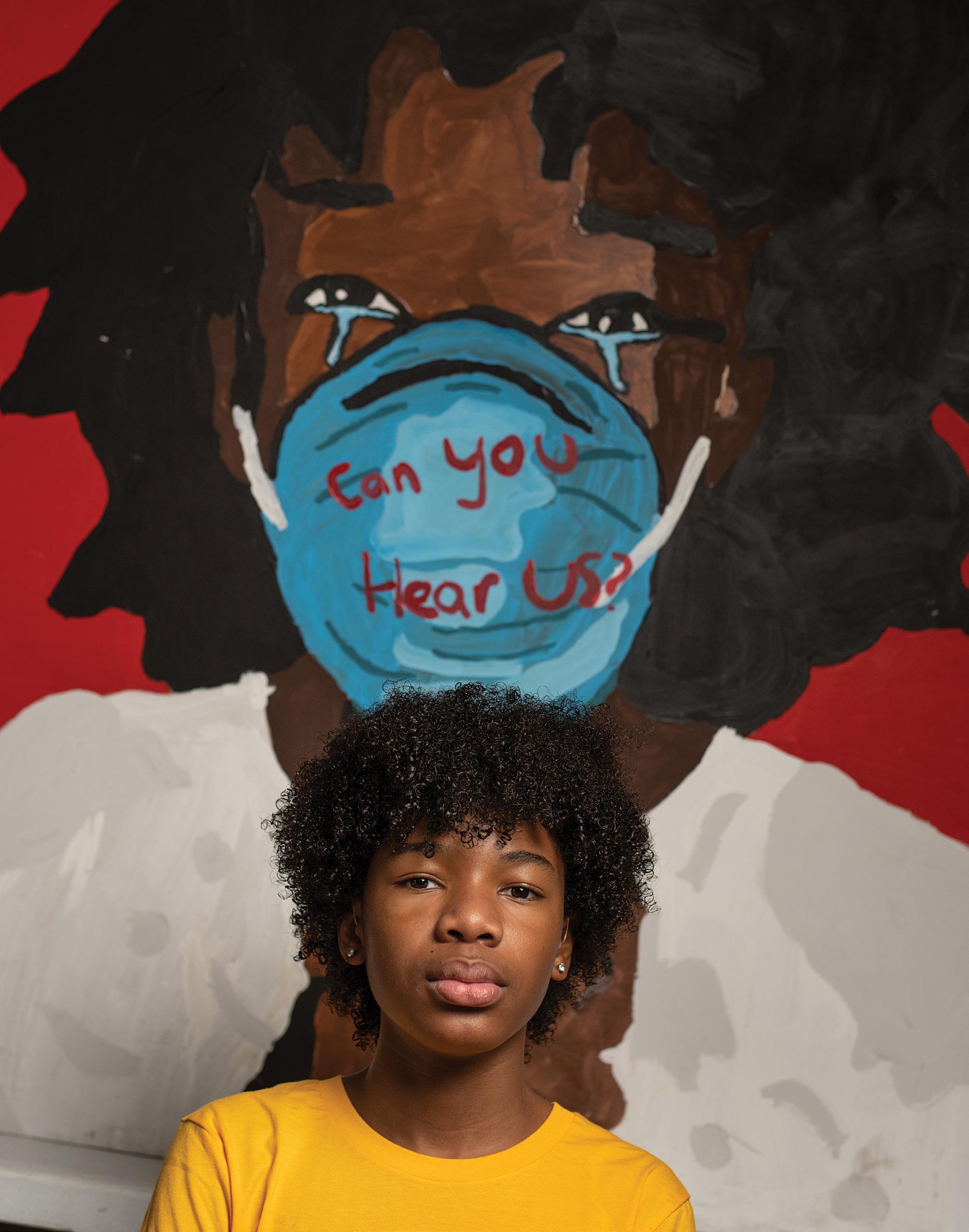
Tyler Gordon
Painting Prodigy and Regular Kid
At age 14, Tyler Gordon and his art are already in the national spotlight.
It can take years to develop the skills and technique to create paintings that capture the eye, and even longer to become well known. Tyler Gordon, a San Jose native who, at 14, has a fan following of celebrities and art lovers, wasn’t ready to wait that long to make his own (acrylic) mark on the art world.
basketball. “He’s actually really funny and really tall as well.”
Written by Michelle Runde Portraits photography by Daniel Garcia Facebook tylergordonyoungartist Instagram official_tylergordon YouTube tye daguy
From the age of 10, Tyler has been creating portraits of people and characters. His first portrait was of his elementary school’s principal. His mom and fellow artist, Nicole Kindle, instantly recognized his talent and knew how important it was to encourage Tyler to pursue his talent. Little did she know how quickly Tyler’s work would garner national attention. His first sale was a portrait of Kevin Durant, whom Tyler met in person. “I think the most special celebrity that I met [was] Kevin Durant,” said Tyler, who loves to play and watch
Tyler uses bold acrylic colors to achieve contrast, often only needing to use a few shades to create one striking piece. He brings people and characters to life by emphasizing shadows and negative space, a skill that many artists work years to develop, but which came naturally to him. Whenever people approach Tyler with new techniques they think he should learn, he doesn’t hesitate to politely decline. “I remember that a lot of people [have tried] to get me to do art classes and change the way that I do my art,” said Tyler. “But I always turn them down, because that’s the way that I paint, and I like my style.” With the steady flow of commissions coming in for portraits, it’s clear his fans agree with Tyler.
Even in the midst of COVID19, Tyler has had a lot to keep
27
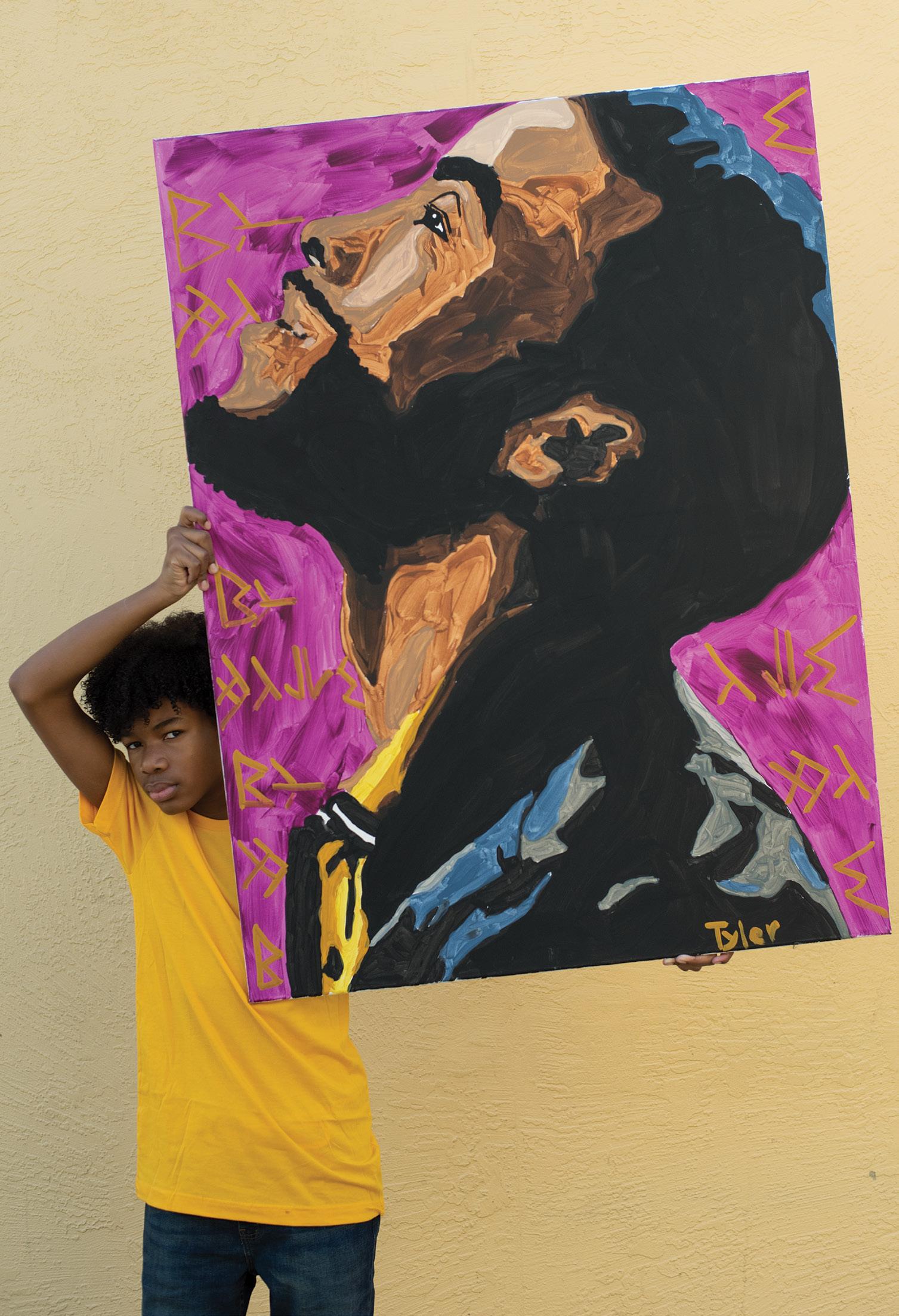
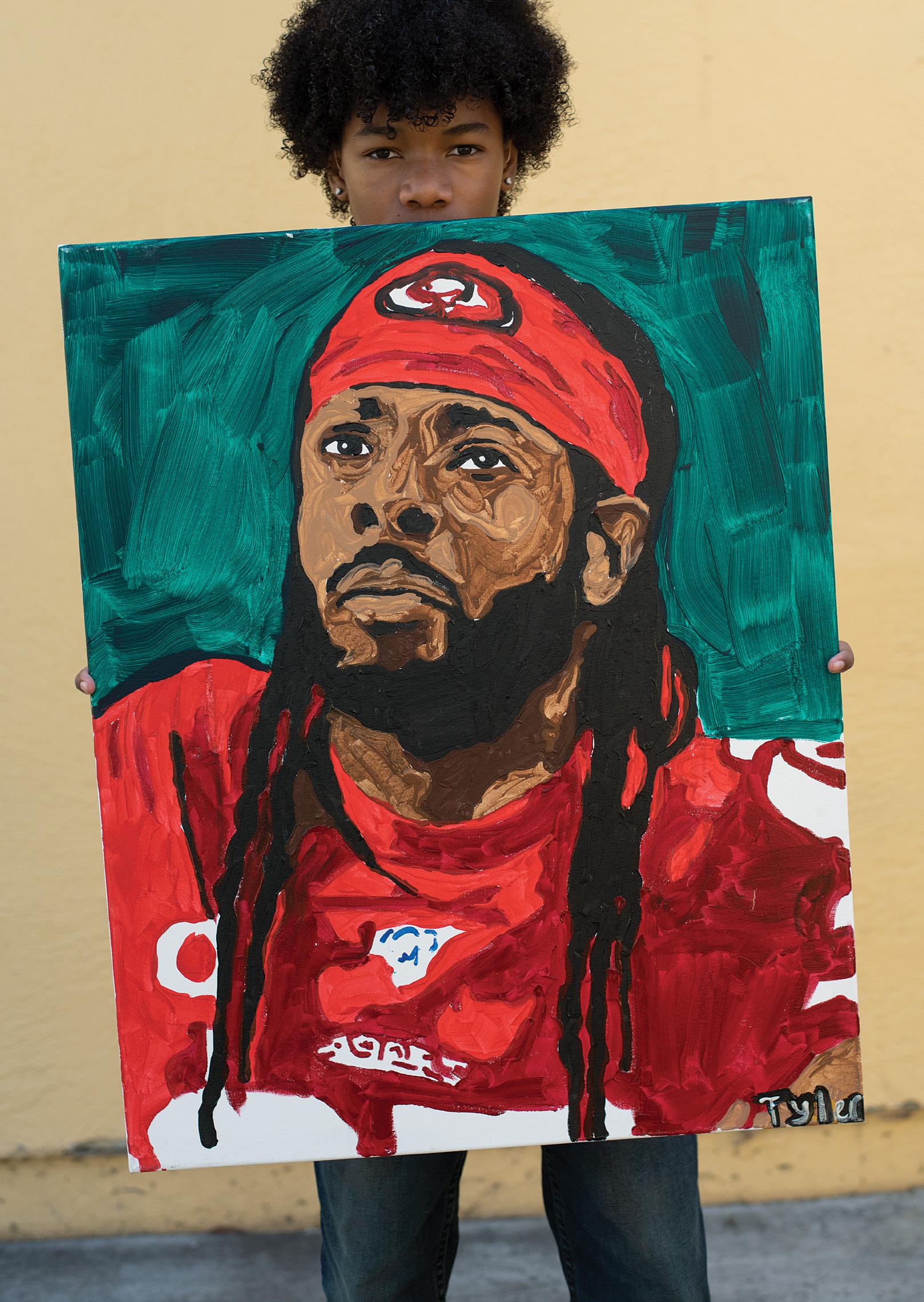
29
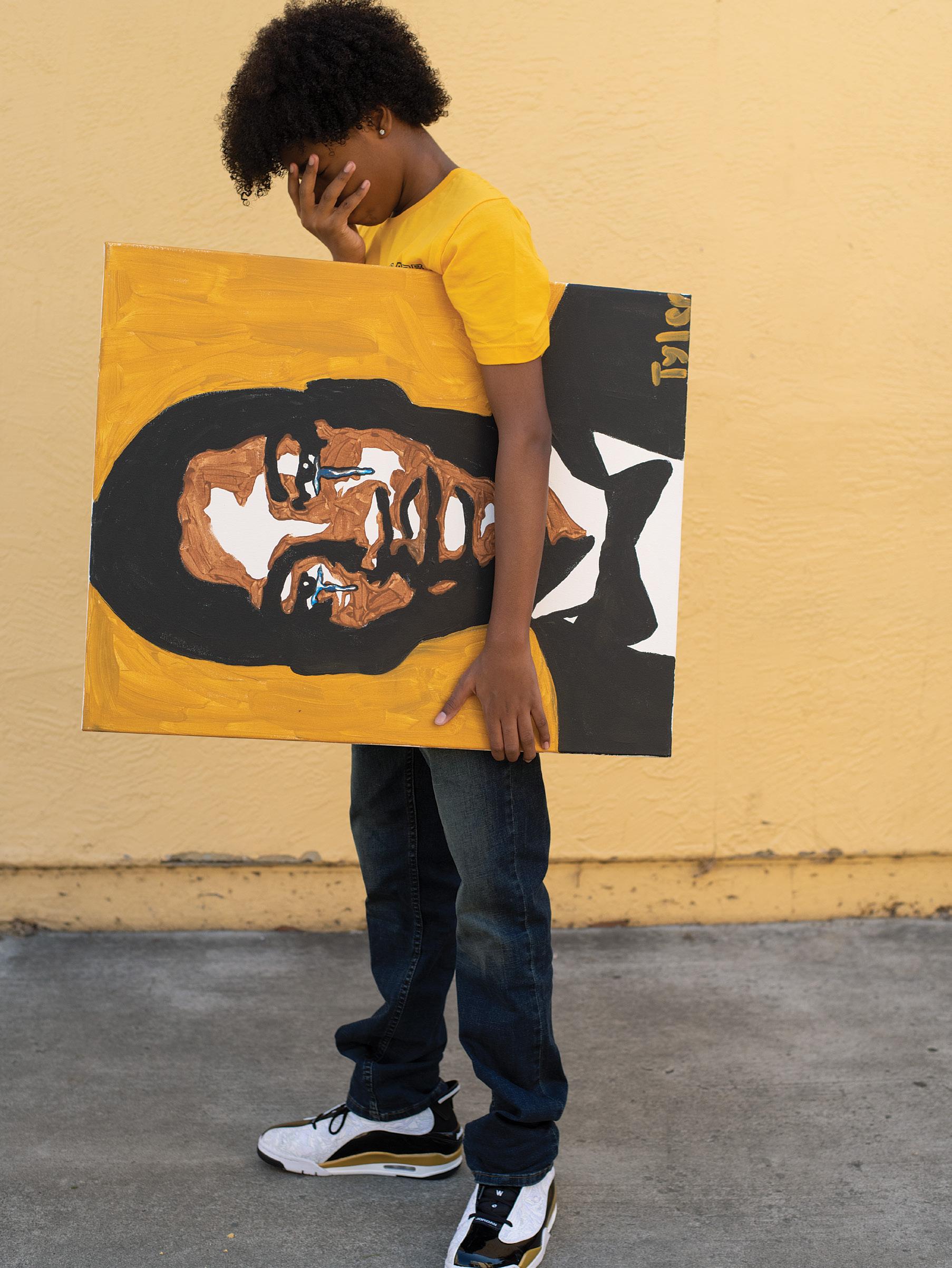
him busy. Between painting commissions, meeting celebrities on talk shows, keeping up with his school work (something his mom, Nicole, is careful to make sure never slips), and taking time to play sports, Tyler has also been hosting free online painting classes every week on Instagram. His manager had the idea before COVID-19, and the pandemic was the perfect time to give it a try. “It’s actually really fun,” said Tyler. “I do talk to the [painting participants] and ask them questions, and in the chat they’ll answer back, and it’s a really fun experience.”
Recently Tyler has also been adding his voice, and his paint, to the fight for racial justice. As a young Black man himself, and with protests taking place in his hometown, San Jose, it’s
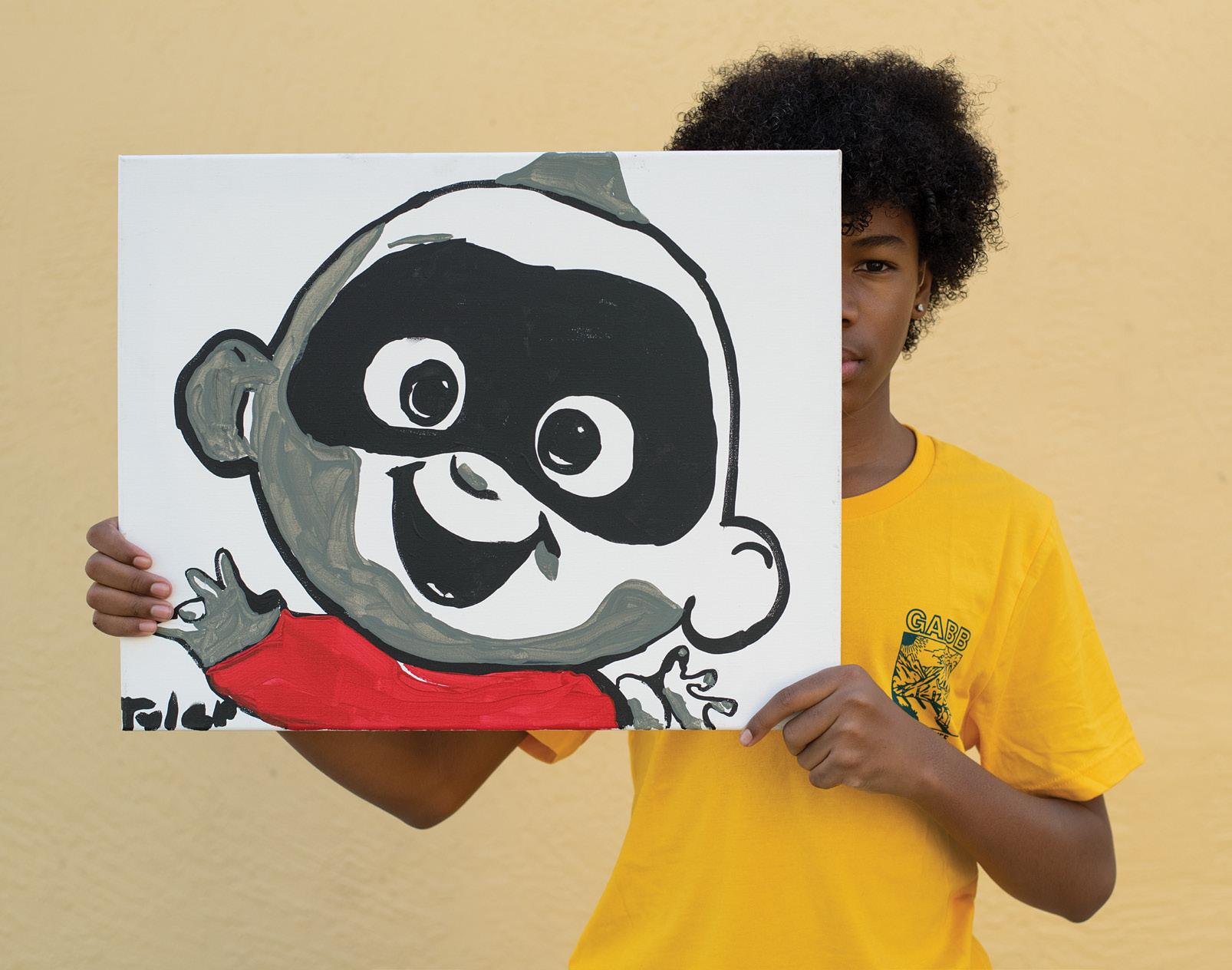
a unique moment in history for him. Not only has Tyler attended two peaceful protests, he’s also painted portraits of George Floyd, Breonna Taylor, and Elijah McClain. Tyler recalled his experience while painting them: “Doing these paintings…I [felt] sad because what happened to all three of them, and maybe more, they didn’t deserve what happened to them. So when I do these paintings, I do them so people can remember them, and so I remember what they were like.” In particular, hearing the circumstance of the murder of Breonna Taylor affected Tyler. “She did not deserve what happened to her,” said Tyler. “So I want people to always think that she was a magnificent person.”
Earlier this year, Tyler was a recipient of a Global Child Prod-
igy Award, an accolade only a handful of kids earn. “Only 100 kids in the world are chosen in each category, and he was chosen for the art category,” explained Nicole.
Tyler is also on a personal mission to help fight bullying, something he’s experienced firsthand because of his stutter. He and his mom recently formed Tongued Tye’d, an LLC with the goal of hosting art classes for kids with speech impediments. “He speaks through his art,” said Nicole. “He wants to teach other kids to speak through theirs, and we want to bring in people…to help these kids.” With so much talent, personal drive, and great family support, this is only the beginning of his amazing career. C
31
“That’s the way that I paint, and I like my style.”
–Tyler Gordon

32 Discover 13.1
Human Shaped Animal Artist Rachel Barnes
Written by Esther Young
Photography by Daniel Garcia
humanshapedanimal.com
Instagram
humanshapedanimal
H S A
FOR THE CREATOR BEHIND the stunning murals and imaginative creations of Human Shaped Animal, life is a grand trust exercise. As a full-time artist and flow performer, Rachel Barnes is simply leaning into the places where passion and desire expand, being unafraid to leave a newfound home when a greater adventure calls.
Growing up on acres of land in Mars, Pennsylvania where one can run around barefoot in the woods, Rachel has always let curiosity be her guide. She once saw someone hooping at a music festival and decided to learn for herself; she built her own hoop and later joined a fire spinning group. In school, though she played plenty of sports, her favorite subject was always art. In college she explored early childhood education and even psychology before realizing that, for her, art for the sake of the art was the only pursuit she would wholly drive herself toward.
Rachel graduated with a degree in painting and digital design. Any art major knows the path from there is open-ended, and Rachel stayed in her college town for a couple years as she continued to create. To this day, the town of Bloomsburg, Pennsylvania, has a tattoo shop and a center for flotation therapy and bodywork services that proudly display her art. “It’s nice to have these little pockets, little seeds of my art from my time there,” Rachel says. But inner wisdom told her it was time to move up, and out.
Following her interests in holistic health, she began working at a wellness retreat center in upstate New York. Throughout her two seasons there, she lived in a tent and later a trailer as she participated in and taught classes in meditation, yoga, dance, art, and music. She bonded deeply with this community of passionate, like-minded individuals, but most intentionally grew to know herself. She knew when it was time to venture forth again.
Rachel moved to Santa Cruz with four other friends in a van. They braved camping for three months as they searched for infamously rare affordable housing. Eventually they laid down roots, and her art led her into the community. She connected with the founders of the Art Cave, Leigh Erickson and Danielle Peters, and the founder of Idea Fab Labs, Jordan Layman, and became richly involved in both collectives. By February, she was featured in the Cave Dwellers Debut with three other artists who had joined the Art Cave. Another show was to follow in March, but the COVID-19 pandemic pushed for other plans.
Since her initial move to Santa Cruz in 2016, Rachel has shown a lot of resilience. Now the only remaining one of the group she moved here with, she has learned to weather shelterin-place with gentle grace. Like many artists, Rachel felt the sudden isolation dry her well of inspiration; yet she learned to
33
HUMAN SHAPED ANIMAL


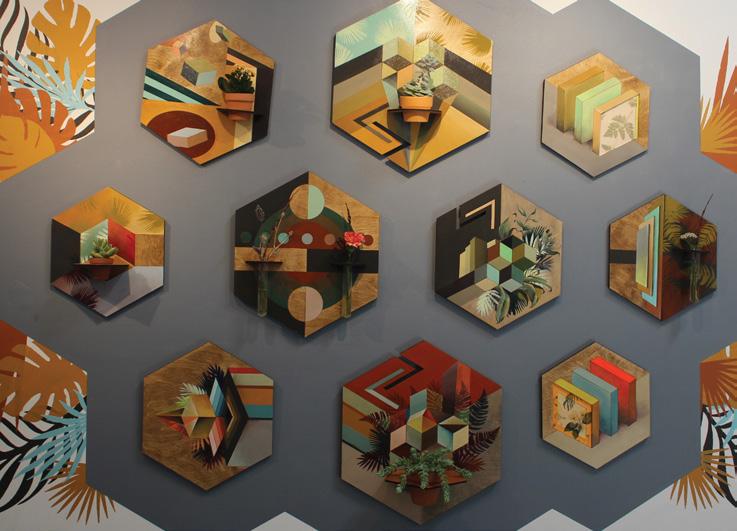
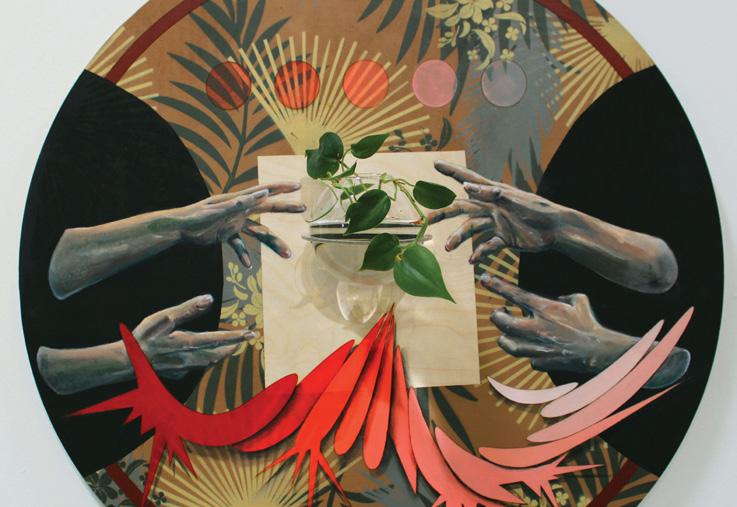
cultivate a mind state for rest and restoration, spending her time roller skating and practicing yoga. As she reminds herself and fellow creatives, everything alive needs incubation stages: “A flower doesn’t bloom all year long.”
Among her proudest moments is her very first largescale mural on a studio building downtown, featuring a beautiful human face gazing right. The face is as tall as its creator, and it’s a departure from the style of Human Shaped Animal. The project was matched halfway by the city, making it Rachel’s first official contribution to Santa
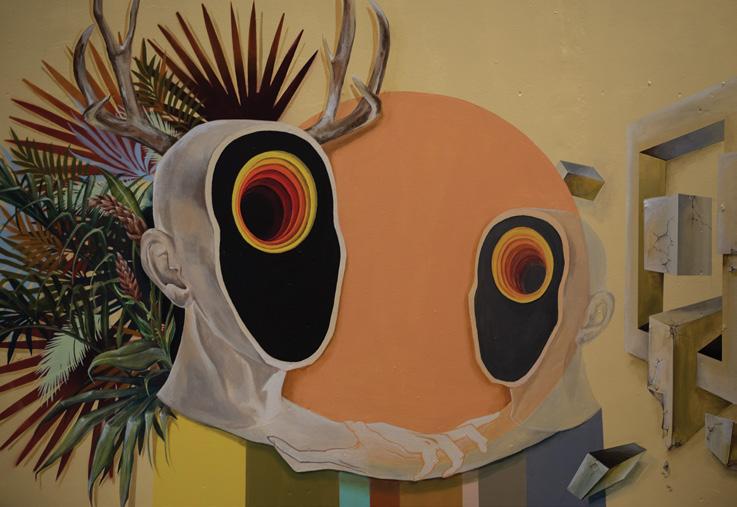
Cruz within her first year of living there.
“I feel like art has held me in ways that seem to just have taken care of me in hard times,” she says, reflecting on the timeliness of dream projects that emerged and connections that opened up when she needed housing, work, or community. “The more I trust in it the more it gives back. It seems when I’ve hit my hardest times, something with art takes off.”
Human Shaped Animal expresses Rachel’s core belief: “I love that animals are intuitive and it’s not separate from their mind.” Self-trust guides her fan-

tastically vast array of artistic expressions in flow performance, multi-piece murals, planters integrated into wood paintings, and bold installations.
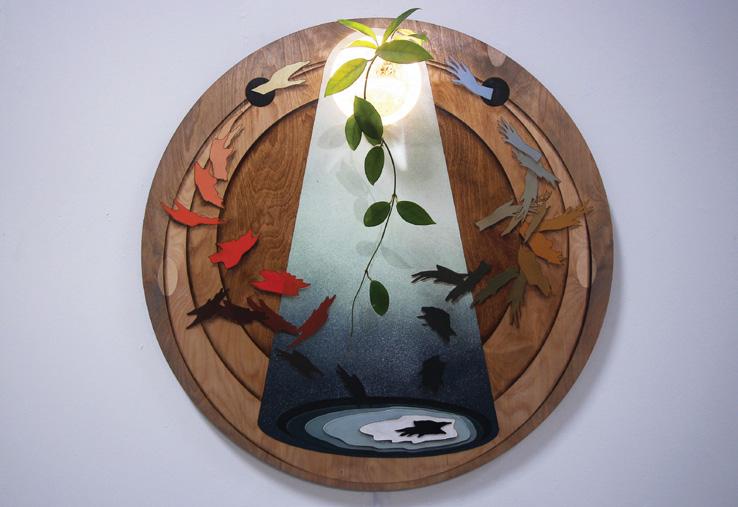
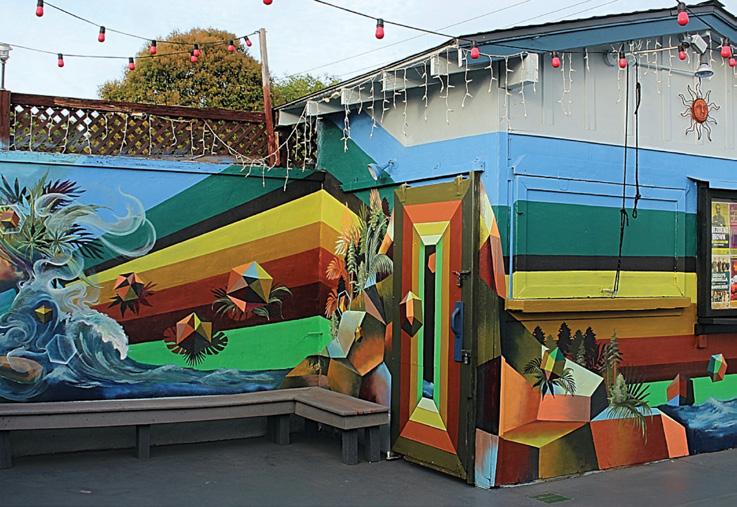

“I don’t know why that color and that shape make me feel that way, but that’s how I’m going to express it,” she says of her process. Simple, intuitive direction has always guided her way, and her art imitates her life. C
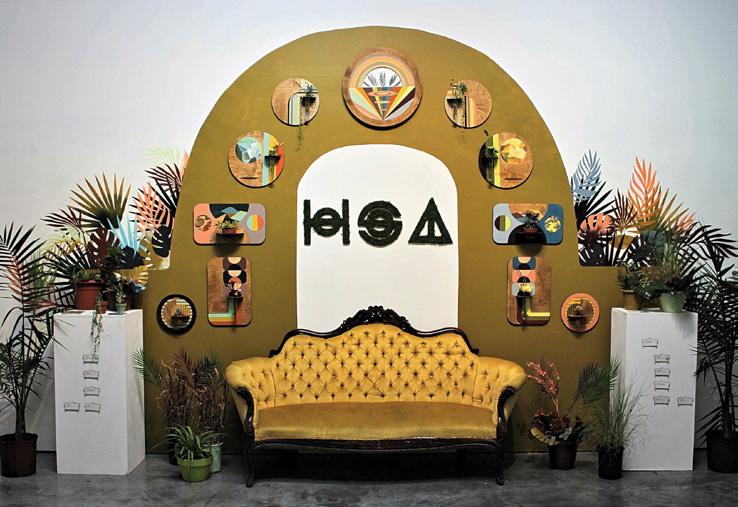
35
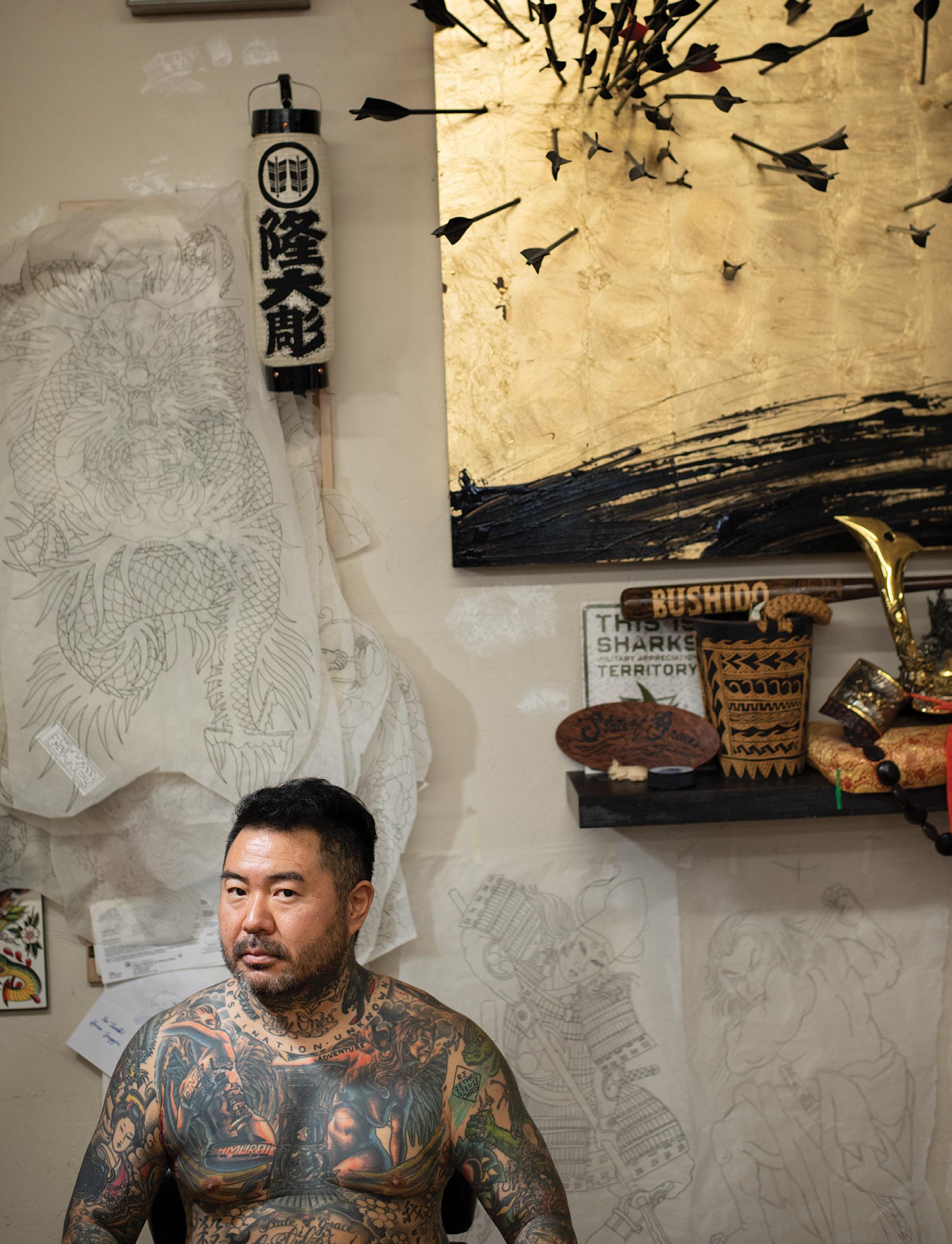
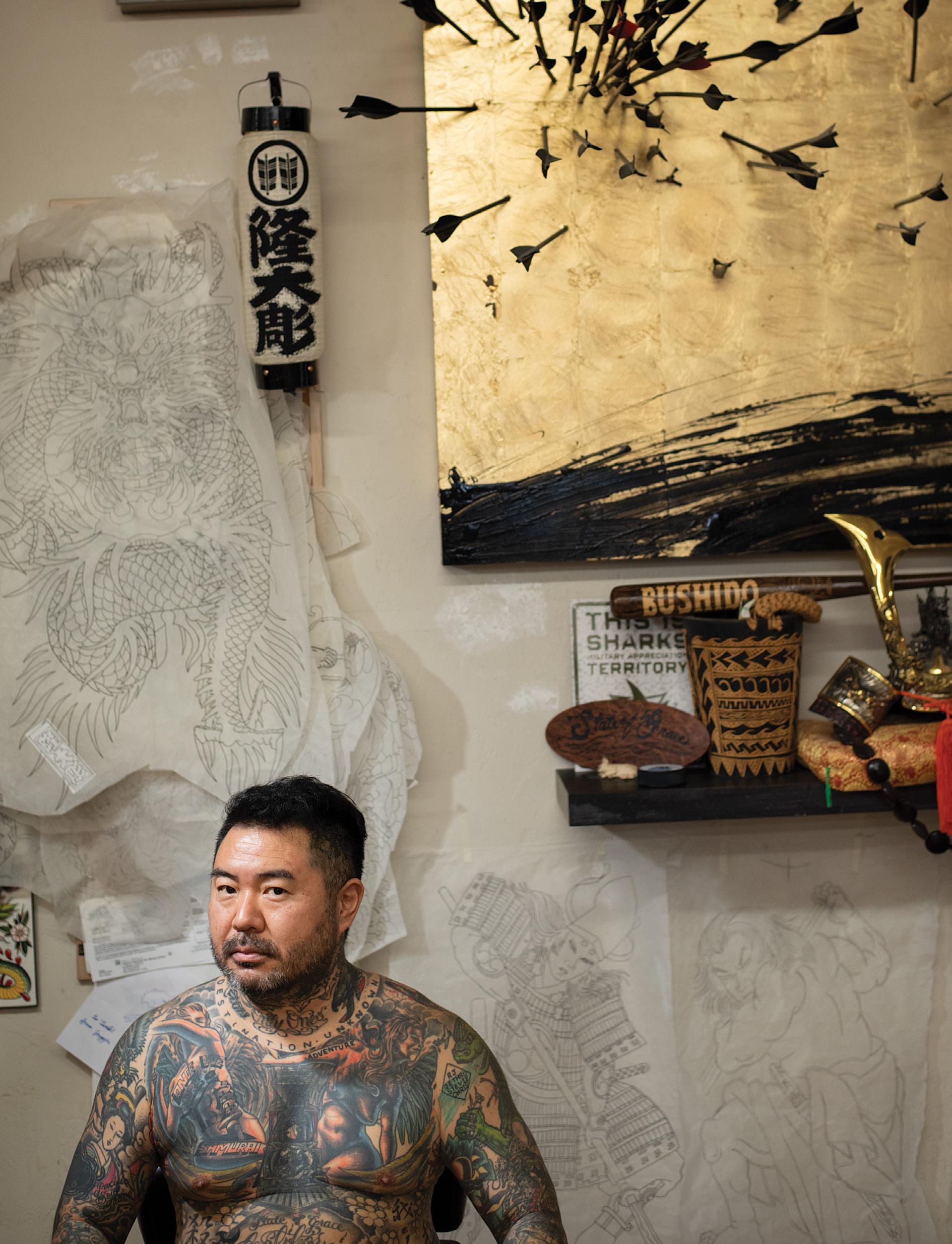
36 Discover 13.1
Written by Grace Talice Lee Tattoo
Agcaoili
Taki Kitamura
In a Constant State of Grace
At first glance, Taki Kitamura might be exactly who you’d expect to own State of Grace, one of the shops that brought traditional Japanese tattooing to this side of the Pacific. He apprenticed for a decade with Horiyoshi III, the living legend of the style. Taki has adored the art form since childhood, when he drew back pieces on his friends with thick felt pens. And of course, he shows a clear love for his craft, as he is covered head to toe in several layers of tattoos.

But if all you knew was Taki’s familial background, you would never guess his profession. Both of his parents served as pinnacles of social acceptability. His mother operated a ballet supply store and bussed the kids between Boy Scout meetings and youth symphony rehearsals. His father was a tenured professor of civil engineering who earned high honors from Kyoto’s mayor. And—having grown up in Japan where only Yakuza criminals got tattoos—neither of them would’ve ever, ever condoned the art form as a career for their son.
Yet it was exactly that illicitness that Taki found so enticing. As a teenager, he got sick of finishing his parents’ extra math drills while all his friends went swimming and skateboarding instead. So, he rebelled. He shaved off half his hair, dyed his mohawk pink, and got his very first tattoo on the side of his head—a jagged design that he doodled during class. He was underaged, and he prayed the whole time that he wouldn’t get carded.
stateofgracetattoo.com monmoncats.com
221 Jackson Street San Jose, 95112 Instagram
stateofgracetaki
stateofgracetattoo
Taki’s rebellion continued until the end of high school, when he lobbied to take a break before college. But his father flat-out refused, insisting that one gap year could too easily turn into two or three or more. So, the next fall, Taki enrolled in the University of California Santa Cruz, where he majored in community studies, which examines cultural identity with a heavy emphasis on field research. This taught him to commune with people unlike himself; to observe with the humility of a student and the criticality of a scholar; to learn from others while respecting their ideas, hopes, and histories, tools that would serve him well for the rest of his life.
After receiving his bachelor’s degree, Taki moved to San Jose and found retail jobs selling car parts and working at a supermarket gift shop. But his love for tattoos never waned, and he often got fresh ink from Paco Excel at Newskool Studios. On one of those
-
photography by John
Portrait photography by Daniel Garcia
37
visits, Taki let slip that he might be interested in pursuing the art form more seriously. “It was just one of those things where I was like, ‘Man, I want to learn how to tattoo!’ ” said Taki. “And I kind of just said it like, whatever, but [Paco] went ‘Yeah? You draw, huh? Bring in some of your drawings!’ And he agreed to teach me.”
For the next few months at Newskool, Taki swept the floors, cleaned the bathrooms, and talked with customers. Most importantly, he had to draw, draw, draw. “One of the things Paco said was, ‘Before you can even touch the machine, you need to make ten sheets of flash designs,’” said Taki. “Then after about nine months of doing that, I was kind of let loose.”
Soon, business picked up. Within a year, he even saved enough money to make something of a pilgrimage—to visit Yokohama and spend 10 days getting a tattoo from the master of traditional Japanese style, Horiyoshi III. Taki would be the second foreigner ever to receive a back piece from this titan. “For me,” he said, “it was like meeting God.”
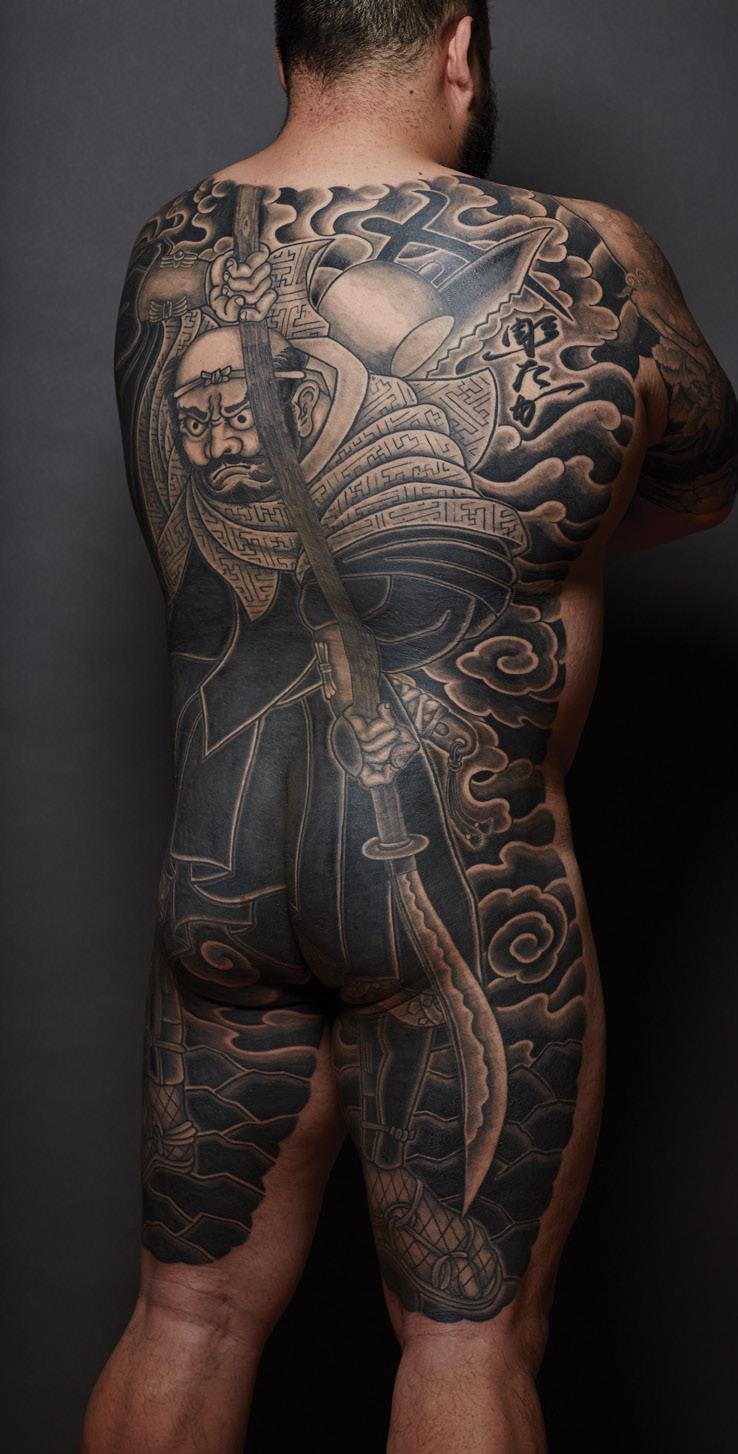
When the day arrived to meet his hero, Taki came fully prepared and bearing gifts. He gave a bottle of whiskey to Horiyoshi III and a Tiffany necklace to his spouse. As Taki said, “I feel like my parents, one of the ways that they raised me was manners. In the Japanese tradition, when you visit somebody, you bring a gift. And I’m not stupid—I’m not going to forget the wife.”
Still, it was somewhat of a surprise when—after their sec-
ond day of tattooing—Taki was invited to dinner with Horiyoshi III. And then welcomed to visit the studio early and just hang out. “So I get there the next day,” said Taki, “and I drew my ass off. Immediately I just took his drawings and redrew them in my sketchbooks, because in Japan it’s a very big thing where in the beginning, you copy your master, you copy the classics. And then at some point he says, ‘Hey, can you help me with these?’ and he hands me a stack of letters. So I spent all day answering fan mail.”
Thus began a decade-long apprenticeship, with a few in-person visits a year and a continuous correspondence via fax. Taki received the training to uphold Horiyoshi III’s legacy—and in return, the disciple would bring this practice to the Americas. “When there’s stuff like this master-apprentice kind of thing, the apprentice is looking to learn something—but how useful are you to the master?” said Taki. In his case, it seemed like the teacher and student were a destined match. “My master wanted to go global, but he didn’t know how. And then, I came through the door.”
A scant four years into his career, Horiyoshi III pushed Taki to start his own tattoo shop—State of Grace. “Oh man,” said Taki. “I’ll be honest; I think opening State of Grace was really challenging because at the time, I just had no idea what I was doing. I just knew I had to open the shop. We didn’t really think about it. We just went and did it.”
In the 18 years since its inception, State of Grace has become
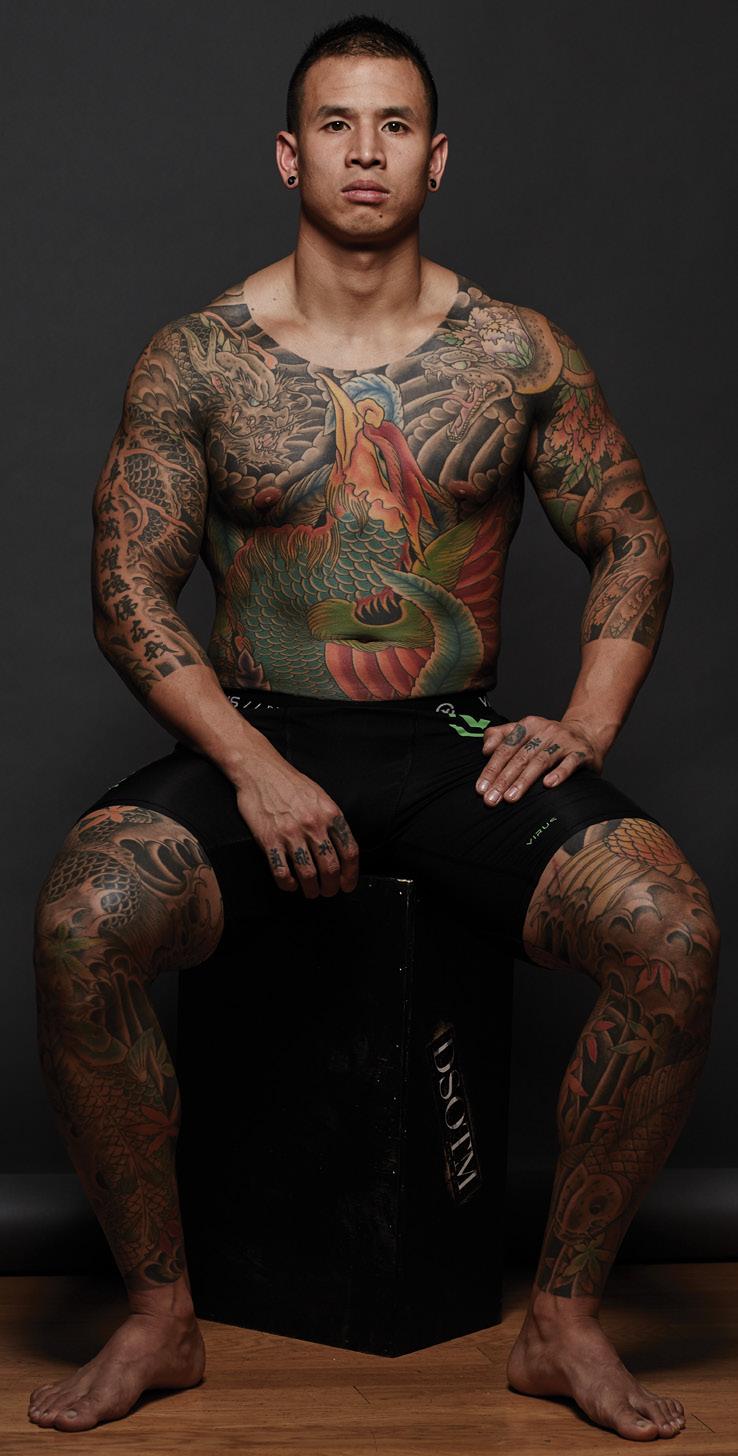
38 Discover 13.1
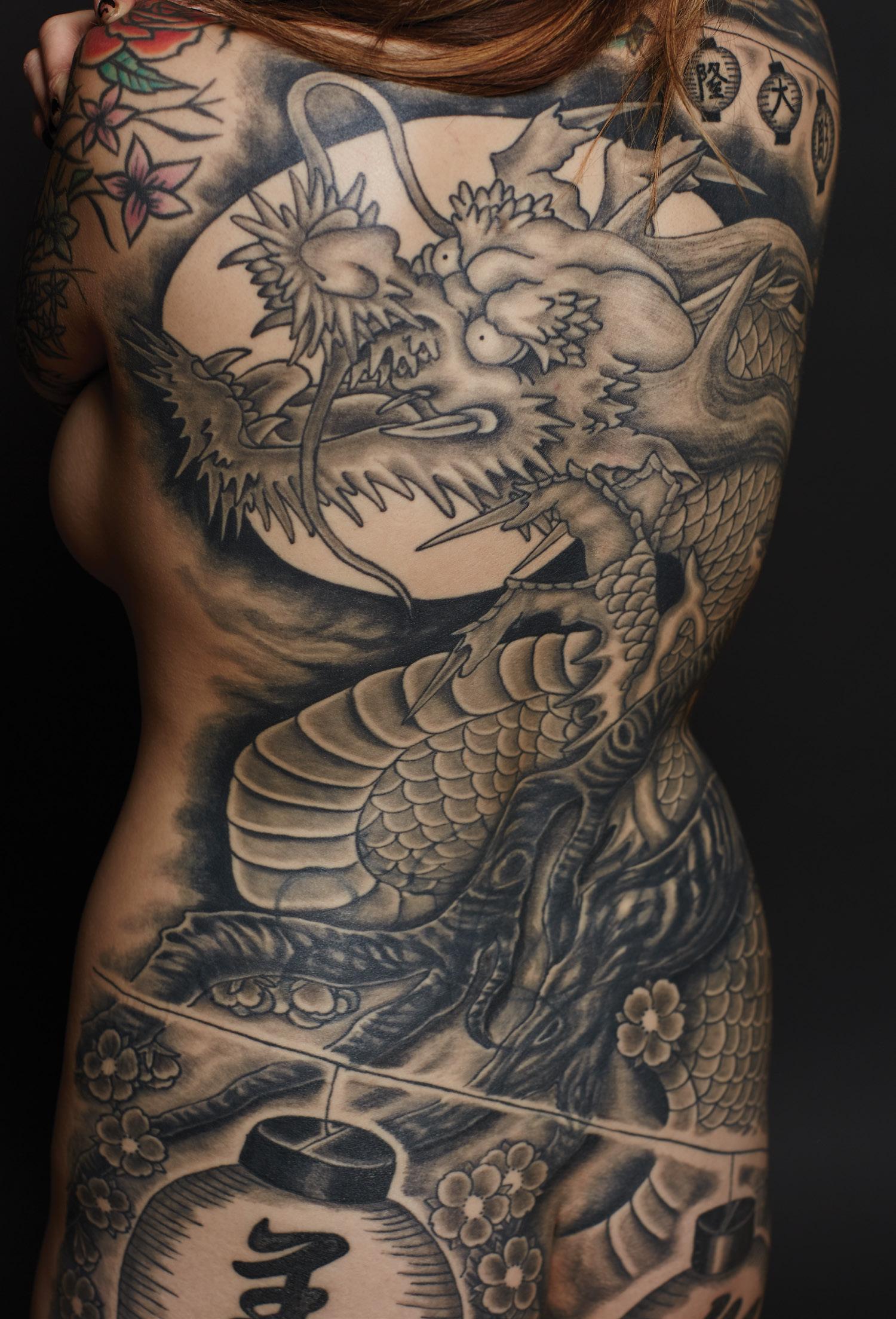
39

a true reflection of Taki’s values. The crew is small and familial, with seven artists on staff, including some who earned green cards based on their exceptional abilities. The space is minimal and clean, with lots of blonde wood and natural light—intentionally reminiscent of Shinto shrines and temples. The location is both accessible and just obscure enough, nestled amidst the small businesses of San Jose’s Japantown, atop a flight of stairs that almost shroud the shop in secrecy. “It’s amazing—those stairs will just cut so many people,” said Taki, with a chuckle. “We don’t have sale signs, we don’t have Groupons, we don’t do Friday the 13th promotions. We only want to work with serious people. If you want what we put out, it’s the friendliest place you can be in.”
But if you really want to know what this shop is about, look no further than the richness in its name. “I think ‘State of Grace’ is what we are all searching for,” said Taki. “We all need to feel that balance, fulfillment, peace—whatever you want to call it.” It’s about straddling two seemingly contradictory sides, and bearing that tension with thoughtfulness, dignity, and respect. For Taki, it’s about being Japanese enough to receive his master’s teachings, yet American enough to start an enterprise in the West; being grateful to his parents for his strong work ethic, yet rebellious enough to follow a controversial path; being hungry for the next challenge, yet finding ease in exactly where he is—most likely in his second-floor shop, crouched beside a client, working on his next tattoo. C
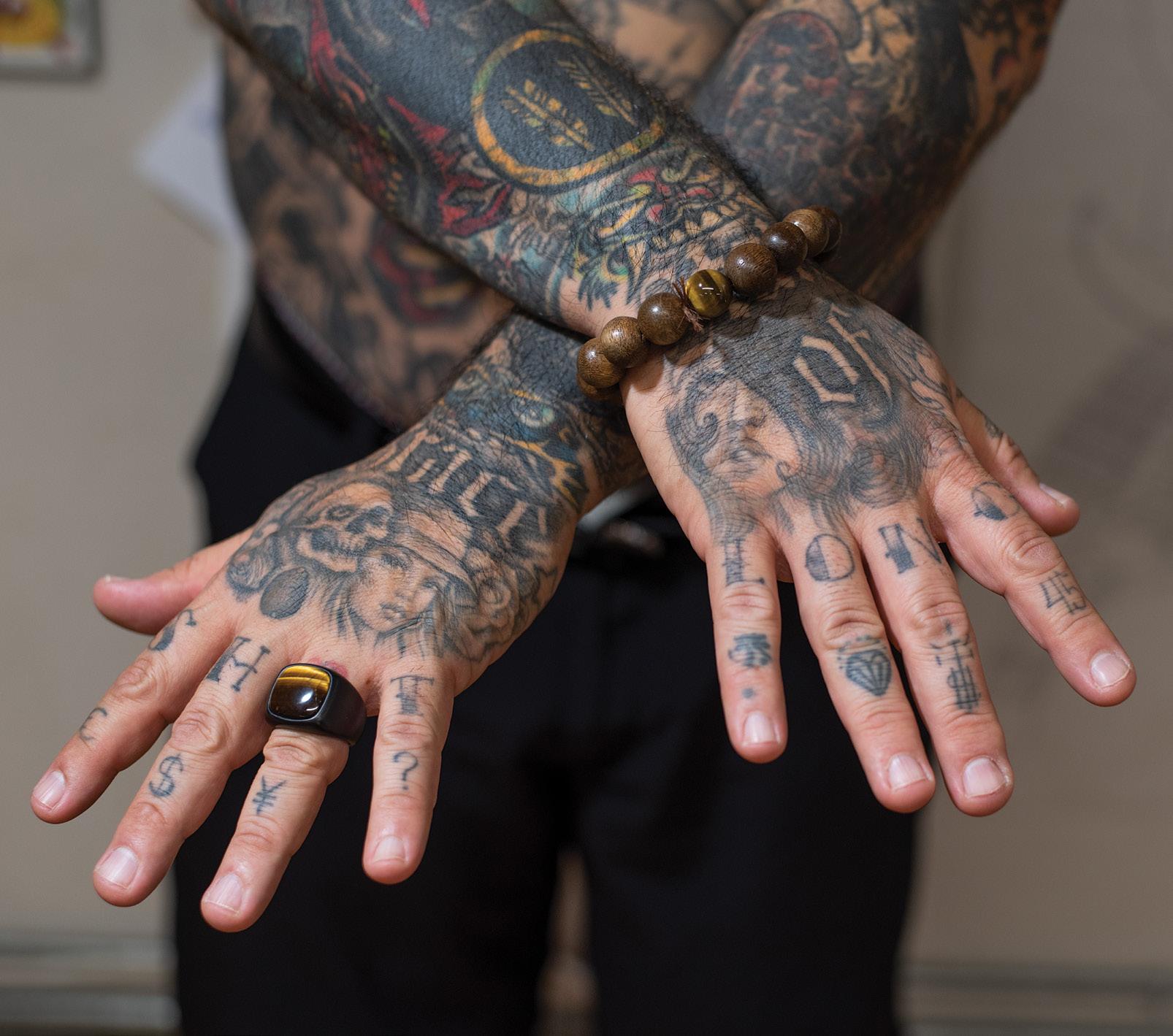
“I think ‘State of Grace’ is what we are all searching for. We all need to feel that balance, fulfillment, peace—whatever you want to call it.”
41
-Taki Kitamura
t.w.five
Artist Duo Brightens the World with Colorful Vinyl Art
Collaborative artist duo t.w.five works exclusively with adhesive-backed vinyl, using the medium to create everything from small canvases to large-scale wall art—colorfully depicting people, environments, and abstract shapes at festivals, in public spaces, and brightening the environment of numerous office complexes around the Bay Area.
Both immigrants (one from Brazil and one from Sweden) graduated from San Jose State University (at separate times). They met through the tight-knit South Bay arts community and soon began an informal collaboration that would eventually lead to their artistic partnership. Now based in San Francisco, t.w.five has had residencies at the de Young Museum, Headlands Center for the Arts, and the Kala Art Institute, among others; has exhibited work worldwide; and produced commissions for offices, billboards, and recently at the UCSF Precision Cancer Medical Building. They are now based out of a studio in San Francisco.
Written by Nathan Zanon
Photography by Daniel Garcia twfive.net Instagram twfive
Can you describe a little bit about your background and your journey into becoming artists in the Bay Area? How did you find each other to become collaborators, and how did you wind up working in vinyl, specifically? Both of us graduated from San Jose State, but years apart, so we first got to meet through some common group of artist friends from the South Bay. Our collaboration started without us knowing it, with a trip to New York City, with only one Canon camera between the two of us. We spent our time walking around neighborhoods all over the city and taking some photos that we thought were pretty nice pictures. We both have different art backgrounds, but we realized that we shared the same aesthetic in how we viewed things around us.
42 Discover 13.1
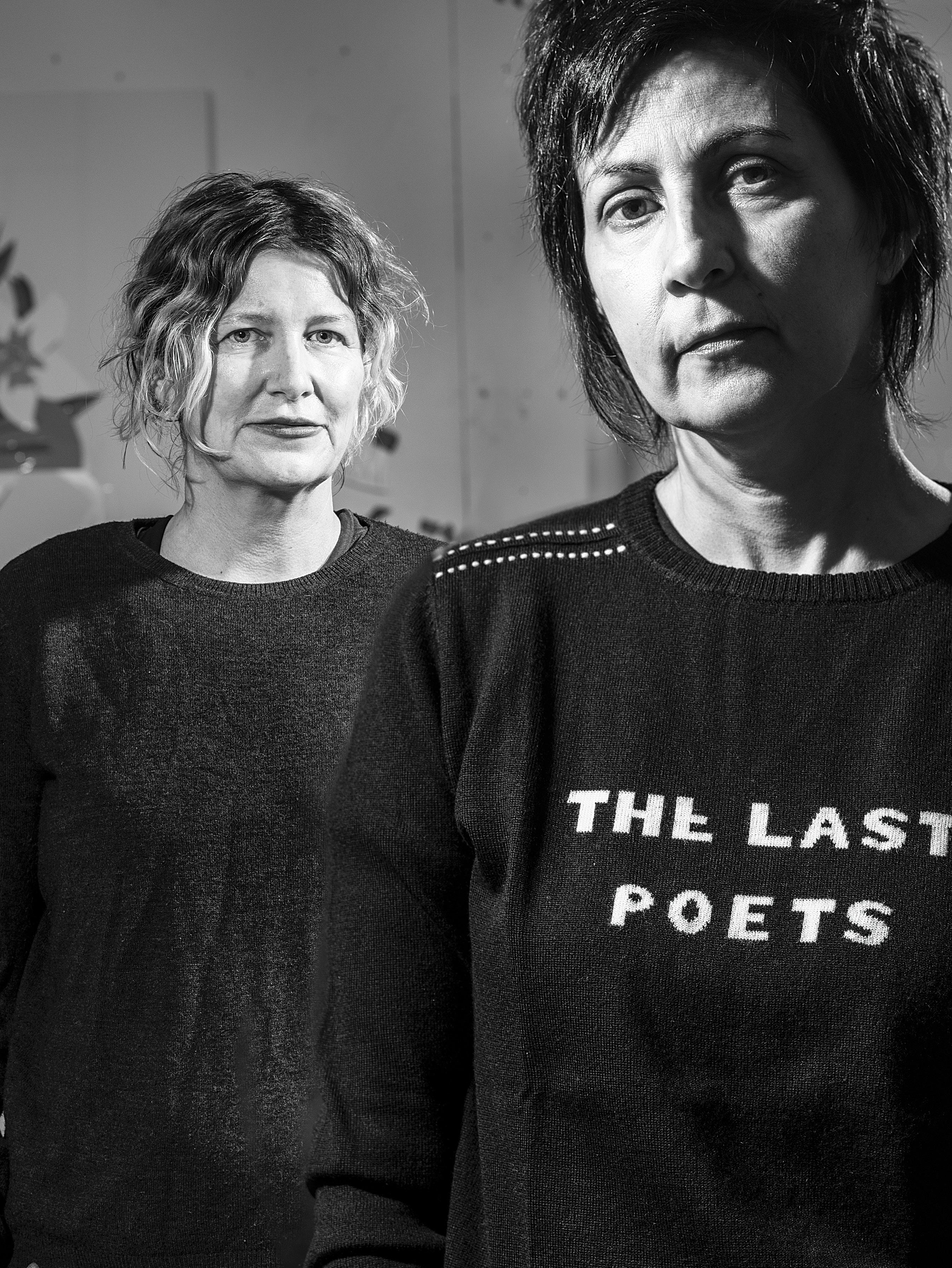
43
Pernilla Andersson Paula Perreira
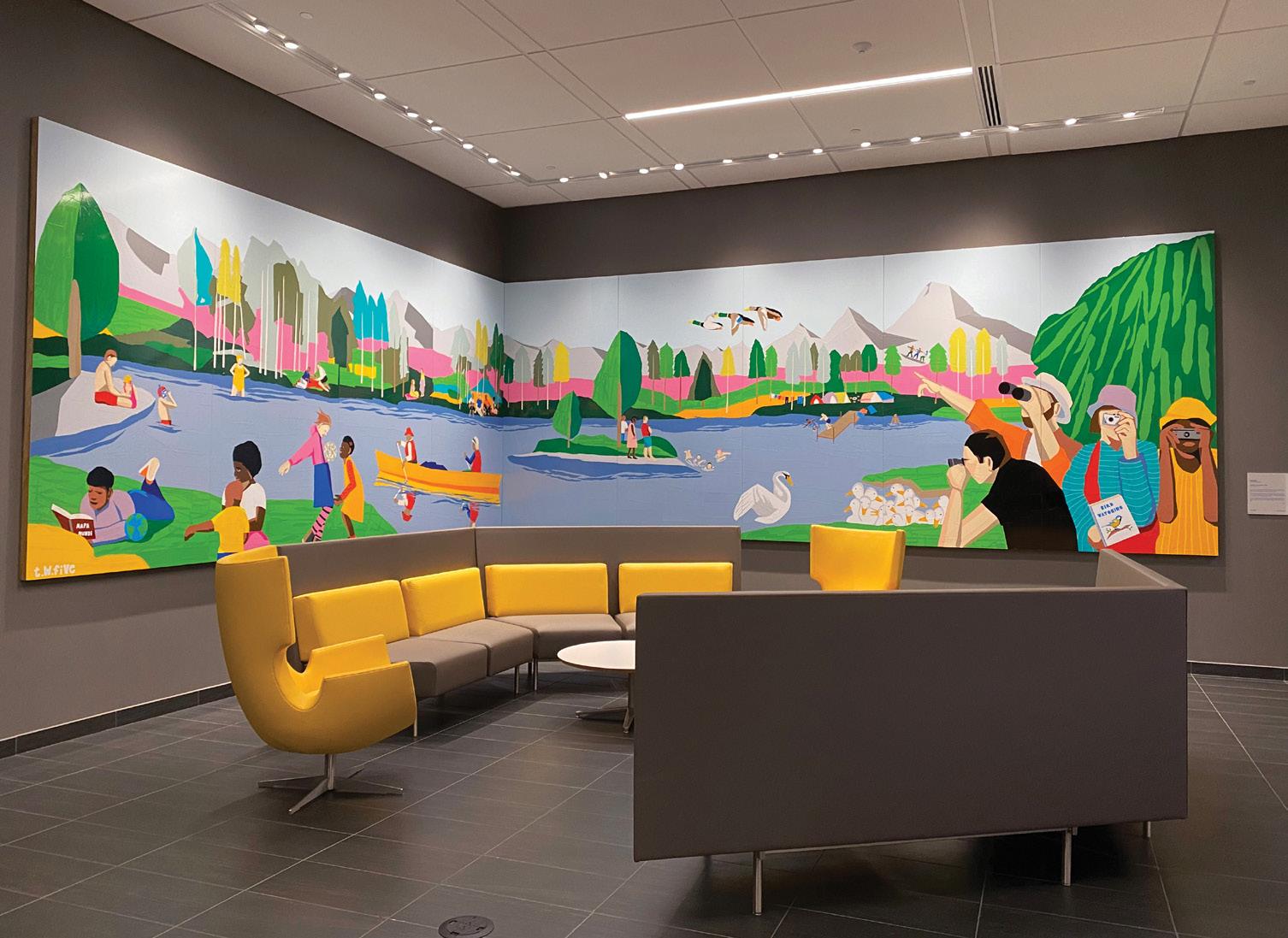
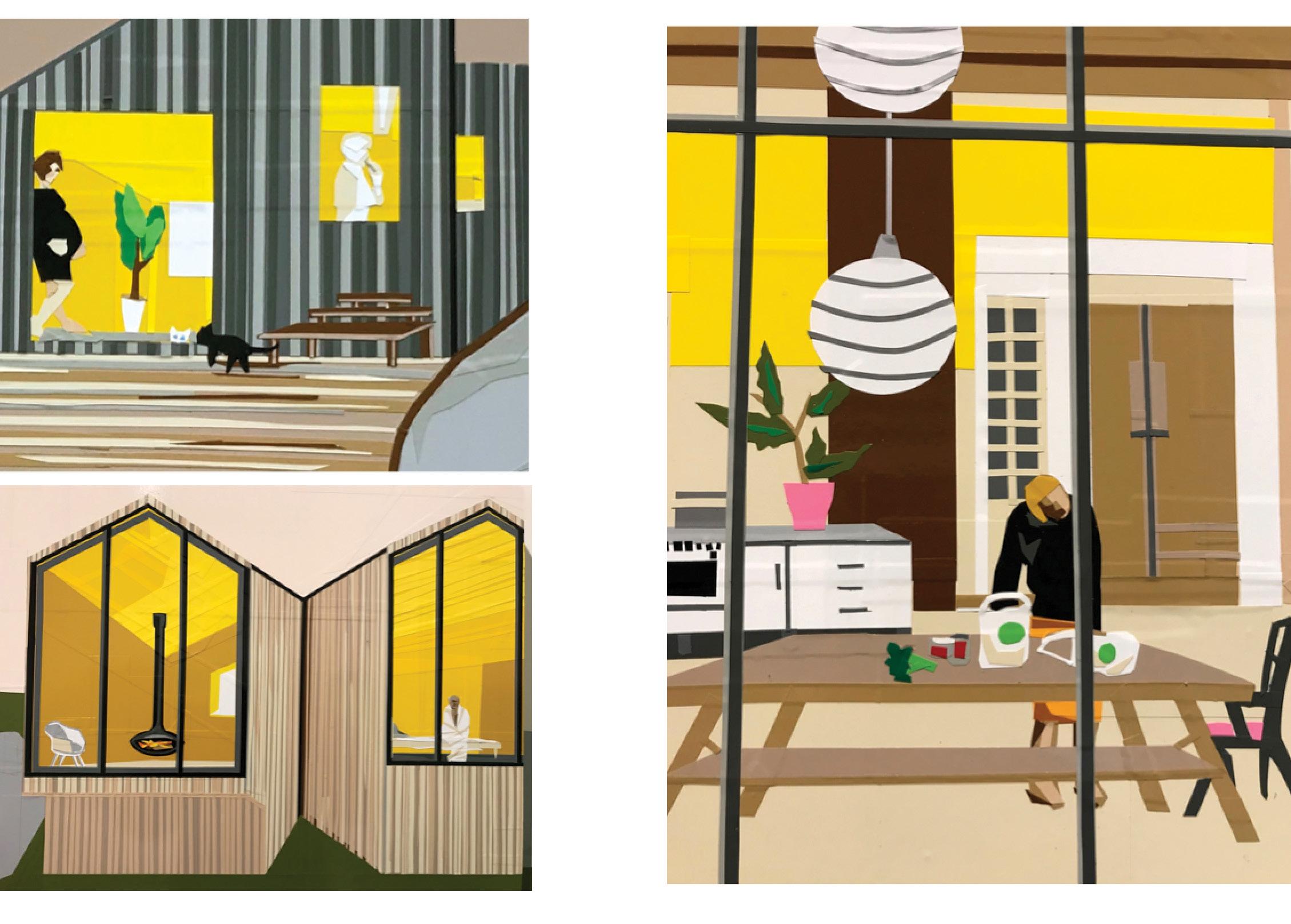
When arriving back in San Francisco, one of us needed to use some of the photos from our New York trip for an upcoming show. From that, the idea of us collaborating came up. But [it] was alien to both of us, since we both have always created art in solitude. We were also aware that our personal art styles are very different from one another, as well as our material choices, one of us being photographer/screen printer of urban culture, [the other a] painter that practiced expressive, mostly figurative/landscape paintings. Needless to say, we decided to give the collaboration a go, and it was the first time we introduced adhesive rolls of vinyl as our primary material.
Who and what are some of your biggest influences and inspirations? That’s the thing. Since we both came from different backgrounds, we also have
different artists that we liked and shared between us. We will say, anything that came out from the Bay Area figurative movement from the ’50s and ’60s—David Park, Richard Diebenkorn, Elmer Bichoff, Nathan Olivera, and Joan Brown, also a HUGE inspiration from Andy Warhol that we can never get enough from, and the Bauhaus movement of combining craft with art. We also love looking at architecture, design, street art, Pop Art, Brazilian concrete art and poetry, Japanese contemporary art, Cy Twombly, photography, music—lots of it—film, and filmmakers like Wes Anderson, Neill Blomkamp, Lukas Moodysson, sci-fi…
What are some of your favorite pieces you’ve created or experiences you’ve had creating and exhibiting large-scale art works? Tough question—it is hard to pick out favorites. But we have a special love for a 44-foot piece we did for the Headlands Center for the Arts benefit auction in 2016. The piece is called it’s all fun at 2:15 am and was based on the dynamics and a moment being in an art studio. We used multiple images from Warhol factory, which we made into our own composition and colors. This piece is now part of the Facebook collection.
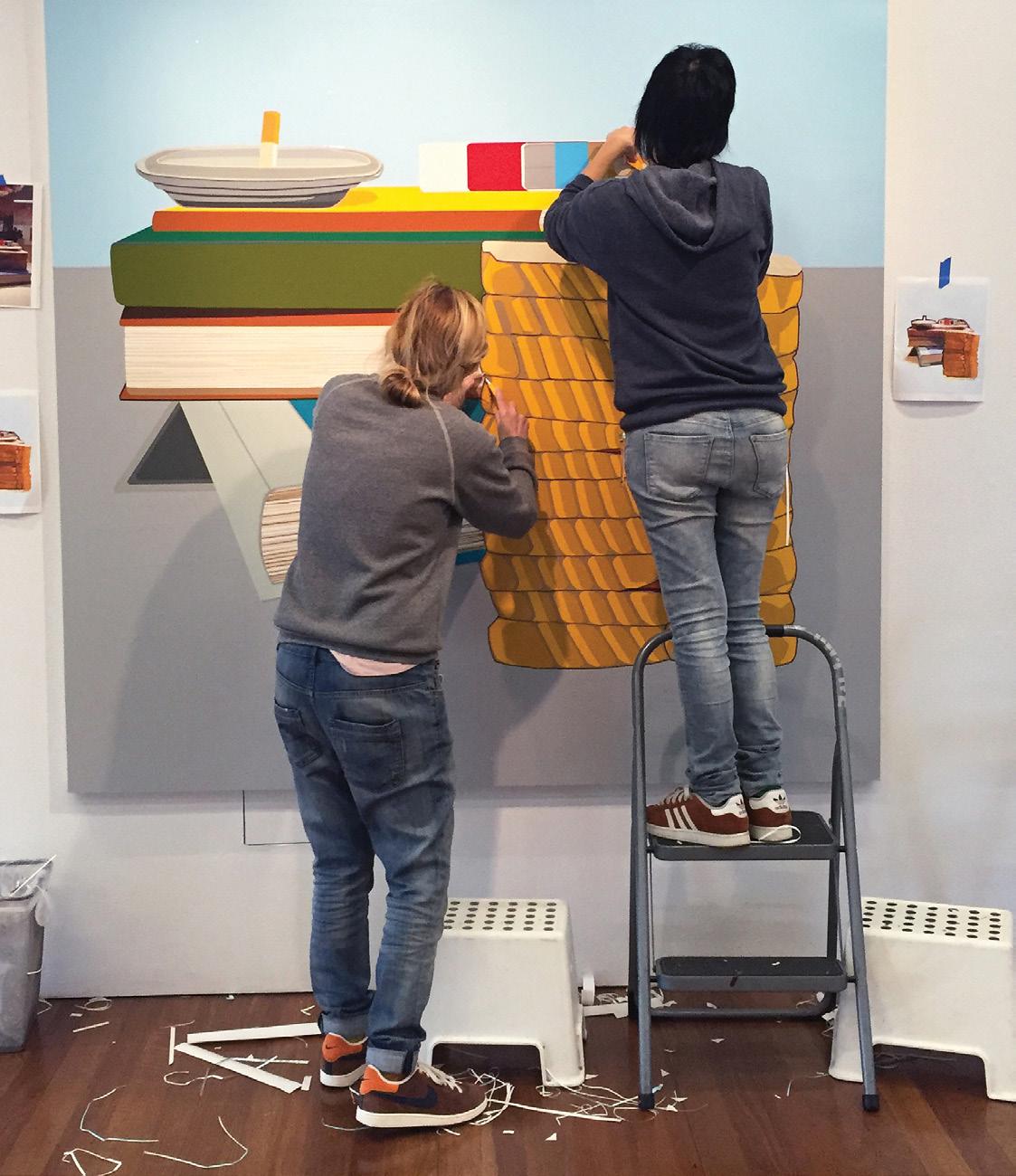
We love so many. Making each one is a unique experience that we dive into completely.
We finished a six-floor commission at UCSF’s new cancer wing at Mission Bay. That commission was a year and half of meetings with the board, the architects, and designers. It was a lot of learning. Every single step of the way had to be looked at and approved because we were dealing with a sensitive audience: the patients. It was a beautiful journey for us.
45
This Page: The t.w.five duo installing piece at the de Young Museum
Opposite Page:
(Top) UCSF Colorful Landscape, 36 ft
(Bottom) Museum of Craft and Design installation in 2018. A landscape with an apartment complex “sculpture” with houses that you can see through the windows. They explored private and public space.
Detail, “Summer of 78”
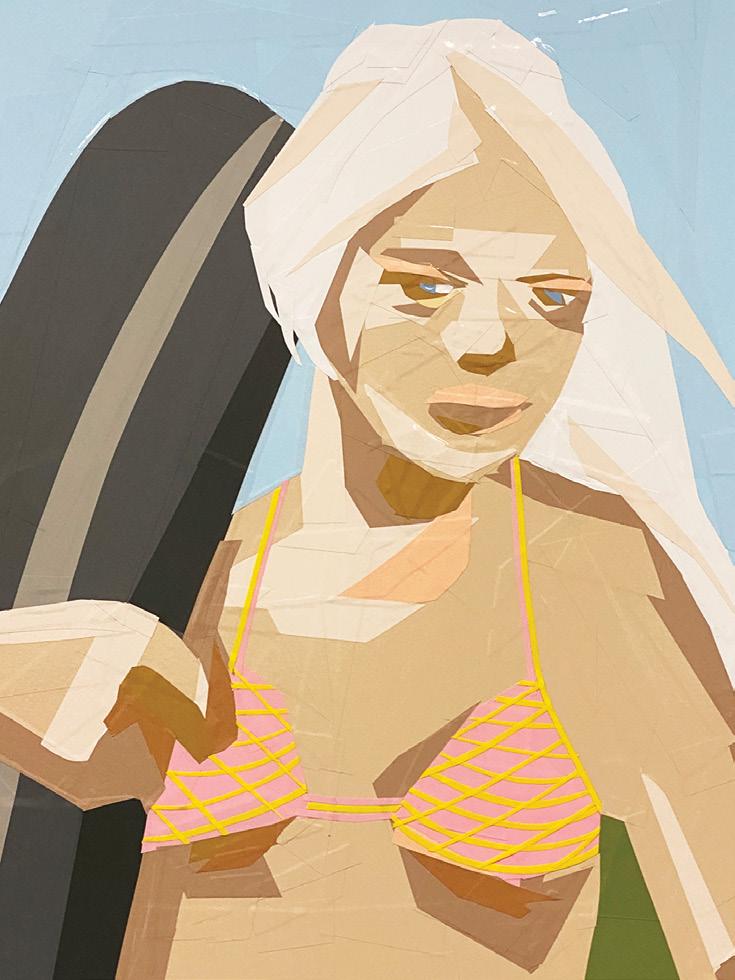
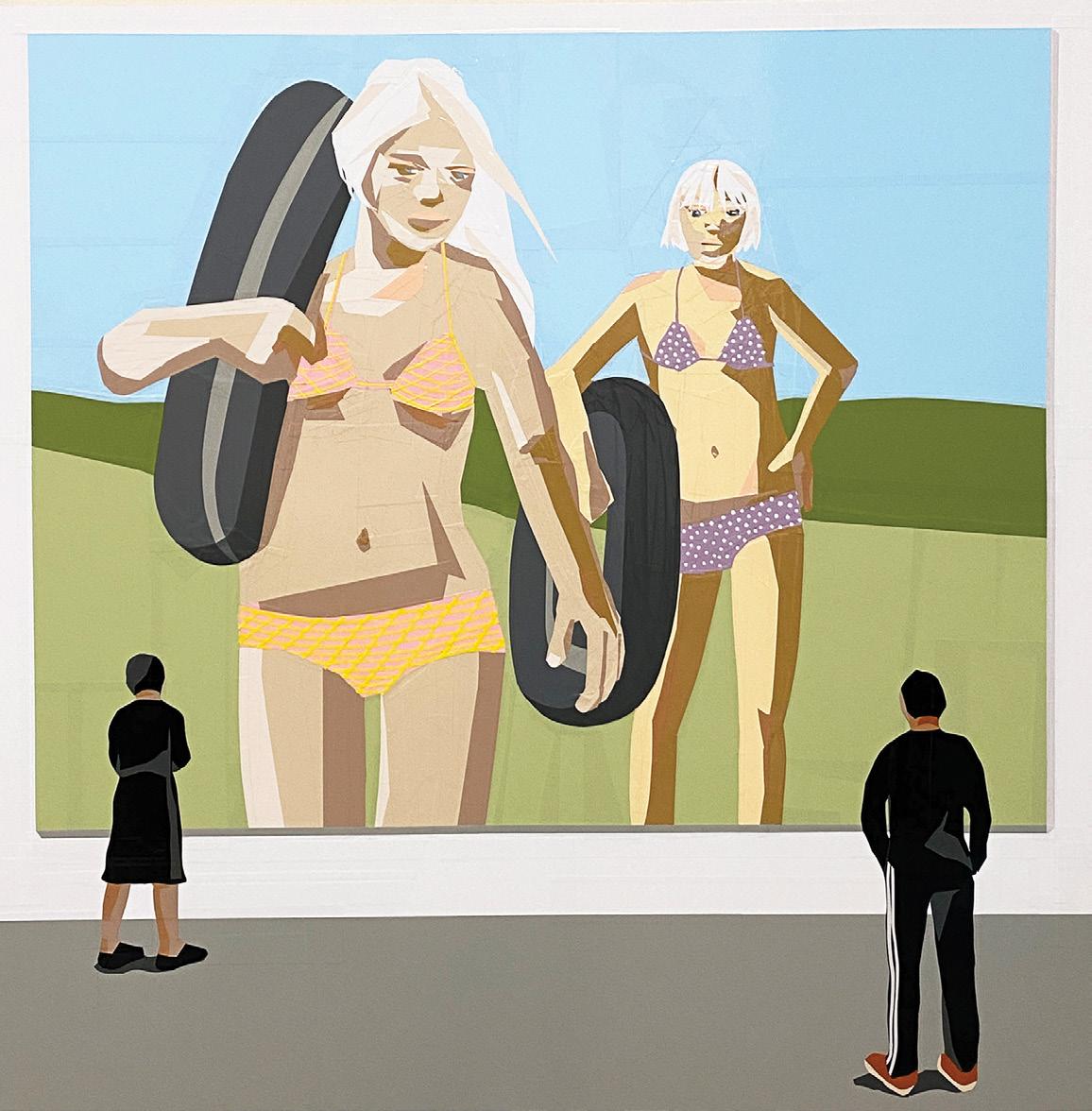
46 Discover 13.1
“Summer of 78”
“We work on different parts of the artwork together and then we switch. When we step back to look at the work, we always like and dislike the same things. It’s incredible how our minds work together in such harmony.” -t.w.five
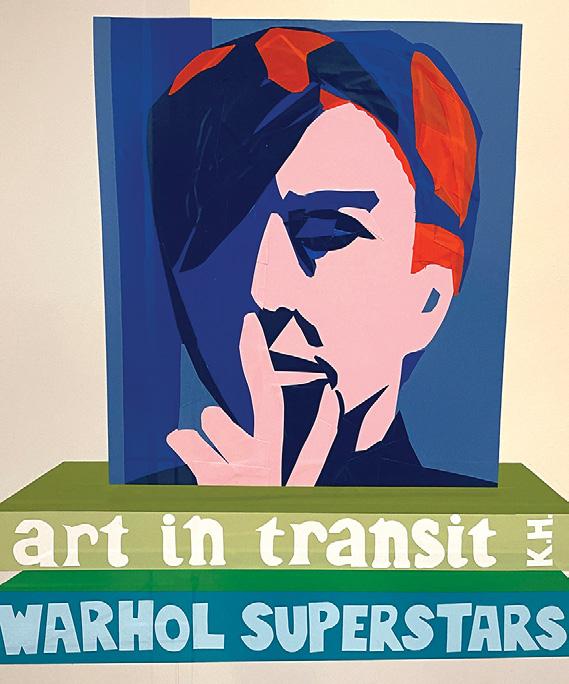

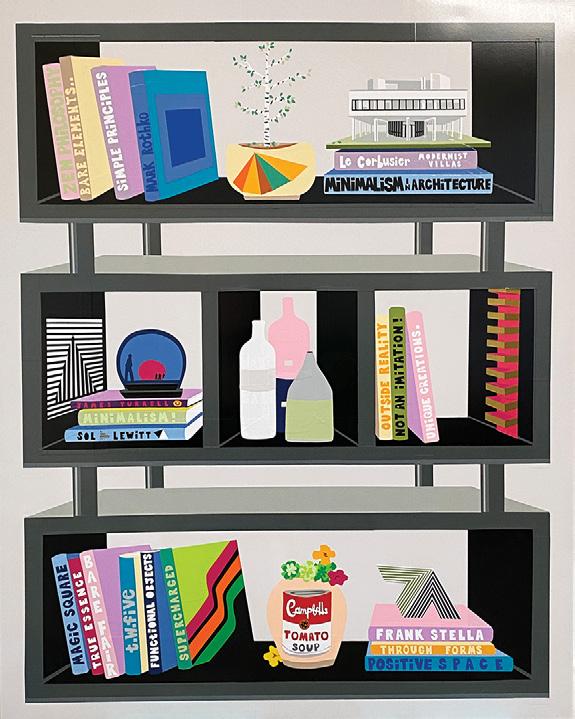 “Black Minimalism Bookshelf”
“White Bookshelf”
“Black Minimalism Bookshelf”
“White Bookshelf”
47
Detail, “The White Bookshelf”
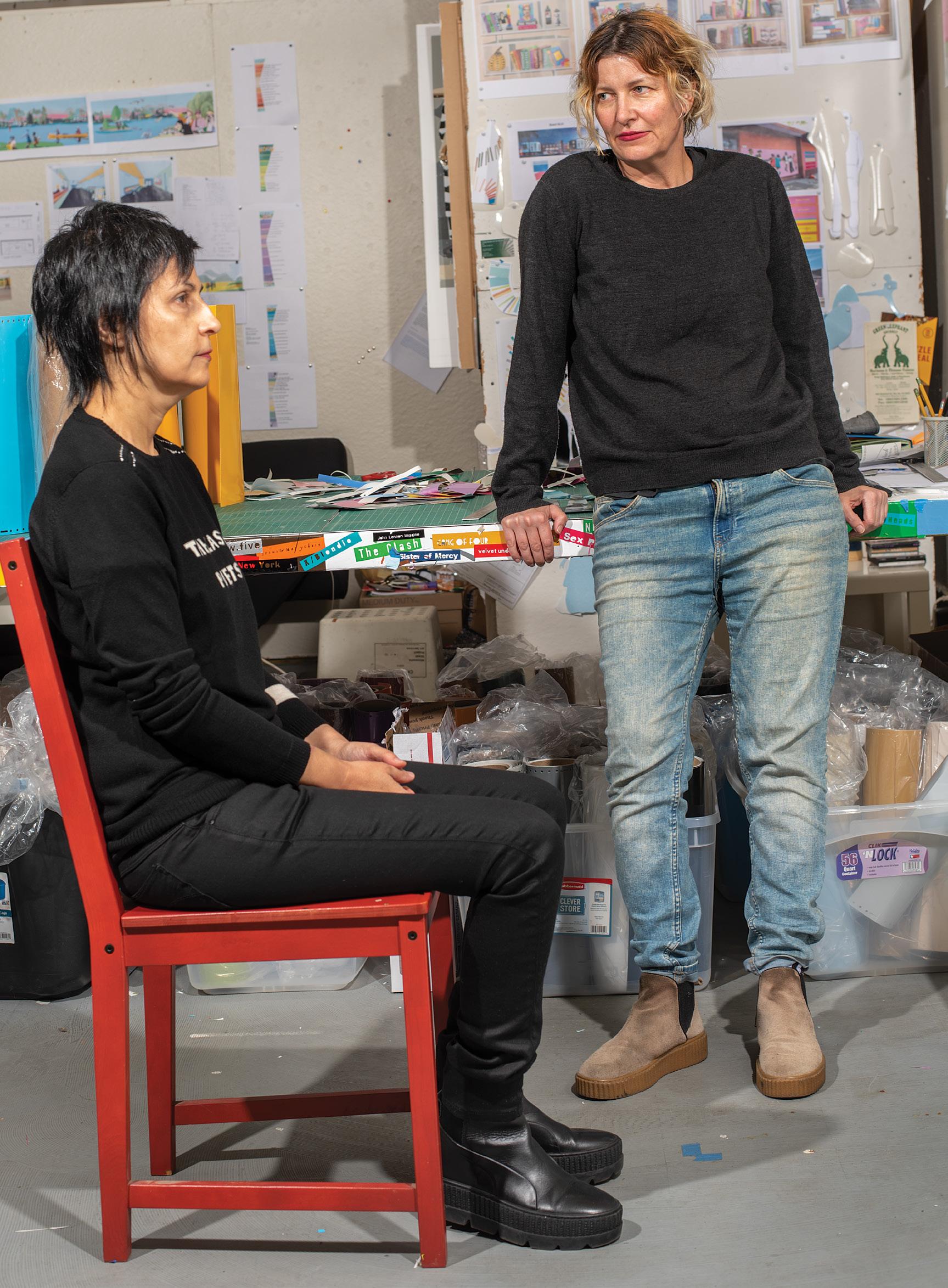
48 Discover 13.1
You’ve also been commissioned to create works for some of the tech giants of the area. How did these come to be, and what were your experiences like? Yes, we have done artworks for Google, Facebook, GoDaddy, Checkr. The GoDaddy piece was the only one that we did at the company and straight on the wall. All the others, we did the majority of the work in panels at the studio and then installed at the headquarters and did some add-on there. That is the part we love, because we get to interact with the workers and hear their opinions and feedback—and be part of their culture, too.
Usually, once [companies] contact us, we go to meetings to exchange ideas about what they envision. We always try to bring to the table our ideas that we can see it incorporating into what they want. With some, we have absolutely had freedom to do what we wanted, and those are super fun.
How would you describe the way you conceive of and create your pieces? How does your collaboration work? Do either of you focus more on specific elements of the creation process? The ideas come from things we are interested in or something we see that inspires us. We both bring our ideas to the studio and show them to one another and feed on each other’s ideas and inspirations.
Once we are set on the subject, we start to look for images on the internet, read and research a lot about it. After we find the images, we work on them a bit on Photoshop—adding colors or subtracting things in the image we don’t want, etc. Then, if the work is big, we project [onto a surface] just to get the basic outline of things, then turn off the projector and improvise everything. We do everything in vinyl, and it is all hand-cut. The only tools we use are an Exacto knife, scissors, and ruler.
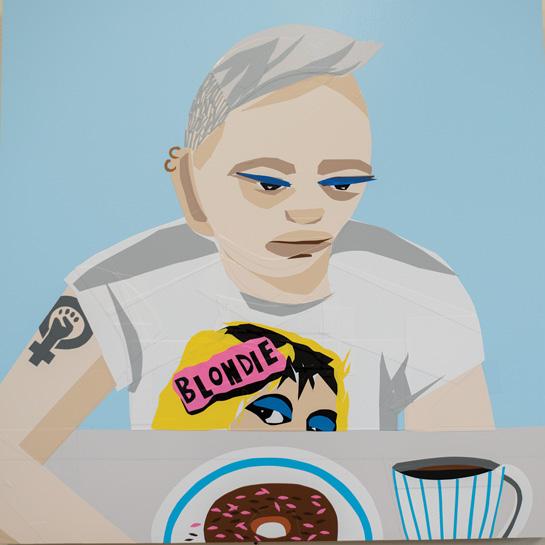
We work on different parts of the artwork together and then we switch. When we step back to look at the work, we always like and dislike the same things. It’s incredible how our minds work together in such harmony.

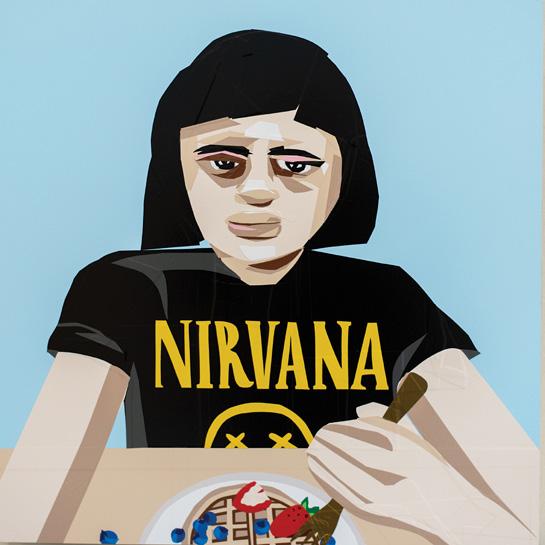
How has the time of COVID-19 and shelter-in-place changed your process or perspective as artists, if at all? First, it was a bit of adjustment, but then we both turned to our studio as much as we could and started to work all the time. It was actually what kept us sane to navigate through these new, different times. All our exhibitions and commissions got either canceled or postponed. So, we had to figure out other ways to promote our work or apply for new projects. But it turned out that we found a lot of inspiration and ways to communicate with fellow artists or our collectors via Zoom. C
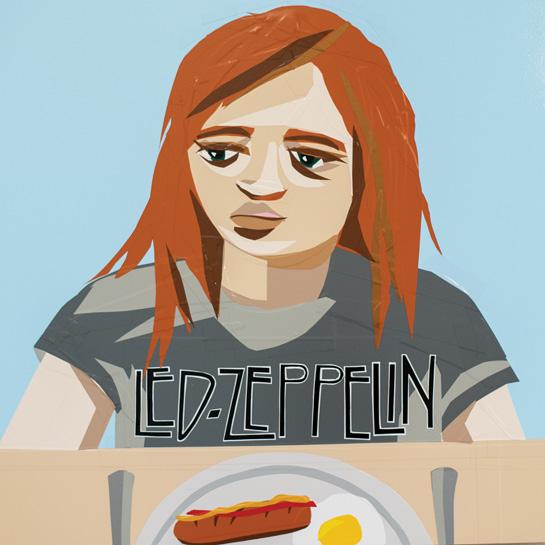 Above pieces are from a series that depicts an intimate morning scene of individuals eating their breakfast while wearing their favorite band shirts.
Clockwise:
Above pieces are from a series that depicts an intimate morning scene of individuals eating their breakfast while wearing their favorite band shirts.
Clockwise:
49
Led Zeppelin; Nirvana; AC/DC; Blondie
SOUTH BAY STYLE
Designer: Ivan Torres, @fuckthecollective
Photographer: Peter Salcido, @peter_salcido

Stylist: Tyler Lynch, @tylerlikesartnotfashion
Model: Donovan Smith, @tsaiyoshto
50 Discover 13.1

Ivan Torres reveals his inner being through the power of style. This series projects the designs of his subconscious brain splattered on sweaters and pants. For Ivan, creating garments is an outlet where he can let go of stress and feel free to accomplish anything. When in the creative process, he takes into account every detail to reflect how he truly feels. C
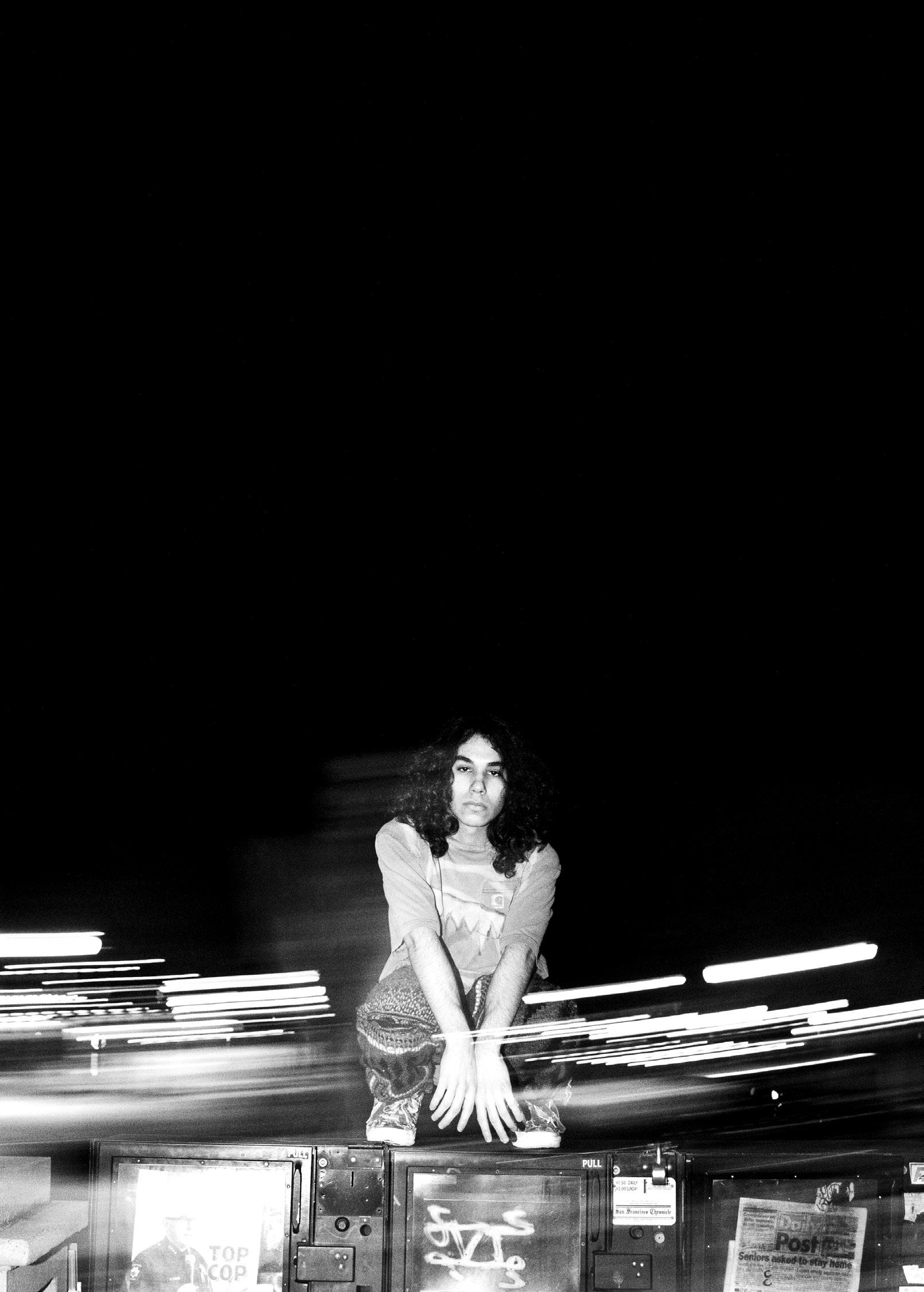
“Creating something beautiful and twisted in a way, it’s why I tend to stick to street wear because it can be so rough around the edges but if it has a clearly beautiful look to it then it will show.”
-Designer Ivan Torres
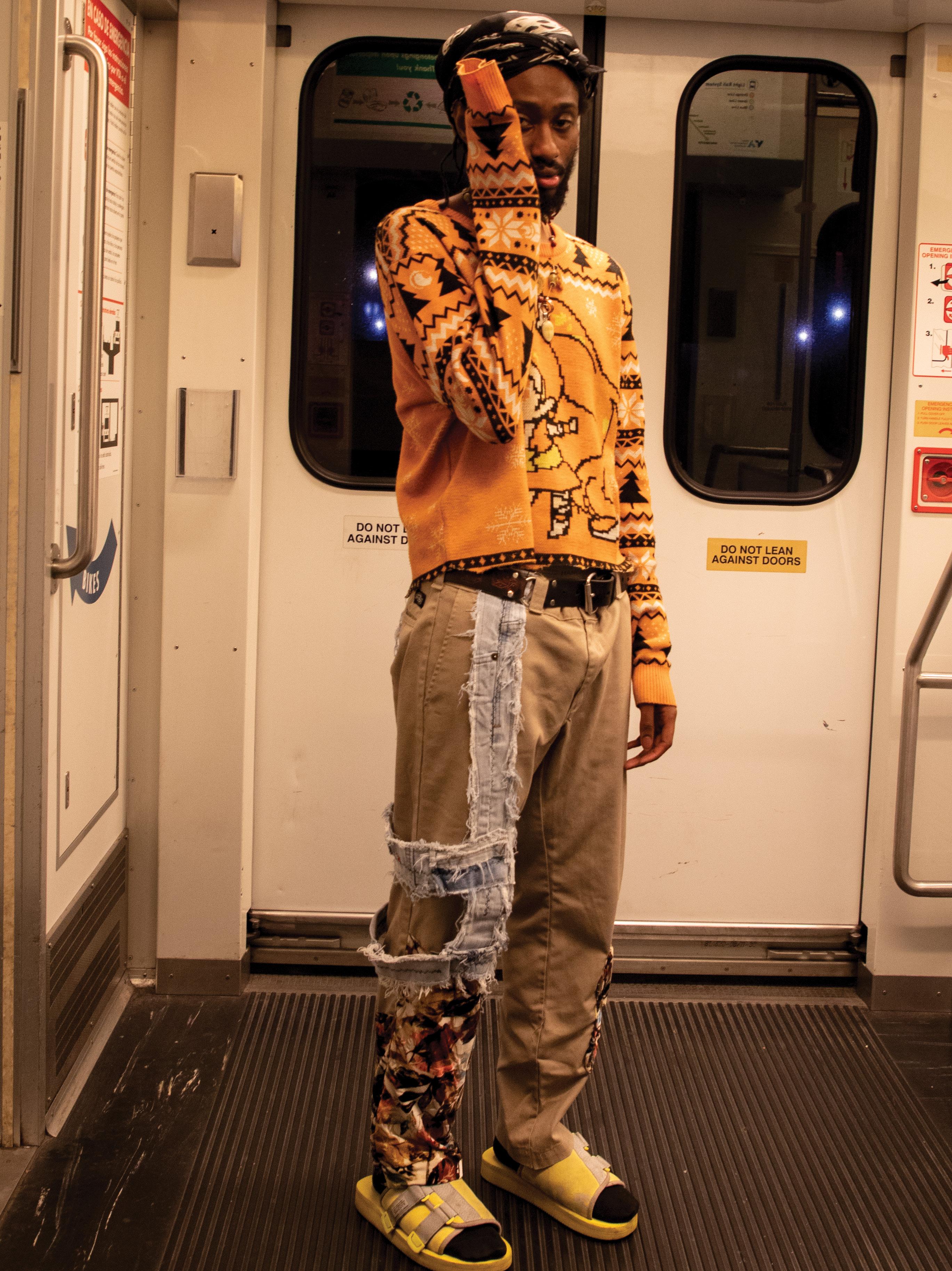
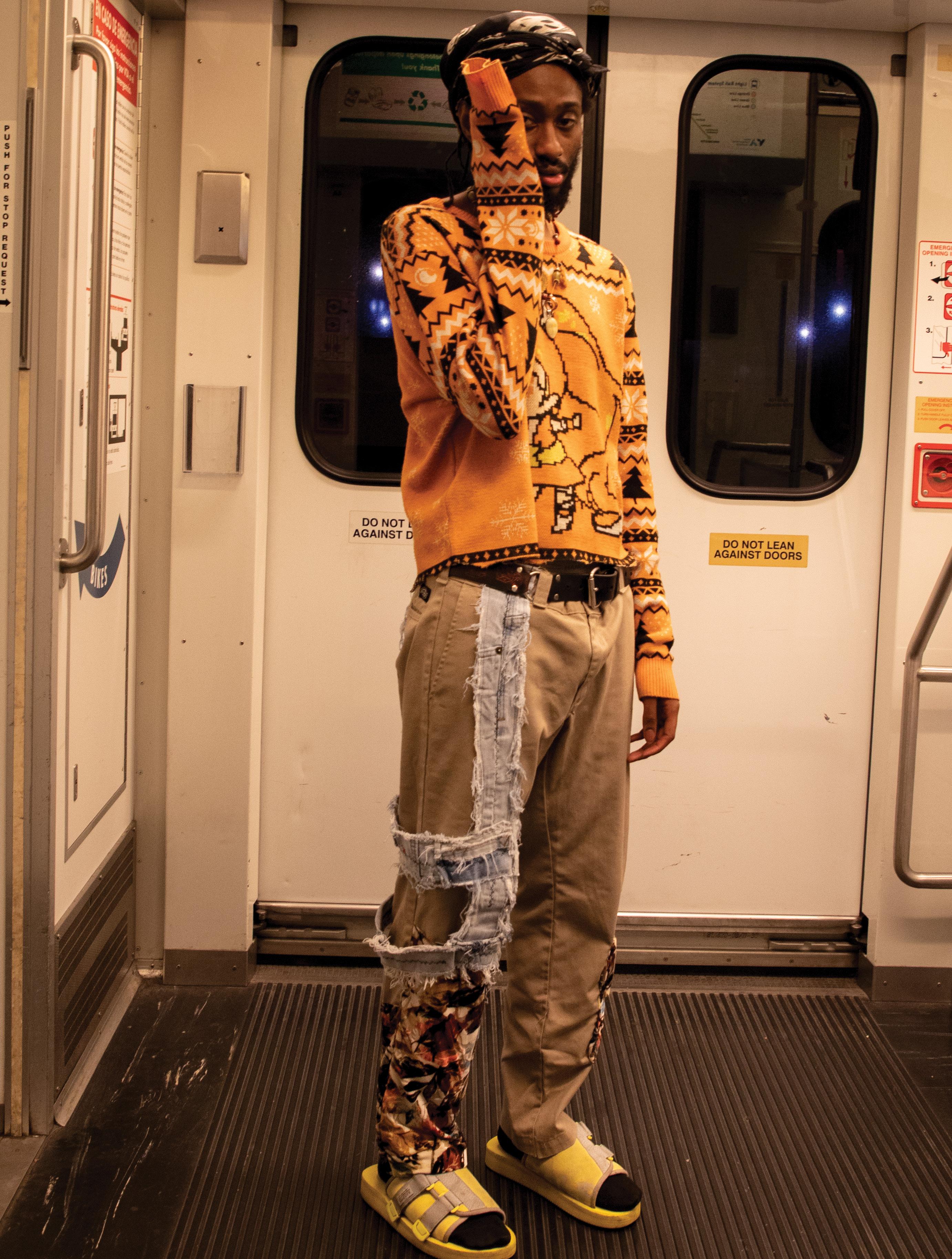 Pants - Liellede Transiit, $45
Pants - Liellede Transiit, $45
 Pants - Stacked Roses, $60
Pants - Stacked Roses, $60
 Sweatshirt- P1 V.S. P2, $80 Pants- The Sultan, $80
Sweatshirt- P1 V.S. P2, $80 Pants- The Sultan, $80

56 Discover 13.1
poet
Written by Johanna Hickle
57

Janice Lobo Sapigao BEGINNINGS AND ENDINGS
Photography by Daniel Garcia janicewrites.com Instagram janicesap
Lately, two topics seem to be on the mind of Santa Clara County’s latest poet laureate, Janice Lobo Sapigao: death and childhood. Though “beginning” and “end” might seem polar opposites, they’re closer than we often give them credit for.
Sapigao’s poems—renderings of raw transparency accentuated with potent, visual details— dialogue with both these topics in her latest book, like a solid to a shadow. “If every woman has a grave deep inside her,” this Filipina American writes, “Then mine is my father’s / A four-cornered stone that holds my focus / My last name etched in cement.” The ink of her concluding lines fades away like the lessening of an old scar, with words to match: “I have learned to love him / By holding tight and letting go.”
Reflecting on the book’s creation, Sapigao shares, “I was writing through a lot of healing from when my dad passed away. Because even though he passed away when I was six, I didn’t really have time to process until I was an adult.”
Loss struck once again this April when Sapigao’s mother died after a two-year battle with cancer. “I want to say goodbye with more time than I’m allowed,” she shared on social media. Writing again became a part of her grieving process, though this time through a different form of literary creation—a young adult novel.
This semi-autobiographical work in progress will be about a girl dialoguing with her present and past self. Sapigao explains, “The older self is trying to figure out, ‘What do I do if I’m going
to lose my mom?’ I like this idea of having two selves talk to each other about how to heal and how to grow and how to make meaning from the time they do have together.”
Although it has certainly been restorative through this season, Sapigao started her young adult story as a college student. At the time, she was researching youth culture extensively, deepening her understanding of how it develops and how it shapes urban spaces.
“I think youth have this sort of pulse on what’s going on in different facets of society,” she says. Sapigao also believes that while society often discounts the younger generation, teens continue to find new forms of expression. The evidence of this statement is scrawled across history. The beatniks turned
to jazz and poetry, the hippies to love beads and tie-dye, the Gen Z-ers to TikTok and social media.
These days, Sapigao gives students a chance to speak and to seek through her hip-hop education and research class at Skyline College. She’s also bringing it to her work as poet laureate. Beyond organizing writing workshops and creating a college fund to honor her mother, she’s using her term to establish a youth poet laureate program. With the support of the Santa Clara County Library District, schools, and nonprofits, she hopes to amplify the voices of South Bay students between the ages of 13 and 19.
This youth poet laureate will not only connect with other young poets across the country, but he or she will vote with
“I just want people to know that there’s still meaning in all of it, so I hope my work captures that.”
58 Discover 13.1
-Janice Lobo Sapigao
Anything But Country
after Al Robles for anyone who answered this when asked, “What kind of music do you like?”

i 59
the kids in middle school slam books and later in online profiles

where they were asked explicitly all of them were right on it. like a needle to vinyl. like a hand waving and swagging in the air on the dancefloor lit by strobe lights those kids with the baggy pants and fresh kicks the girls with highlighter on skin in their hair on neon on nails so precise they could pop you they knew trust was an R&B slow dance
they believed the promise of a breakbeat, hip hop akin to counting us all in. they knew belonging was if you could do the dance if you could spit the lyrics if you got us the tickets to the nosebleed section of the arena and if someone’s guardian dropped us off. we knew this belonging to the rhythm of a room
good music is a conversation a memory from a microphone we knew
as adolescents or young adults
our loyalty was to this sound to friendship. to radio dials. to mixtapes and playlists the remix to citizenship was one where we could all get in no bouncers. no covers. a statehood of song of sound. no papers. only the notes of our bodies. anything but country would save us would include our voices would legislate the fullness of the lullabies of our languages anything but country anything but the silence of nation anything but law to lead us back to each other a swarm a record on repeat a compact disco a country of company not business a country of anything but itself in its current state.
ii
the rest of board in selecting the next adult poet laureate.
Sapigao expects them to lend a fresh set of eyes. After all, they have yet to be influenced by the elaborate philosophical arguments many grownups use to justify their artistic choices.
“They’re going to be the ones to teach us,” she notes. “And they’re going to be the ones who tell us to listen.”
Sapigao also points out that younger minds, like good poets, tend to be persistent question askers. “Our youth poet laurate is going to have a lot of questions for us. And we have to answer! If we don’t answer, even the silence really provides that answer.”
Because of the visibility of the position, Sapigao expects this future youth laureate to engage with current issues
(like BLM, for example), “[to be] someone who is not only a writer, but writes for their communities in ways that uplift them and create that sort of social impact,” she elaborates.
Her accomplishments in literary advocacy gained Sapigao her own poet laureate position. Her style, something she describes as “documentary poetics,” reports on real-life struggles. It blends personal accounts with headlines, academic research, and interviews. “Writing, for me, is political and emotional and necessary,” she shares on her website.
Take her poetry collection microchips for millions. Influenced by her mother’s experiences as a Filipina immigrant and as a Silicon Valley assembly line worker, Sapigao wades into tough topics like immigration,
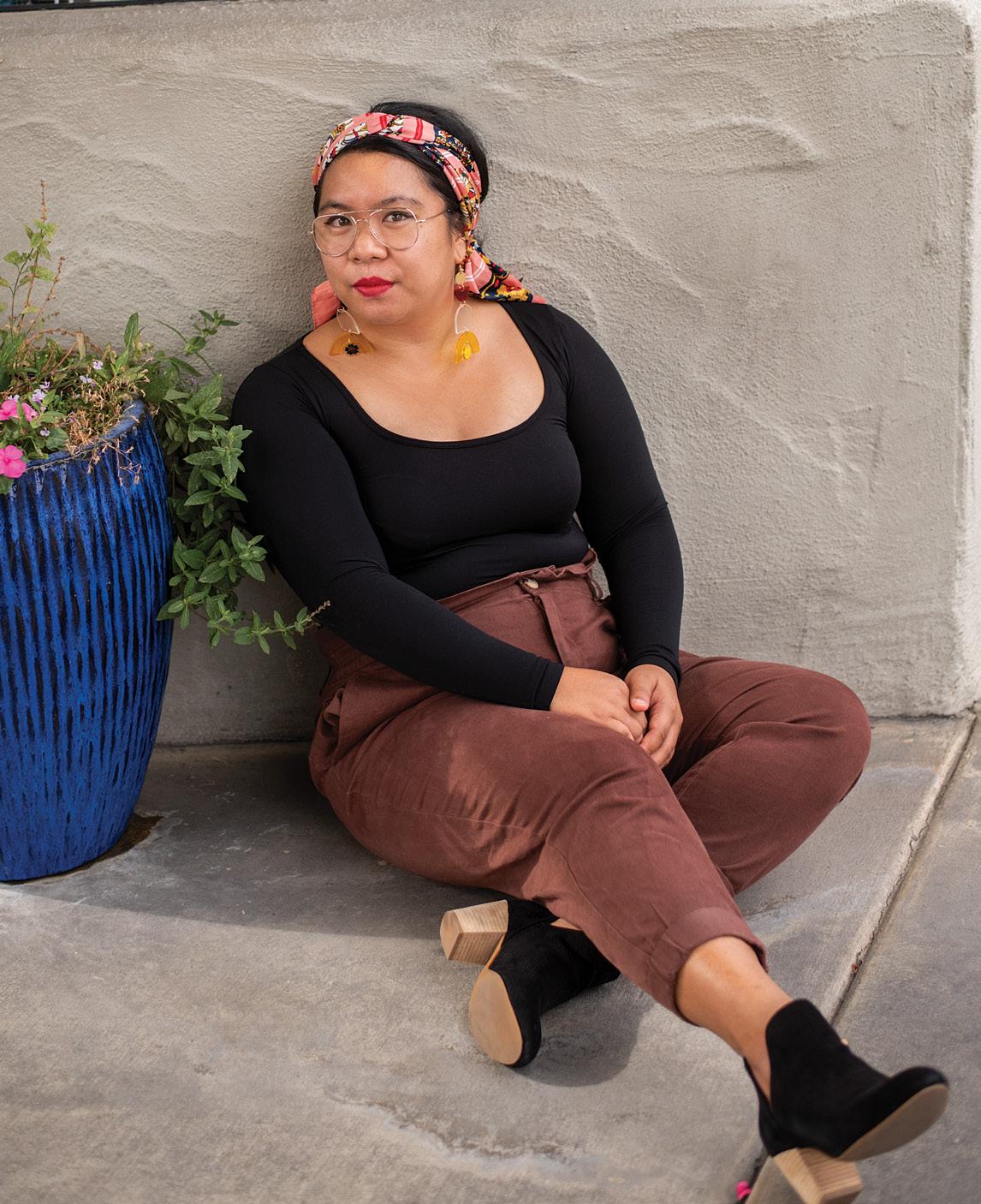
language limitations, and the exploitation of women.
In one of her poems, she pleads with her mother, “tell them that i ripped your beltloops when i was six / clawing onto you because i didn’t want you to go to work that day / tell them about how starting your shift is a sentence and / punching out your timesheet is freedom.” It’s these kinds of pinpointed moments (and not sweeping overviews) that carry the sting of heartbreak. Indignation is in the details—because when you’re close enough to see the angry raw blisters or the collapsed arches of feet succumbing to too many 12-hour shifts, it’s much harder to look away.
This, interestingly enough, brings Sapigao back to bereavement. “For me, death really feels like injustice. When some-
one passes away and they’re gone, there’s no closure, there’s no resolution,” she describes. “With activism and with understanding different social injustices, I know what that feels like because it’s something that happens without your say. There’s just no control or any kind of consideration.”
Even with her fascination with the endings of things, Sapigao maintains her liveliness. She understands beginnings and endings slip into each other’s domains—like wildflowers pushing through the ground of a graveyard, like trees uprooting in the flush of springtime. “I just want people to know that there’s still meaning in all of it,” she shares, “so I hope my work captures that.” C
61
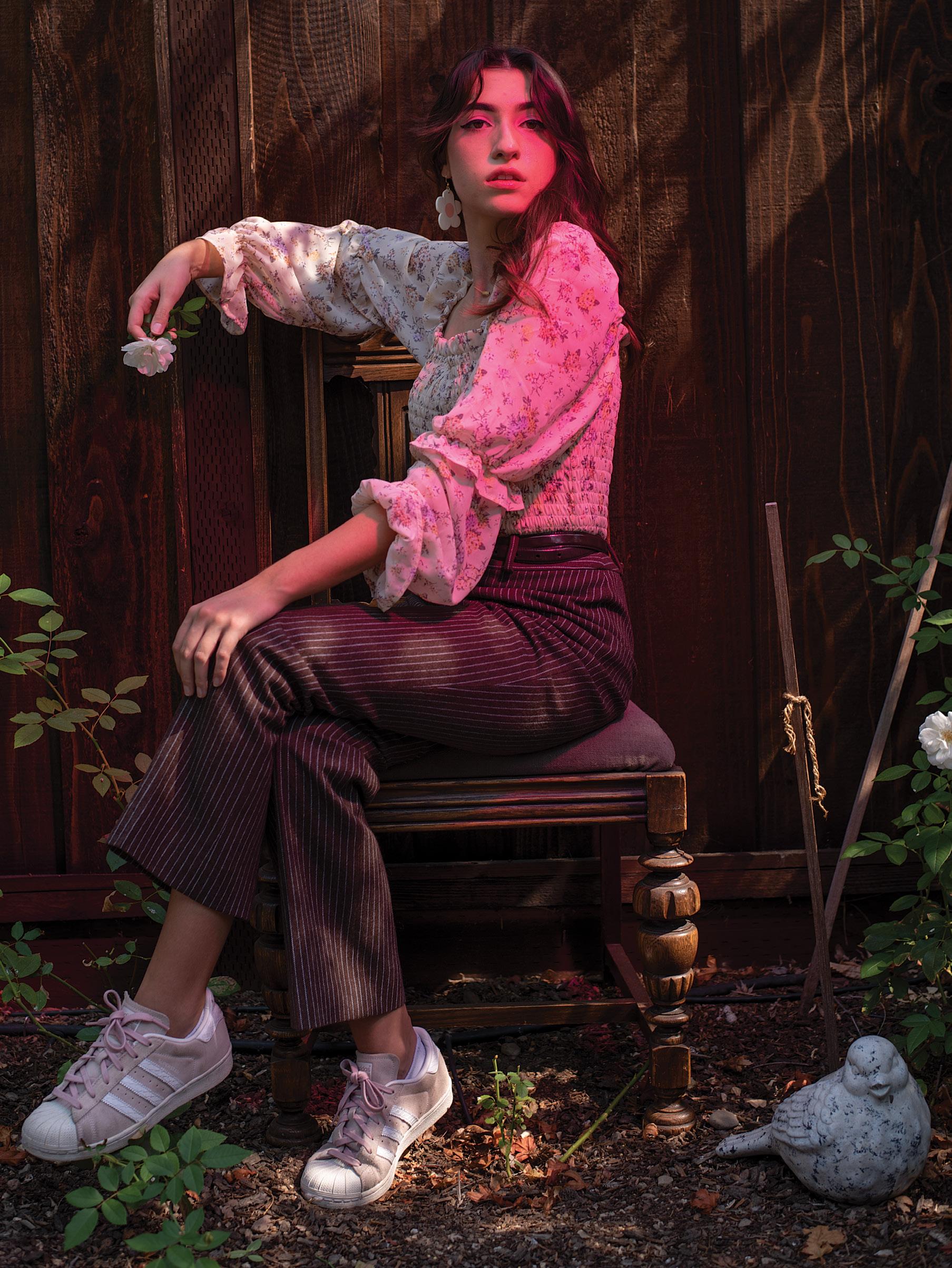
62 Discover 13.1
Planttvibes
Written by Brandon Roos Photography by Daniel Garcia planttvibes.bandcamp.com soundcloud.com/planttvibes
JULIA BOZZO’S CREATIVITY IS INCESSANT.
It jumps off the 19-year-old’s Instagram page, her art direction a sunbleached amalgam of photography and graphic design. It extends to her album covers, conceived and completed by herself. And it shows up in the artistic progression of her music as Planttvibes, born from SoundCloud covers and now bearing the varied sensibilities of both Chet Baker and vaporwave.
“I consider myself an artist in almost every way,” Julia shares via socially-distanced FaceTime. “I have a deep desire to be better at that every day. I just really want to be good at creating, whether that’s music, painting, drawing, [or] making earrings.”
Though she had early training on piano from her grandfather, Julia’s musical breakthrough came when he purchased her a pink ukulele for her birthday. “I was the annoying girl in middle school that brought her ukulele to school. I hate it, but it happened,” she kids. “[The ukulele was] my introduction to actually playing and experimenting with music and writing my own stuff. I had a lot of fun teaching myself.” Five years ago, she started by uploading covers to SoundCloud under the name Planttvibes—“It just sounded cool and hipster. It was the era of Tumblr.”—and has maintained the moniker ever since.
Her influences come from all over the place. Jazz has been a longstanding inspiration, though she similarly loves Tyler, the Creator, the early work of singer Joji, and Japanese city pop. Her wide palette seems to suggest that influence can be found anywhere. That openness may also explain her by-any-means-necessary approach to recording.
The strength of Julia’s material as Planttvibes shines when you understand her distinctly DIY ethos. Her first two releases were assembled in GarageBand on her iPad, with her vocals captured through the mic on her headphones. SJ Come Up took note, writing in 2019 that Julia was “one of many young musicians taking the simple resources available to them and defining the genre/aesthetic known as bedroom pop.”
As Planttvibes, Julia Bozzo’s music rises from a DIY ethos in a digital music world.
mthrmercury
planttvibes
Instagram
Twitter
63
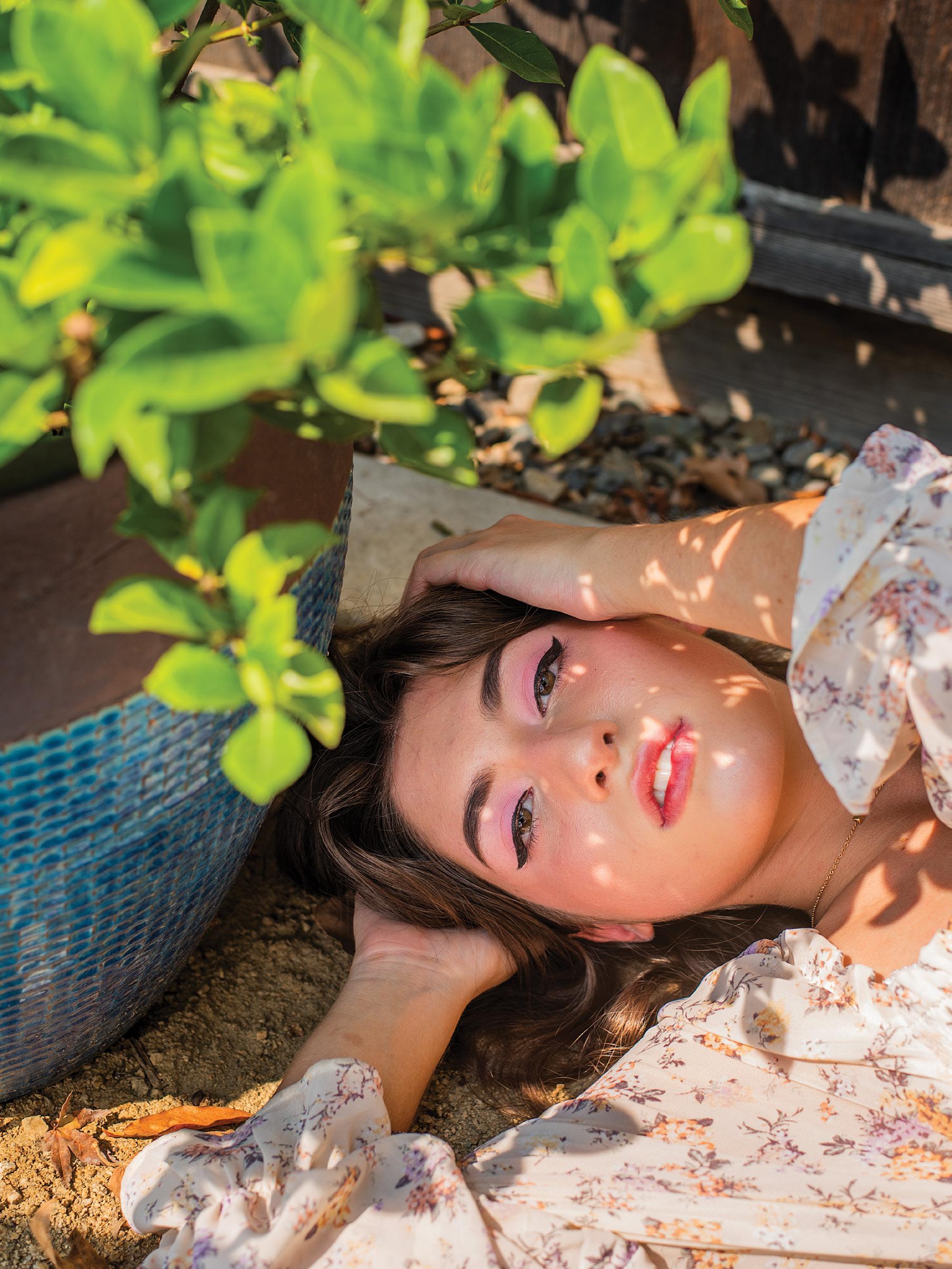 –Julia Bozzo
–Julia Bozzo
“It’s very slightly more high-tech,” Julia says when asked about upgrades to her setup since the release of A Summer in My Dreams (2018) and Nip It in the Bud (2019). She’s added a performance mic to her arsenal and switched to GarageBand on her laptop.
Last fall, she started studying graphic design at CSU Monterey Bay, but the change of scenery—and the addition of roommates— didn’t make for fruitful creativity. Her catalyst actually turned out to be COVID-19 shutting down her campus. Once home, she quickly got to work. Most of the material on Bedroom, released in May, rose out of those first few months in quarantine.
The new six-song set shares quaint stories of love, heartbreak, and longing, recalling the spirit of ’60s girl group pop. Her sound hasn’t dramatically changed, but the songs themselves feel tighter. There’s still a fascinating sunniness accompanying her contemplation, led by the ethereal quality of her reverb-dipped vocals, stacked and harmonized.
“Just a Dream” displays Julia’s penchant for earworm melodies, with a chorus that flows forth breezily between sustained chords and lo-fi programmed drums: “And I’m staring at my ceiling just waiting and feeling sorry for myself / But there’s nothing I can do to get away from you in my subconscious / And I can’t forget the way your soft, sweet touches feel upon my chest / But was it real at all, or just a dream?”
Her lyrics, often detailing moments of sapphic love and longing, inform an effort to create greater visibility through her art.
“I just want more people like me to have music that reflects their experience,” she notes, adding that her work has fostered some deep connections with her fans. “It honestly pays off, because sometimes I’ll get random messages from people saying ‘I listened to this song with my girlfriend. We love your music. Your music has helped me come to terms with myself.’ And that is really 100 percent worth it.”
“I wanted Bedroom to be this safe haven where this girl is sitting in her bedroom, and she’s singing songs and pouring her heart out to herself and her stuffed animals,” she says. It’s a notion perfectly captured on her album cover. The image may show Julia playing guitar on her bed alone, but her work as Planttvibes has helped construct that same safe space for others, offering compassion on their journey of acceptance and understanding. C
65
“I wanted Bedroom to be this safe haven where this girl is sitting in her bedroom, and she’s singing songs and pouring her heart out to herself and her stuffed animals.”

“I also pull inspiration from my mother’s Saturday morning cleaning playlist [from] when I was growing up, including Los Bukis, Los Brios, Bronco and many others.”
66 Discover 13.1
-Jairo Lomeli, lead singer / keys
Billing themselves as “four vatos from Modesto,” Valley Wolf are exploring the sonic possibilities of pairing punk and psychedelic rock with the Latin rhythms and mariachi tunes of their younger years.
Valley Wolf may simply describe themselves as “four young vatos from Modesto,” but their music contains a fascinating blend of disparate influences that reach much further than their humble description may suggest.
There’s rock. There’s punk. There’s traces of psychedelic rock and tinges of cumbia. Yet these various strains manage to fit into a singular package. Their story, and its sonic outgrowth, reveal a collective intersection of rock music and Latin rhythm.
“Growing up in a mariachi family, I pull a lot of inspiration from all the types of music played in mariachi, including huapangos, cumbias, and rancheras,” shares lead singer, guitarist, and keyboardist Jairo Lomeli. “I also pull inspiration from my mother’s Saturday morning cleaning playlist [from] when I was growing up, including Los Bukis, Los Brios, Bronco and many others.”

Valley Wolf bassist Fernando Barocio, who’s Lomeli’s cousin, admits the mariachi influence was hard to avoid. His father’s mariachi band would rehearse at his home while growing up. He later joined the group on trumpet, with his shift to bass a later development. Drummer Victor Alvarado’s journey started with hard rock and metal. He was drawn to the high-intensity playing he heard from groups like Rush and Slipknot. Over time, Latin rhythms were integrated into his repertoire.
Written by Brandon Roos
Photography by Milan Loiacono valleywolf.bandcamp.com Instagram valleywolf209
67
Guitarist Andrew Mendoza brought his own fusion to the group through an interesting connection he made between two seemingly dissimilar styles. “Funk has always been a big part of my musical identity. The attitude and guitar work of Kool & the Gang, especially the first album, is huge for me. I also pull inspiration from romanticas, and I love the similarities between those songs and funk music,” he shares. “The rhythms in both genres differ but the wah’s are the same.”
As the group tells it, Lomeli and Alvarado initially started playing together. While Lomeli was away on a trip to Costa Rica, Alvarado began jamming with Barocio. Once Lomeli returned, eager to get back to playing music, the three officially convened on Valentine’s Day 2016, starting work on what became their debut, self-titled EP.

Over the span of five songs, their influences slowly unfurl. “Bananana” is a forceful introduction of the variety of sounds to come, a compelling shot of psychedelic rock. The tremolo-laced organ carries a bite, and the rhythm section provides a cumbia-esque backbeat as the track shifts to three distinct movements over its three-and-a-half-minute run time.
The opening organ line on “Mordidas” recalls the iconic harmonica lead from Bruce Channel’s ’60s pop hit, “Hey! Baby.” That song and the one that follows, “La Perdida,” are the most direct nod to the group’s mariachi lineage. The middle of the EP brings the set from a boil down to a slow simmer. “Falcon Punch” finalizes the quick five-song run with an informal tinge. It feels like a peek into the initial jams that spawned this group, an allu-
“Funk has always been a big part of my musical identity...I also pull inspiration from romanticas, and I love the similarities between those songs and funk music.”
68 Discover 13.1
-Andrew Mendoza, guitar
sion to the brotherhood that’s blossomed out of those first creative sessions.
In late 2016, the group began recording their EP with Chicano Batman bassist Eduardo Arenas. The project was officially released in October 2018. Needle to the Groove (NTTG) got involved through an organic encounter between Lomeli and general manager Michael Boado at the record shop. Once Boado and his label partners heard the EP, NTTG agreed to a limited cassette release, which they rolled out in early 2019. Copies have since sold out on Bandcamp.
At the end of September, the group released a single and music video for “Corazón,” the official follow-up single to their debut. Described by the group as “huapango-inspired,” the song sets a hopeful soundtrack for a video that captures bud-

ding young love with Technicolor beauty. The song will be featured on their first vinyl release with NTTG, a 7-inch single set for release in November. The song sounds like a logical progression, the most complete statement yet connecting their collective past and present.
In March, Valley Wolf was captured back in the studio with Arenas recording their sophomore full-length. If all goes well, that album, and subsequent touring, will set the stage for a fruitful 2021 for the quartet. C
69
VALLEY WOLF: (L to R) Drummer Victor Alvarado Bassist Fernando Barocio Guitarist Andrew Mendoza Lead Singer / Keys Jairo Lomeli
PICKS ALBUM
The Koreatown Oddity
Little Dominiques Nosebleed
(Stones Throw Records)
Release date: June 19, 2020
Written by Taran Escobar-Ausman
“Everything is prevalent right now in this existence…It’s about chasing the spirit.” Little Dominque, a.k.a. Dominique Purdy, comes to this revelation, opening his third eye when he suffers injuries from two serious car accidents as a child. He suffers a broken leg and chronic nosebleeds that affect his ability to breath and sleep. These accidents serve as his origin story as he becomes the Koreatown Oddity, with a new spiritual awakening and attention to the deeper details surrounding him in his everyday life.
On his new album, Little Dominique’s Nosebleed, Purdy weaves a tapestry of obscure samples, fat beats, and rich—at times obtuse—rhymes that tell the story of his enlightenment, growing up in Koreatown in LA. On the track “Chasing the Spirit,” he states his humble approach to life as a young man: “Chasing the spirit, not the paper or hoes / And watching how everything organically unfolds…Born complete, like that’s heavenly digits / Always receive insights from every decision.” As Purdy chases the spirit in Koreatown, he finds the sacred in the mundane. The narrative, however, is not weighted with heavy introspection. Rather, Purdy relates his observations of pain, frustrations, and joys with an injection of humor and comedic edge, such as on tracks “Weed in LA” and “A Bitch Once Told Me.”

Purdy paints his personal narrative with a spiritual amalgamation of beats soaked in soul, jazz, funk, and spokenword snippets. He creates a living, breathing album that is sonic ear candy to the everyday listener but also weaves a perplexing quilt of sampled nuggets that leaves even the seasoned beat digger challenged to identify. The resulting masterpiece is a mosaic of head-nodding rhymes that bring to life Purdy’s gritty, life-affirming experiences in Koreatown, reaching new heights of depth after each listen.
Favorite Track: “Ginkabiloba”
STONESTHROW.COM/ARTIST/KOREATOWNODDITY
Social media: ktownodd
Khruangbin Mordechai (Dead Oceans)
Release date: 2020
Written by Albert Jenkins
Several years ago I took a chance on Khruangbin’s first LP, The Universe Smiles upon You, at a local record store. The laid-back Texas trio blend Thai roots with washed out jazz and soul riffs and never steer wrong. They’ve kept it rolling with national tours, studio albums, live and remix projects, videos and more. In 2020 they return for their fourth studio album, Mordechai, filled with textures in dub, funk, and psychedelia. In short— they’ve done it again.
The album sets off with a down tempo feel and leads into the catchy “Time (You and I).” They also warm it up with a summerday shuffle on “Connaissais de Face.” Mark Speer is absolutely brilliant on guitar throughout the record, but really picks up with the delicate psychedelic weeps of “Father Bird, Mother Bird” and “If There Is No Other Question.” The very next track is my favorite of the record—the upbeat Latin-influenced “Pelota,” followed by the dub-based riddim in “One to Remember.” As the album closes, it moves into a more introspective zone with “Dearest Alfred” and the reflective yet upbeat “So We Won’t Forget.” The final track, “Shida,” is an exquisite dream with a melody that brings a smile and tear. The imaginative writing and interaction between the bass and the guitar is world class, and the drummer unites the two in a spiritual way.

Mordechai is a continuation of flight for Khruangbin, who borrow from hip-hop by incorporating various sounds and styles from across the world, bringing them together in a cohesive sound, fusing soul, pop, Thai, Afro, Latin, funk, and psychedelic music.
True to their unique name, they are part of a short list of bold players who are writing incredible four-minute instrumental pieces on records at a time when even indie labels have moved to shorter formats for songs and albums. Fortunately Khruangbin transcend any single genre and keep you pleasantly intrigued for another full long play, another must own that is worth hundreds of listens and sets the group in a class of their own, driving their original LPs into the hundreds of dollars.
Favorite Tracks: “Pelota”
KHRANGBIN.BANDCAMP.COM
Twitter: khurangbin
70 Discover 13.1
Curated by Needle to the Groove Instagram: needletothegrooverecords
Nas
King’s Disease
(Mass Appeal Records)
Release date: August 21, 2020
Written by Demone Carter
Growing old gracefully in rap can be a fraught exercise. Given that hip-hop is a product of youth culture, it has always been and probably always will be thought of as young people’s music. In addition, rap music’s vitality stems from the fact that styles, attitudes, and approaches to the form change every 18 months or so, making it hard for artists to keep up after a certain point. A handful of rappers have managed the difficult task of staying relevant in their latter years—MF DOOM, Jay-Z, 2 Chainz, and Q-Tip immediately come to mind.
One rapper who has not managed to find a late career stride is Nas. His 2018 album, the bitterly disappointing Kanye West–produced Nasir left longtime fans (like me) wanting for a sorely needed revival or reinvention. So when teaser videos for Nas’s latest project, King’s Disease, a collaborative effort with producer Hit-Boy, dropped on the internet, there was a range of reactions from guarded optimism to preemptive disgust.
All that said, I tried to listen to King’s Disease with an open mind and heart. I have often felt that as rap music fans, we judge our hero’s too harshly. Nas’s more recent work has perhaps been unfairly handcuffed with comparisons to his first album, the rap masterpiece Illmatic.
Unfortunately, King’s Disease has all of the fatal flaws of Nasir His pairing with Hit-Boy (whose producer credits include the stadium rap anthem “Ni**as in Paris”) is an odd fit and maybe something that would have been a good pairing 10 years ago but not now. Nas sounds uninspired and lethargic on songs like “Ultra Black,” “Blue Benz,” and “All Bad.”
Unlike his frenemy Jay-Z, whose marital woes and spiritual journey has made for great songwriting fodder, it feels like Nas has simply run out of interesting things to rap about. If there are bright moments on this album, they would have to be songs like “King’s Disease” and “27 Summers” (but even with that I am being generous). The biggest takeaway from King’s Disease is the cocktail party question: What would it take to make Nas interesting again? At this moment it’s hard to tell.

Favorite Track: “King’s Disease”

MASSAPPEAL.COM
Social media: nas
Ego Ella May Honey For Wounds (Upper Room Records)
Release date: June 26, 2020
Written by Brandon Roos
Though she’s been making music intermittently since 2014 (most earlier material is collected on 2019’s So Far), Honey For Wounds is the debut proper from South London singer-songwriter Ego (Eh-Go) Ella May. An effort three years in the making, Wounds is permeated with musical confidence, with May’s vulnerable lyrics and catchy phrasings revealing thoughtful craftsmanship. May’s voice, light and breezy, remains supple throughout the 11-song set. On “How Long ’Til We’re Home,” her deadpan delivery feels swallowed by the foggy bass and reverb-tinged cymbals, adding an effective haze to her anxious contemplation. Sometimes her story drips out frenetically (“In the Morning”). “Never Again (Maralisa Interlude)” concentrates her pain into a single repeated phrase—“I don’t ever want to feel that again”— reflecting a dirge-like somberness.

“Table For One” stands out for its beautiful marriage of music and lyric. May contemplates leaving a failing relationship, but that transition involves overcoming her own fear of breaking free: “If I tell the truth / I’m holding you so I don’t have to say / Every night and day / I’ll have a table for one.” As the song hits its extended musical outro, that final line swirls through the mix, obsession enveloping her indecision.
The stars truly align on album centerpiece “Girls Don’t Always Sing About Boys.” “Would anybody listen at all / If I don’t parade in a bra, only to get my point across,” she casually states in the first verse, with her thoughts drifting to the environment, sustainable fashion, and mental health. Her lyric takes a tremendous turn at the chorus: “We’ll go to school and then get married and start a family / And they’ll go to school and then get married and start a family / The cycle continues / When we don’t question what we’re into.” Her ever-so-lightly augmented refrain turns her personal point systemic with stunning economy. The laid-back groove follows her every step of the way.
Honey For Wounds shines in its unabashed authenticity. May has a true knack for mining depth from her experience, and her writing displays vivid imagery and emotional honesty. The album walks a profound tightrope, coming off as both studied and spontaneous.
Favorite Track: “Girls Don’t Always Sing About Boys”
EGOELLAMAY.BANDCAMP.COM
Social media: egoellamay
CONTRIBUTORS
The production of CONTENT MAGAZINE would not be possible without the talented writers, editors, graphic artists, and photographers who contribute to each issue. We thank you and are proud to provide a publication to display your work. We are also thankful for the sponsors and readers who have supported this magazine through sponsorships and memberships.
Be a part of the CONTENT community.
Contact us at: Editor@content-magazine.com

MILAN LOIACONO
Milan is a local product, born and raised in Silicon Valley. She is a photojournalist by trade, deeply passionate about storytelling and all things adventurous.
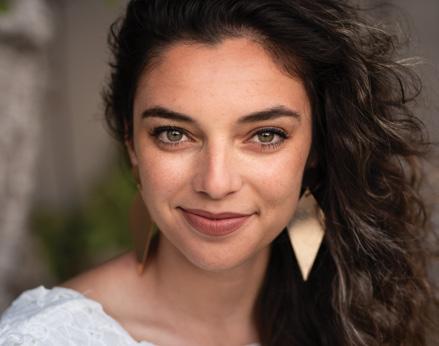
instagram: millielou99
PETER SALCIDO
Peter is a Silicon Valley native who influences the space around him through his expression of style and ambiance. He is a fashion editorial photographer, blogger and content creator.
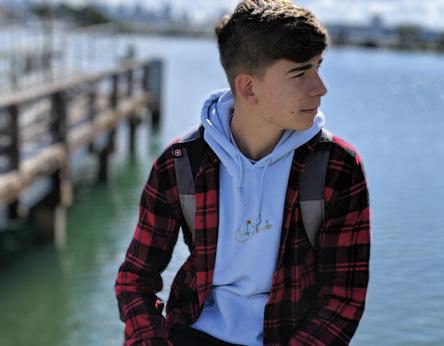
instagram: peter_salcido
DIANE
Diane is a San Jose neighborhoodie and culture vulture. She’s a Radio KKUP producer and host, and she volunteers for History San Jose, the Silicon Valley Bicycle Coalition, San Jose Bike Party, and SURJ-SJ.
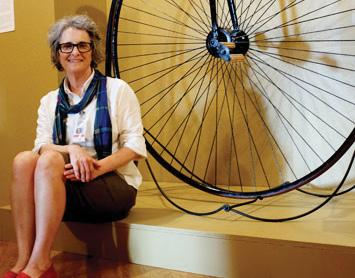
instagram: postcardsfromsiliconvalley
BRANDON ROOS
Brandon is 408 born and raised. He has covered music and local arts for nearly a decade. When not writing, he dreams up ideas for new mixes and accumulates too much vinyl.

Instagram: brandiathan
JOHN AGCAOILI
John has always challenged himself and his peers in becoming not only better artists, but better individuals. He actively participates and produces communitybased collaborations for the arts, has been published at an international level, and is cofounder of the creative team DSOTM.
Instagram: john.aeric
DANA HARRIS SEEGER
Dana is a painter, printmaker, educator and the 2020 Santa Clara County Artist Laureate. She co-created and runs the School of Visual Philosophy and loves experimenting with the latest interactive technology in her artwork.

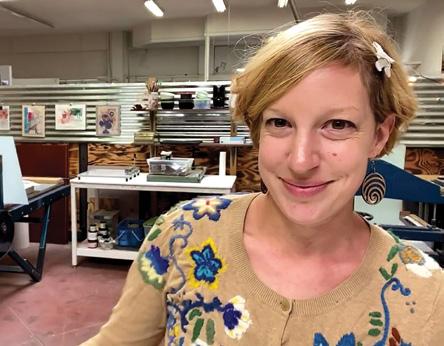
instagram: danaharrisseeger
Jesse is a graphic design major currently attending West Valley College. And, a soccer fanatic.
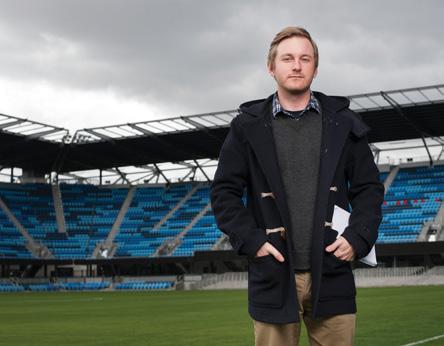
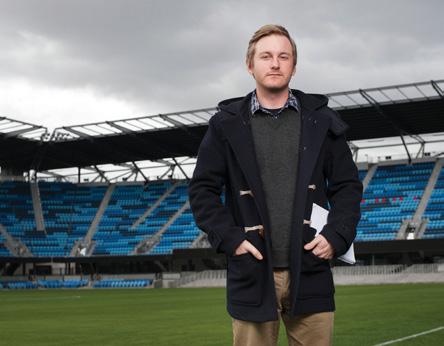
instagram: jessesg
Yori views the world as a sculptor. Born in Mount Shasta, he is a craftsman, blacksmith and educator working at the School of Visual Philosophy, which he co-created and currently lives in the Santa Cruz Mountains.
instagram: yoriseeger
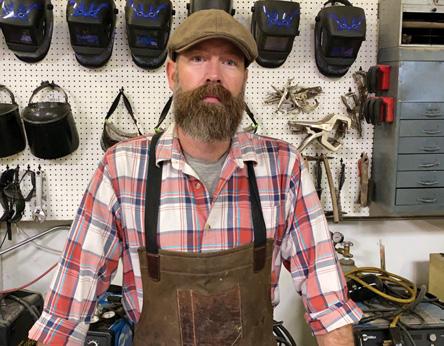
SEEK 10.0 72
C
SOLOMON
YORI SEEGER
JESSE GARCIA
72 Discover 13.1
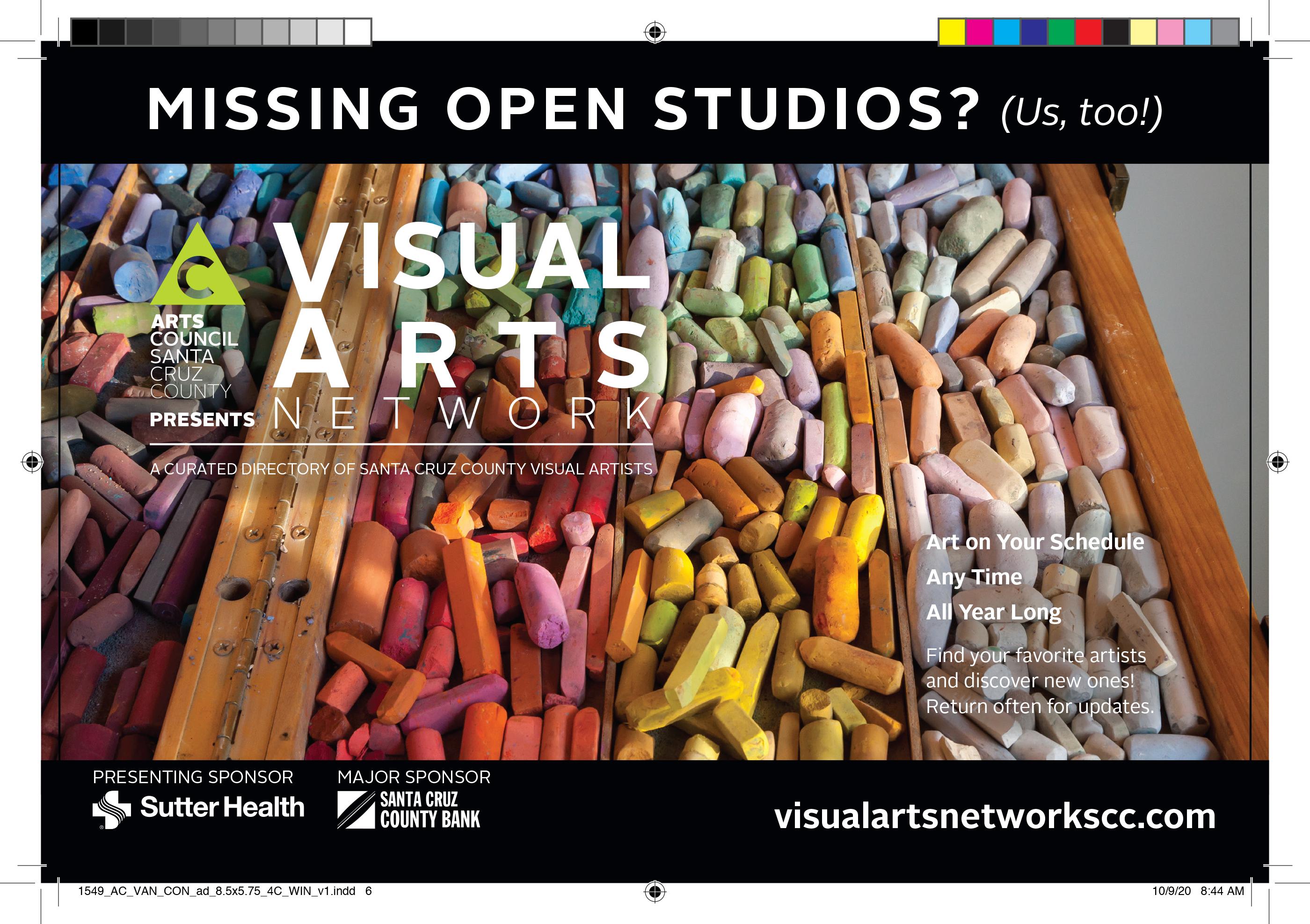
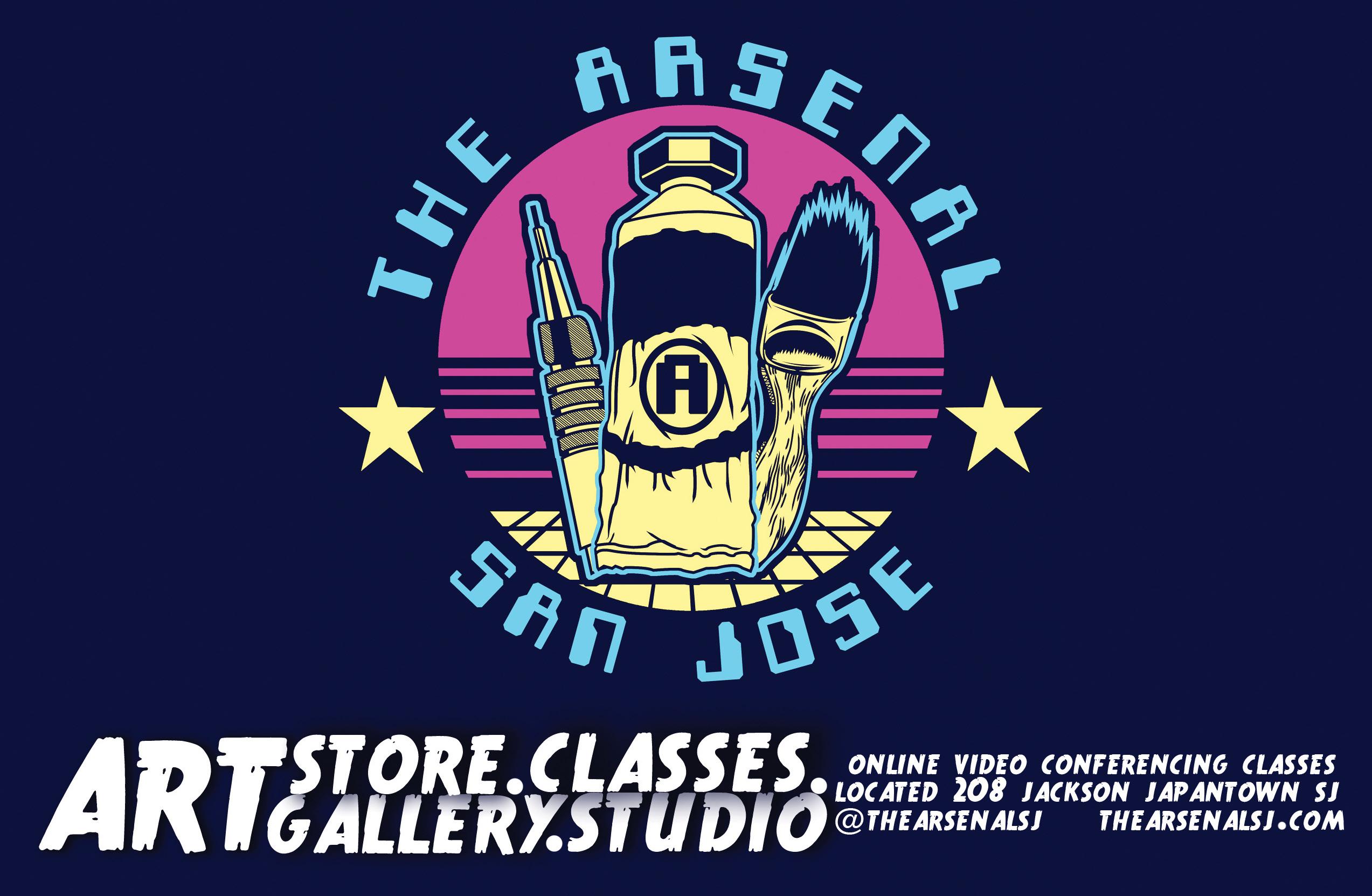








©Technology Credit Union. All rights reserved. Federally insured by NCUA. Use Online and Mobile Banking to: • Access accounts • Pay bills • Transfer money • Deposit checks • Monitor credit • And more! To learn more: CALL: (800) 553-0880 CLICK: techcu.com These days we’re doing more from home — with Online and Mobile Banking, it’s easy, convenient and free! @TechCU @TechCU techcu Stay connected... Get your banking done without leaving your couch ©Technology Credit Union. All rights reserved. Federally insured by NCUA. Use Online and Mobile Banking to: • Access accounts • Pay bills • Transfer money • Deposit checks • Monitor credit • And more! To learn more: CALL: (800) 553-0880 CLICK: techcu.com These days we’re doing more from home — with Online and Mobile Banking, it’s easy, convenient and free! @TechCU @TechCU techcu Stay connected...





Conversations with Silicon Valley‘s Creatives PODCAST bit.ly/TheContentPodcast

NEXT ISSUE Sight and Sound 13.2 Next Pick-Up Party Depending upon County Health Ordinances SAN JOSE 2020 WWW.CONTENT-MAGAZINE.COM social media: contentmag ANNUAL MEMBERSHIP- $42.00 SINGLE ISSUE- $14.95 SUPPORT www.content-magazine.com SILICON VALLEY’S INNOVATIVE & CREATIVE CULTURE made in san jose, ca
























 Written by Nathan Zanon
Photography by Sannie Caleridad isaacslewin.com Instagram isaacslewin
Written by Nathan Zanon
Photography by Sannie Caleridad isaacslewin.com Instagram isaacslewin





































 “Black Minimalism Bookshelf”
“White Bookshelf”
“Black Minimalism Bookshelf”
“White Bookshelf”




 Above pieces are from a series that depicts an intimate morning scene of individuals eating their breakfast while wearing their favorite band shirts.
Clockwise:
Above pieces are from a series that depicts an intimate morning scene of individuals eating their breakfast while wearing their favorite band shirts.
Clockwise:




 Pants - Liellede Transiit, $45
Pants - Liellede Transiit, $45
 Pants - Stacked Roses, $60
Pants - Stacked Roses, $60
 Sweatshirt- P1 V.S. P2, $80 Pants- The Sultan, $80
Sweatshirt- P1 V.S. P2, $80 Pants- The Sultan, $80






 –Julia Bozzo
–Julia Bozzo































